COSTA RICA 25 February – 25 April, 2021 Callyn Yorke

Link to COSTA RICA, AUTUMN 2021 (September 1- November 28, 2021) Callyn Yorke
TABLE OF CONTENTS (scroll down for location entries)
- Hacienda Guachipelin, Guanacaste 25 February – 1 March, 2021
- Arenal Observatory, Alajuela 1 – 4 March, 2021
- Laguna del Lagarto Lodge, Boca Tapada, Alajuela 4 – 15 March, 2021
- Samara, Guanacaste 15 – 29 March, 2021
- Santa Elena, Puntarenas 30 March – 12 April, 2021
- Escazu, San Jose 12-13 April, 2021
- Danta Corcovado, Peninsula de Osa, Puntarenas 15 – 20 April, 2021
- Playa Tamarindo, Guanacaste 20 – 25 April, 2021
Introduction
Due to the paucity of tourists during the Covid-19 pandemic, most of the lodges I visited were largely vacant, quiet and, whether surrounded by forests, fields, rivers or shorelines, often teeming with wildlife. Several life birds were added to my list, which by itself would have made the two-month excursion worthwhile. Enjoying quality time with my Tico friends, some of whom I had met here during my first tour twenty-four years earlier, was a special treat. And most unexpected was the opportunity to spend several days in the field with one of the world’s premier wildlife photographers, Marek Jackowski.
My photographic equipment consisted primarily of a Nikon D850 fitted with a Nikon 200-500mm lens. A Google Pixel 3 XL cell phone was used for scenery and a few close-up photos. Nighttime bat photography required a Nikon 70-200 mm lens synchronized with high speed strobe lights.
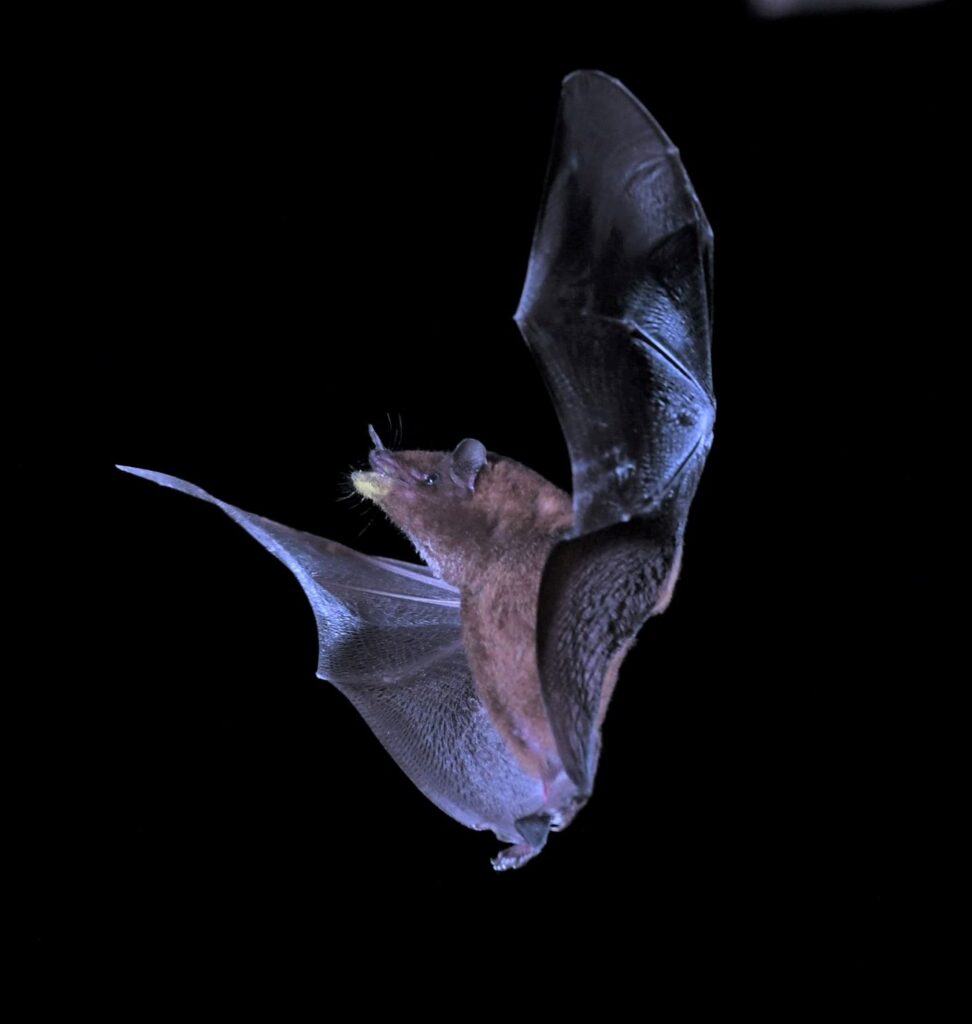
The overland journey included visits ranging from three days to two weeks in areas with which I was very familiar, e.g. Laguna del Lagarto Lodge in northeastern Costa Rica, and places totally unfamiliar, e.g. the Osa Peninsula. My objectives included observing and photographing as much of the wildlife (primarily birds) as possible at locations differing in topography and ecological associations. The results are presented based on entries in my daily field journal, selected photographs and artwork. An annotated list of the birds I found at each of eight operational areas is included.
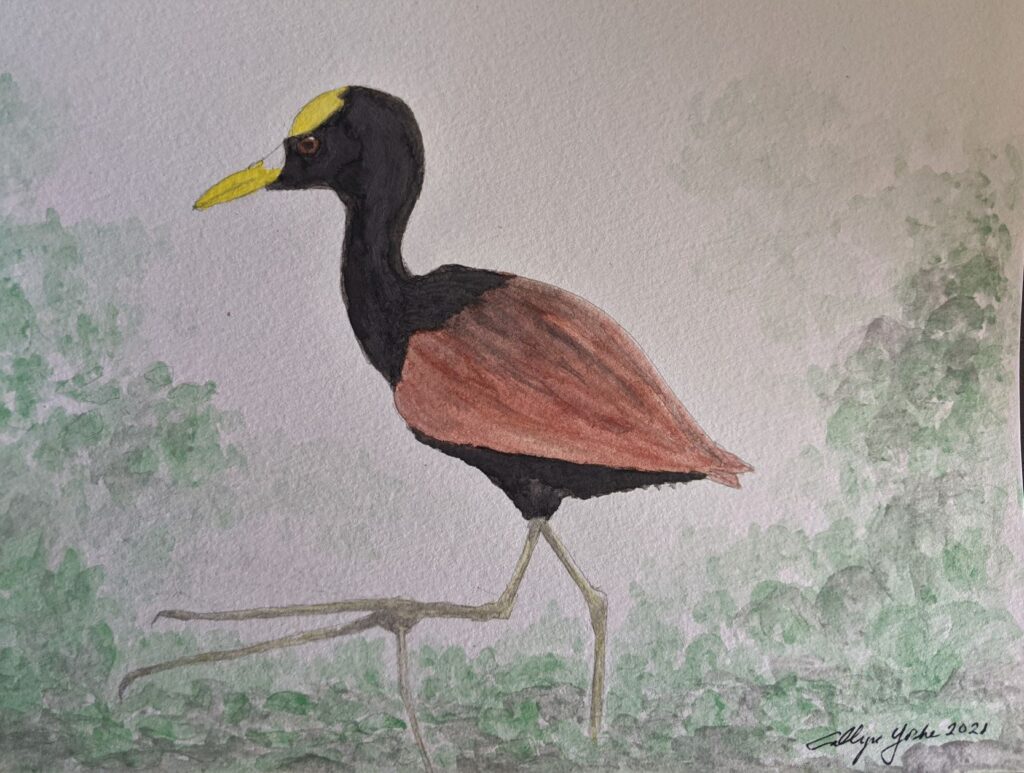
Hacienda Guachipelin, Guanacaste (HG), Elevation 530 m, 25 February – 1 March 2021
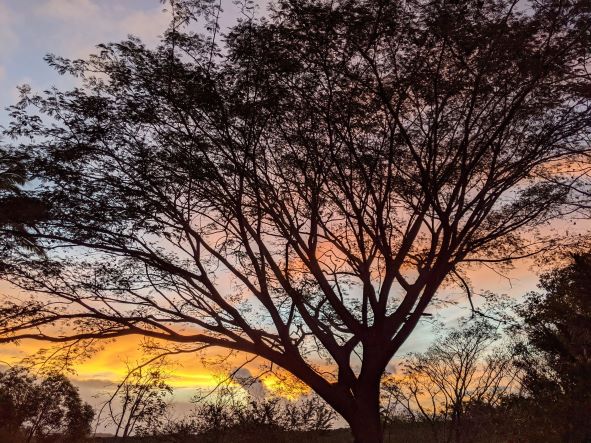
Following a routine 5.5-hour nonstop flight from Los Angeles, CA to Liberia, CR, I obtained a rental vehicle (2019 Toyota Landcruiser) and drove in the dark on largely unsigned roads, reaching Hacienda Guachipelin around 9 pm local time. The lodge staff and facilities were excellent. I checked into a clean, spacious room (#61) with a ceiling fan, double bed, chairs, desk and private bath.

I spent the next five days walking roadways and trails around the lodge, mostly alone. The terrain was hilly, dominated by pastureland, small farms, gardens and patches of subtropical, seasonal forest, overlooking the Pacific Ocean about 20 km to the west. Weather during my visit was predominantly overcast, breezy (winds 5 – 40 kph) with occasional intermittent light rain; air temperatures ranged between 20 and 24C.
Birding the lodge grounds and roadways was fairly productive early in the morning and progressively challenging as winds picked up by around 1000 hrs.
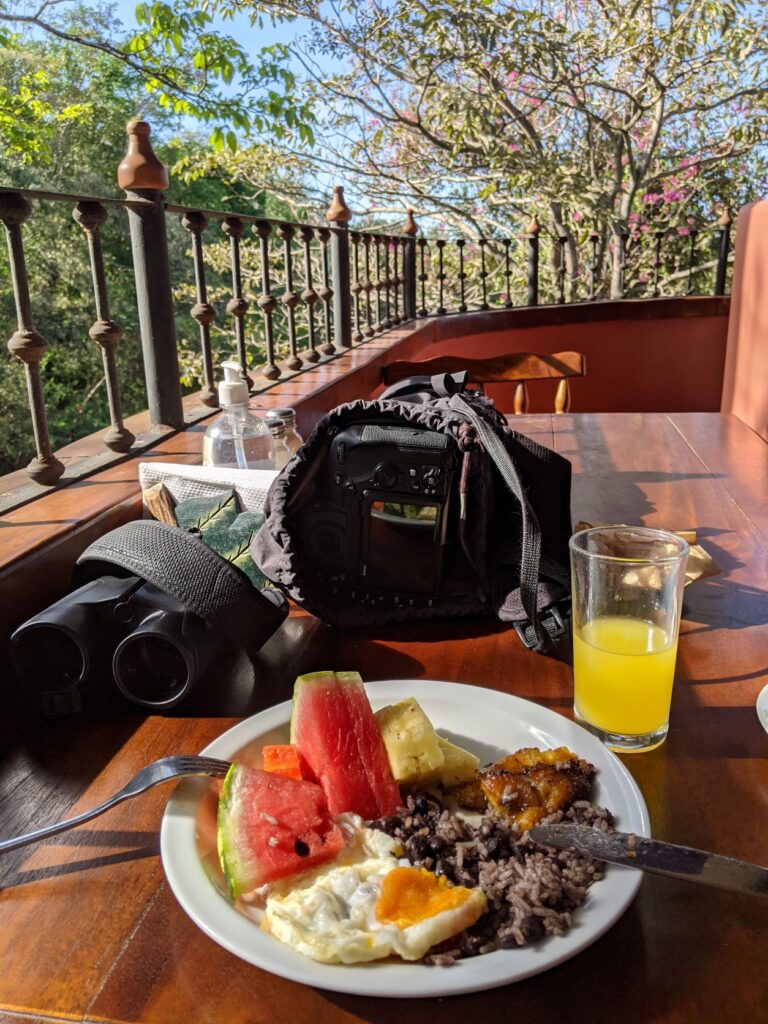
Breakfast and Lunch were served on an open patio overlooking the garden, which was convenient for observing the common resident birds (photo).
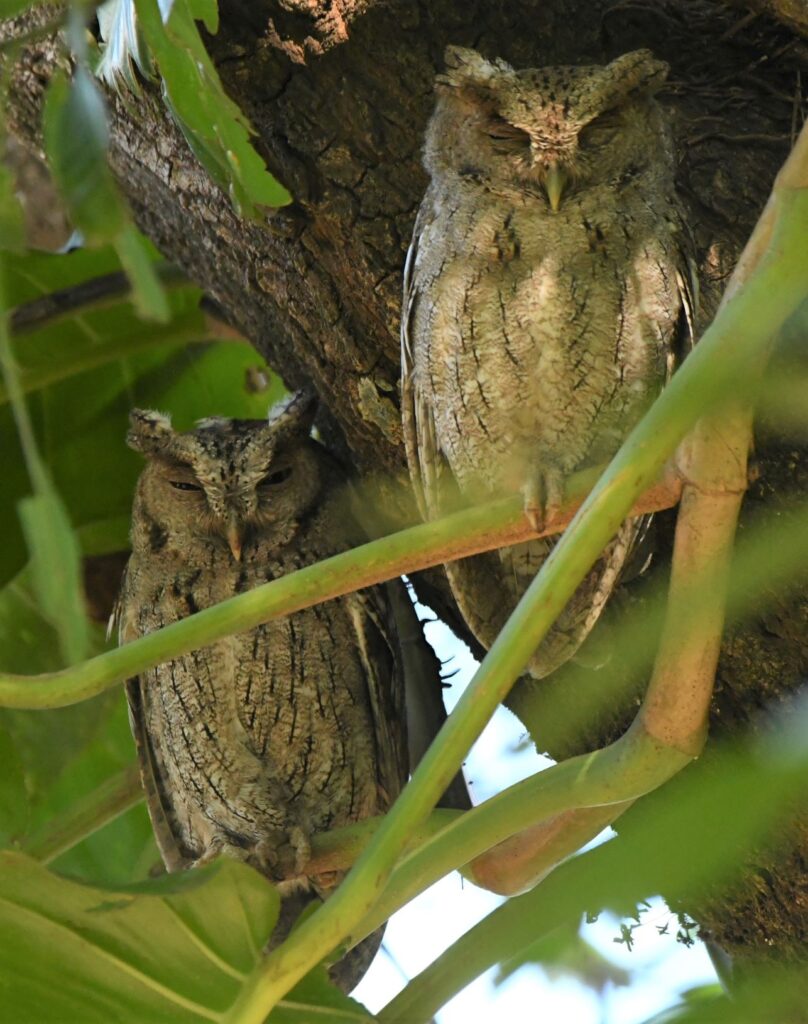
Highlights included a pair of Red-billed Pigeon constructing a nest of twigs, a small flock of White-fronted Parrot vocalizing in the tree canopy, a fairly approachable Black-headed Trogon (photo) and Turquoise-browed Motmot sallying from a low perch to the ground. A security guard alerted me to a Pacific Screech Owl pair that could be seen daily, resting in a large tree near the lodge entrance (photo).
One afternoon (1520 1700 hrs.) I completed a round-trip 3 km walk from the lodge down the main entrance road and along a rocky trail, sloping gradually through a series of horse and cattle pastures leading to the Chorerras – a series of rather modest waterfalls in a swift flowing stream. The trail coming off the main road went through a dry oak forest with patches of tall grass.

Birds found along this route included Orange-fronted Parakeet, Crested Caracara in a pig pen with several Black Vultures, and a highly active Gray-crowned Yellowthroat. Otherwise, there was little birdlife evident and most of the species found could be seen elsewhere around the lodge with comparatively little effort.
I visited the more distant Oropendola Waterfall, located several more kilometers west of HG on the morning of my departure for Volcan Arenal. This side trip involved a short hike from a parking area along the rim of a
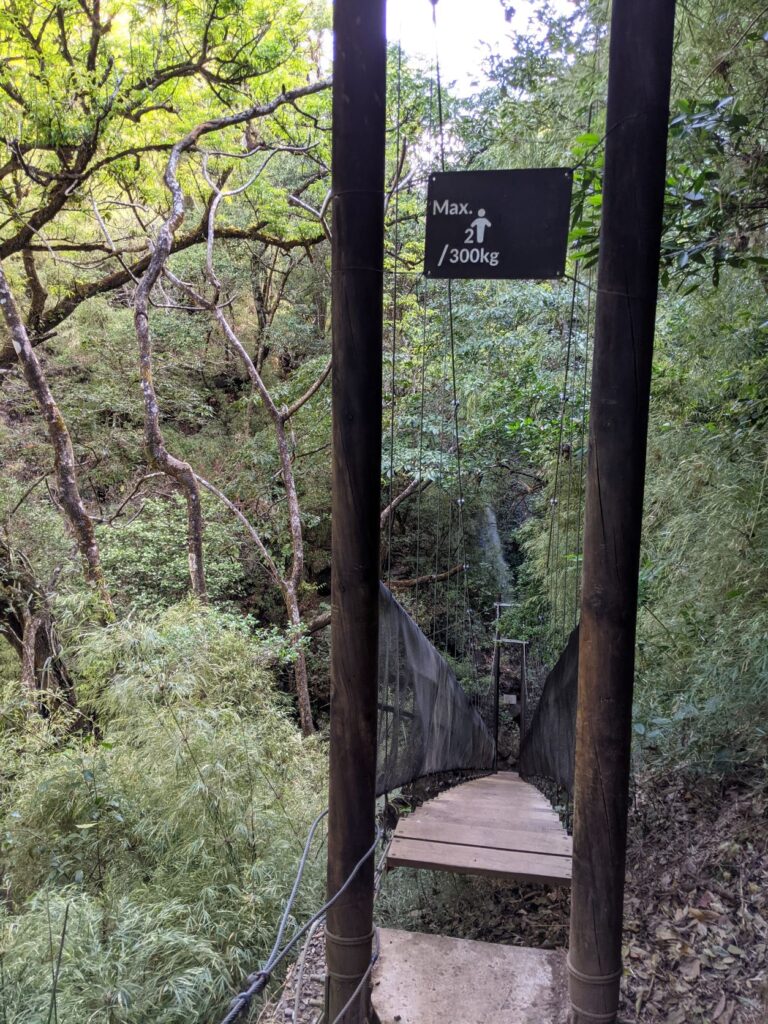
deep, forested canyon, terminating at a steep suspension bridge leading to the base of a 20 m cliff with a stream of water splashing noisily into a shady pool. Although the forest appeared to be mature and undisturbed by logging and encroachment, high winds were thrashing the trees so violently, that if there were any birds in the area, it was nearly impossible to see them.
Hacienda Guachipelin (HG) Annotated Bird List (25 February – 1 March, 2021) Callyn Yorke
Explanation of Symbols
Abundance: Numbers following each species represent the maximum number of individuals found during a survey.
Frequency: C = Commonly found during all or most surveys; FC = Fairly commonly found on about half of the surveys; UC = Uncommonly found less in than half of the surveys; R = Rarely found; i.e. only once during the surveys (Note: some areas, e.g. Chorreras, were surveyed only once).
Systematics and Nomenclature follows Avibase and Clements (2021)
- Plain Chachalaca Ortalis vetula 1 vocal (unseen) R
- Red-billed Pigeon Patagioenas flavirostris 12 gregarious; in flocks; a pair with twig nest material in a large tree, C
- Inca Dove Columbina inca 2 on utility line, UC
- Gray-chested Dove Leptotila cassinii 1 walking on forest floor, R
- White-winged Dove Zenaida asiatica 12 vocal, gregarious (mostly paired), C
- Lesser Ground-Cuckoo Morococcyx erythropygius 1 vocal (unseen) R
- Squirrel Cuckoo Piaya cayana 2 active in canopy and subcanopy of large trees, FC (photo).
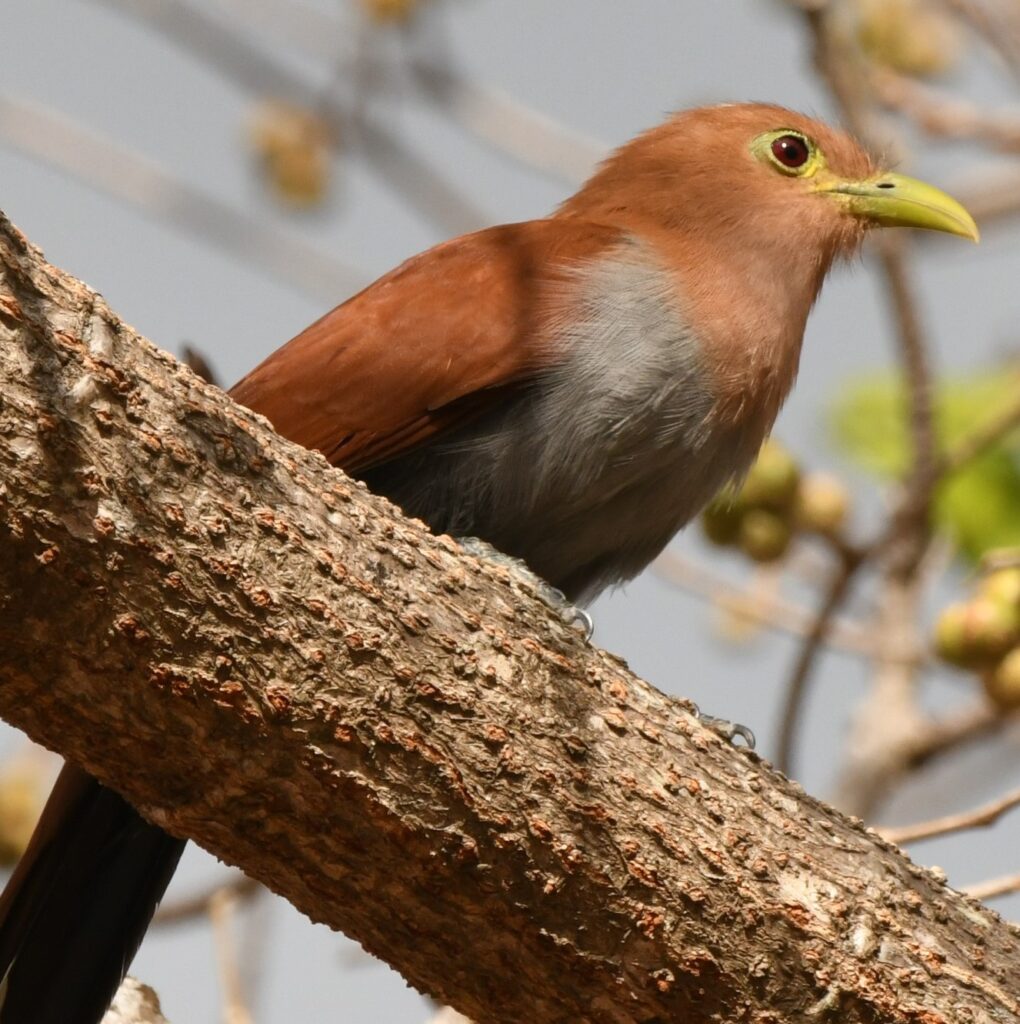
- Common Pauraque Nyctidromus albicollis 1 active at dawn on ground in parking area, FC
- White-collared Swift Streptoprocne zonaris 50 gregarious, a cohesive flock at 30-60 m height over forest and pastureland, R
- Lesser Swallow-tailed Swift Panyptila cayennensis 1 flying low over lodge and hilltop at 1720 hrs. R
- Blue-vented Hummingbird Saucerottia hoffmannii 1 (m) in subcanopy of shady forest, R
- Rufous-tailed Hummingbird Amazilia tzacatl 2 foraging on red flowering shrubs in garden, FC
- Black Vulture Coragyps atratus 6 gregarious, in flight over pastures, on ground in pig pen, C
- Turkey Vulture Cathartes aura 6 gregarious in flight 30-60m over pasture and forest, C
- Gray Hawk Buteo plagiatus 1 flew to perch in the canopy of a tree next to open pasture, R (photo).
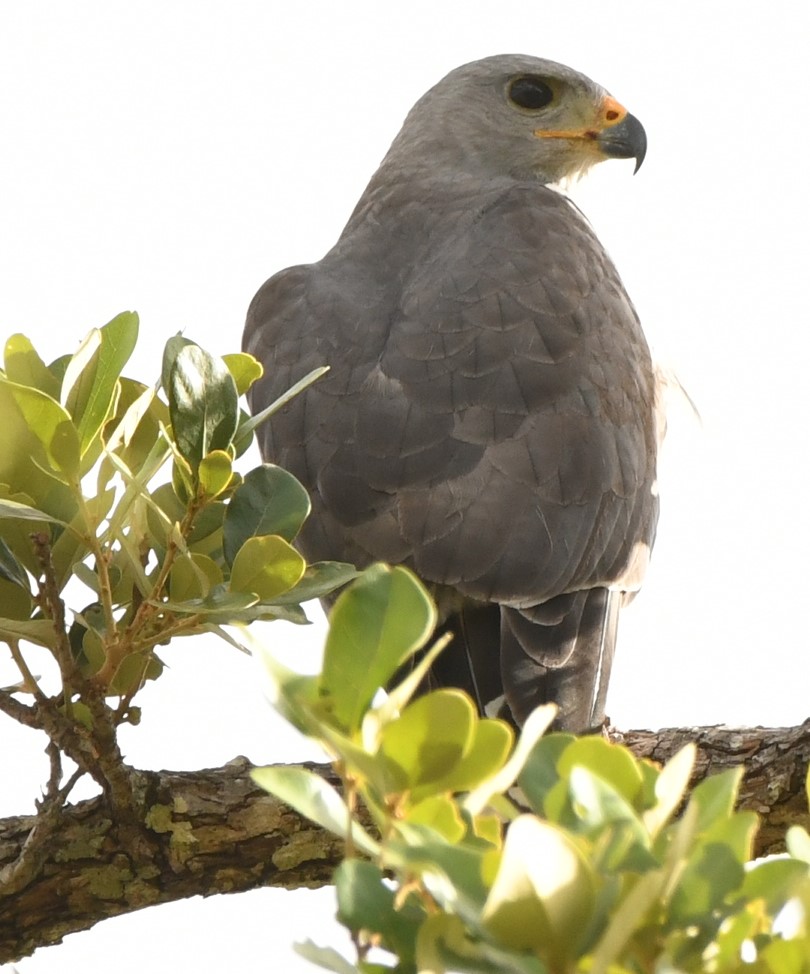
- Pacific Screech Owl Megascops cooperi 2 individuals and pairs roosting in trees near the lodge entrance, C (photo).
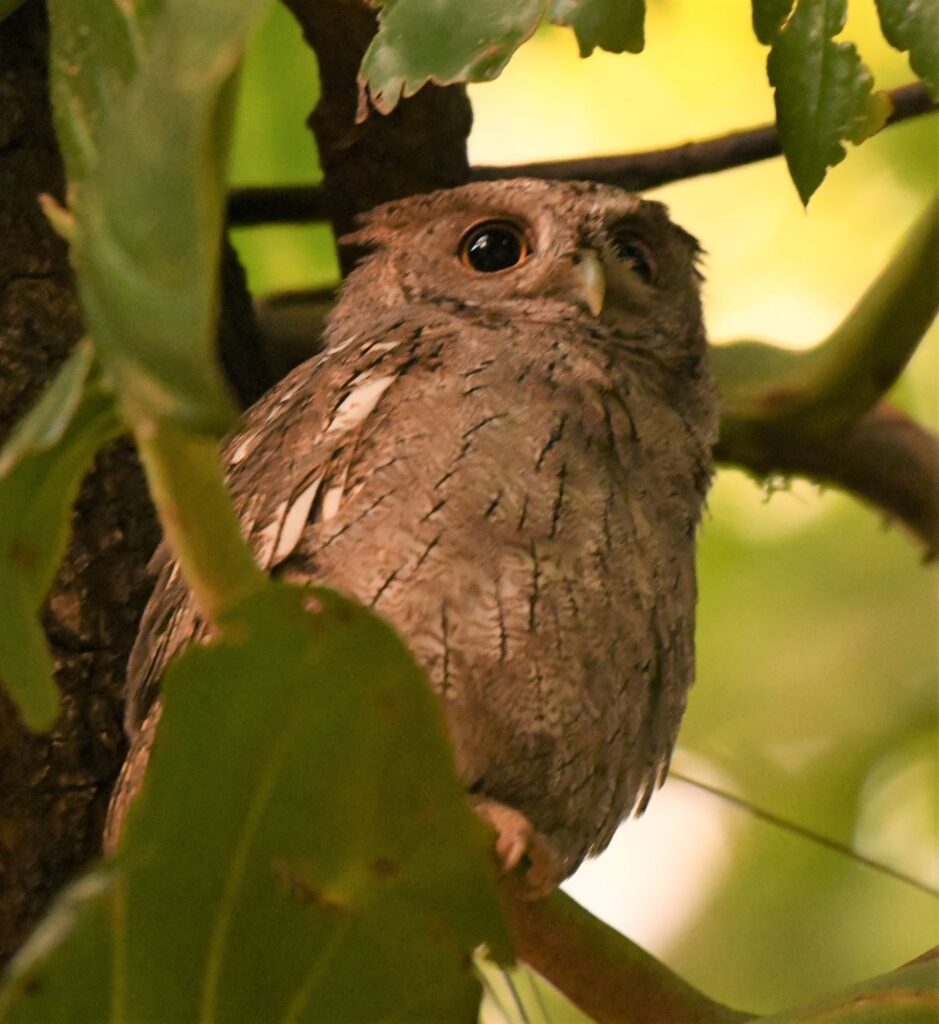
- Black-headed Trogon Trogon melanocephalus 1 perched quietly in the lower mid-level of woodland edge near the lodge, FC (photo).
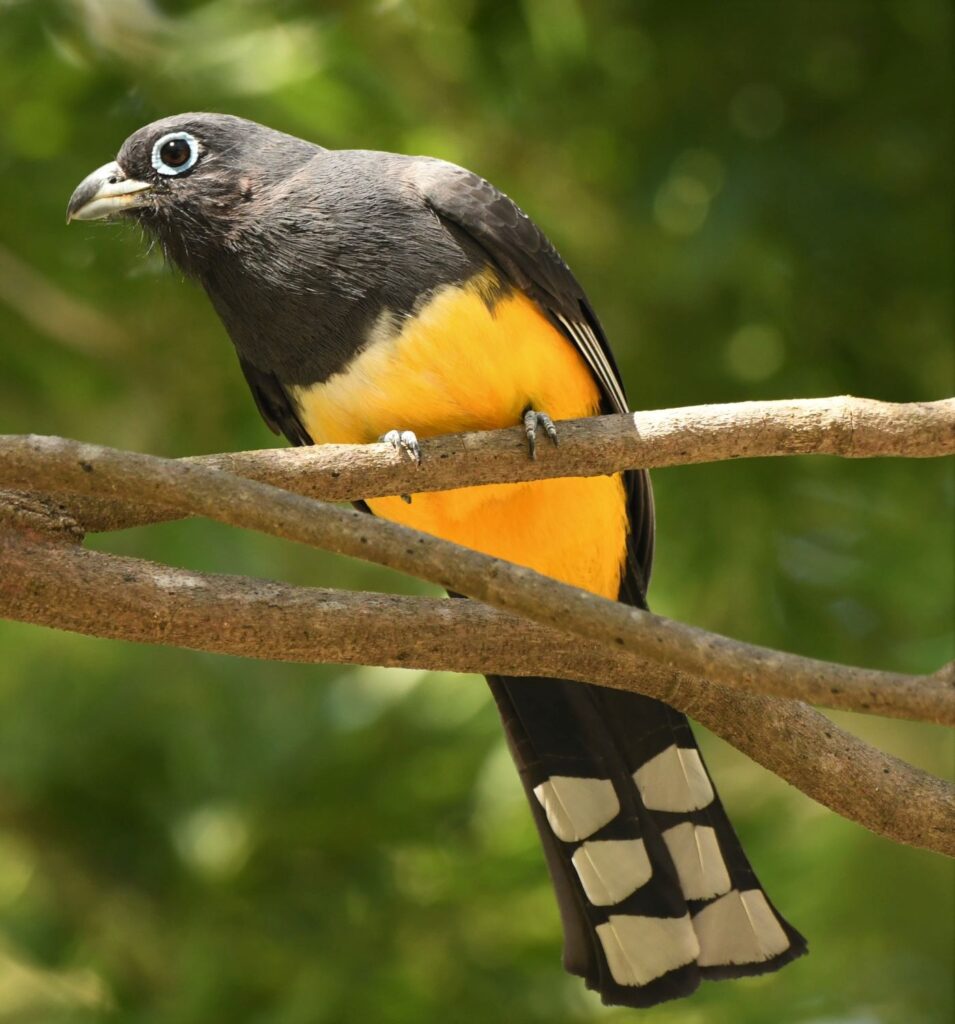
Turquoise-browed Motmot Eumomota superciliosa 2 sallying to ground from low perch in shrub, FC (photo).
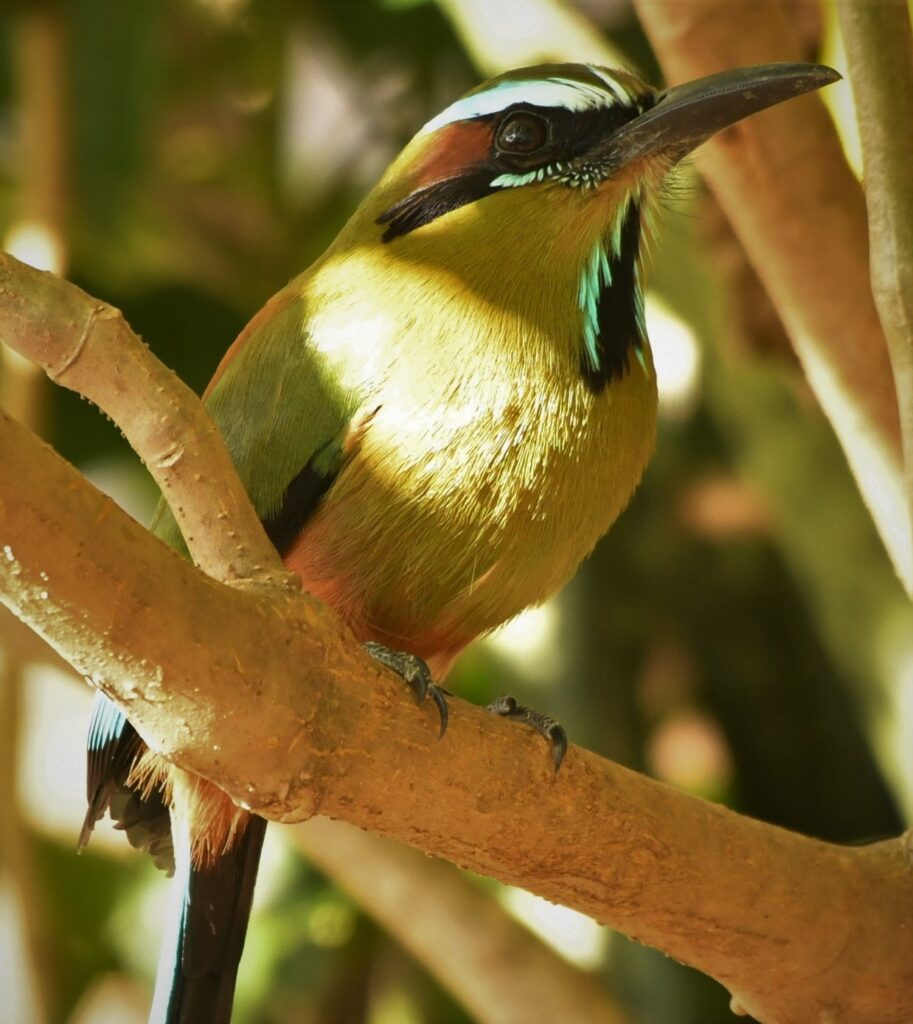
- Keel-billed Toucan Ramphastos sulfuratus 1 vocal (unseen) trail near the lodge, R
- Hoffmann’s Woodpecker Melanerpes hoffmanni 8 vocal, loosely gregarious in large trees, C (photo).
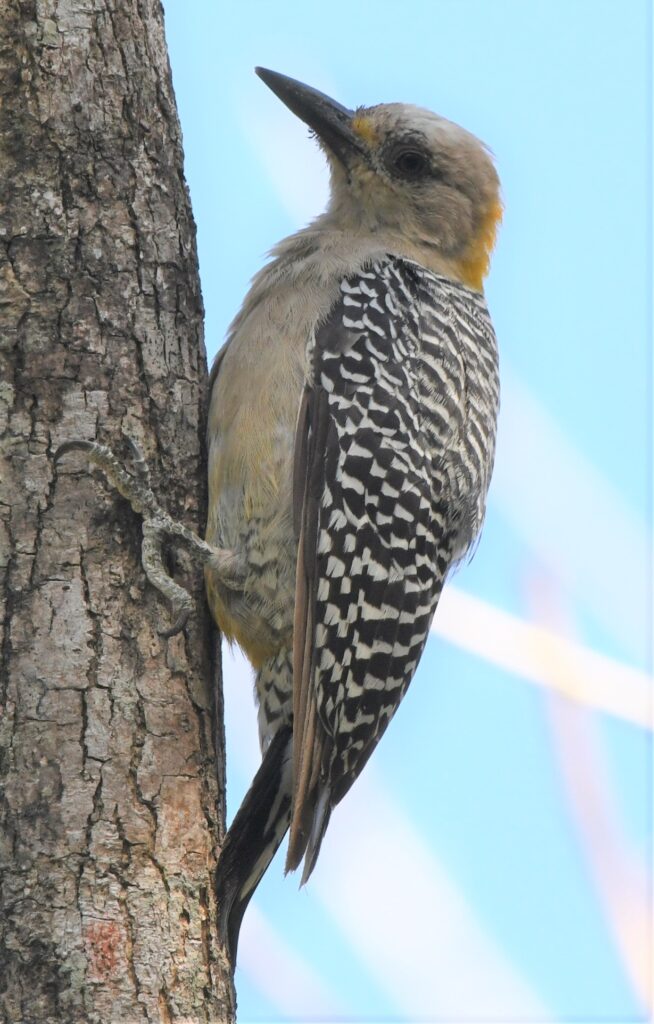
- Crested Caracara Caracara plancus 2 sometimes on the ground and associated with BLVU; one in low tree being scolded and harassed by a flock of WTMJ, C (photo).
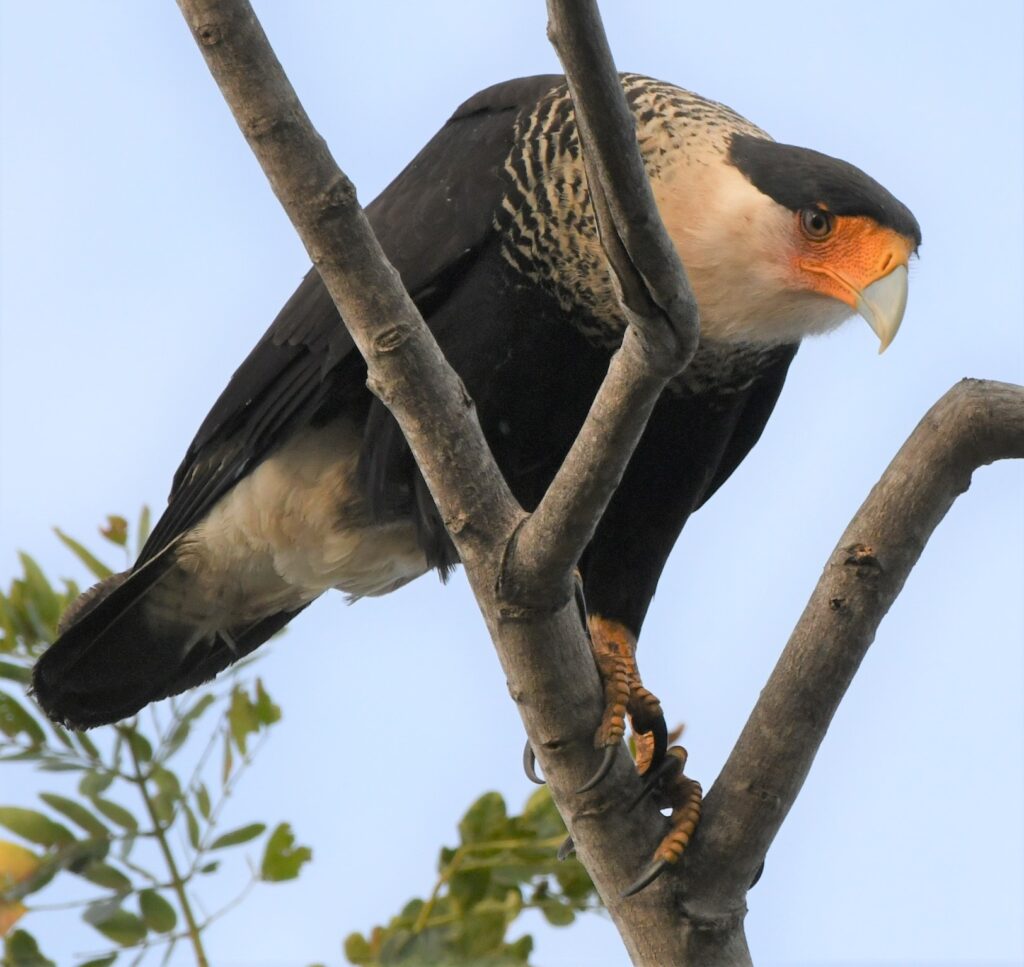
- Red-lored Parrot Amazona autumnalis 2 a pair in the canopy of a tall tree near the lodge, UC (photo).
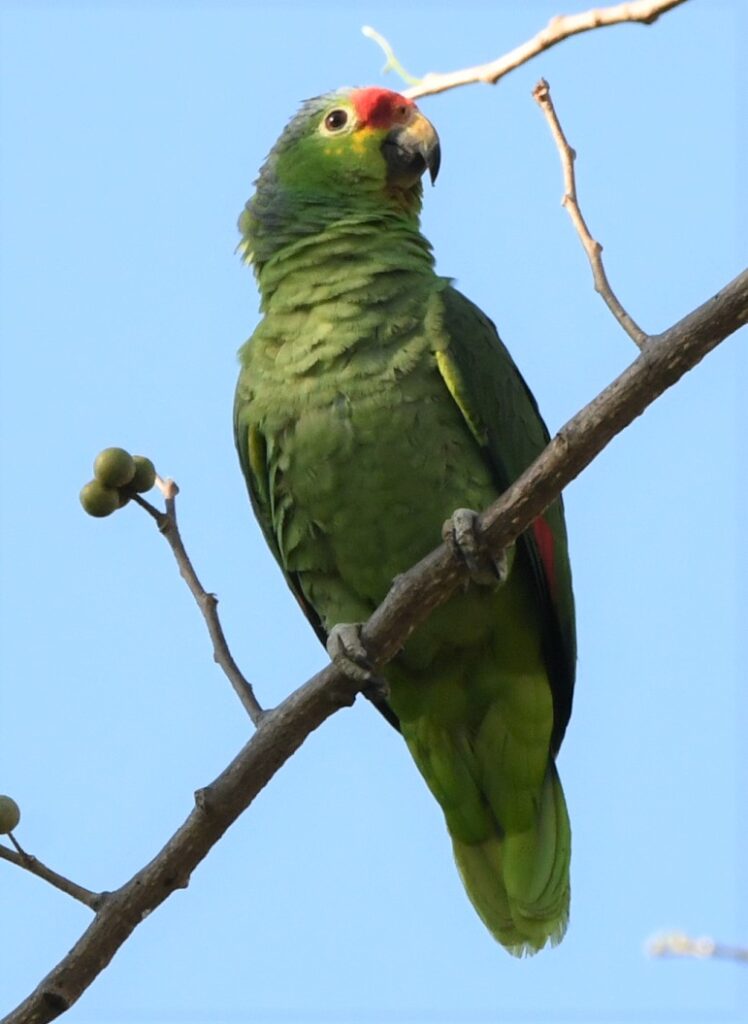
- White-fronted Parrot Amazona albifrons 10 vocal, gregarious, feeding on clusters of small green fruits in tall trees around the lodge, FC (photo).
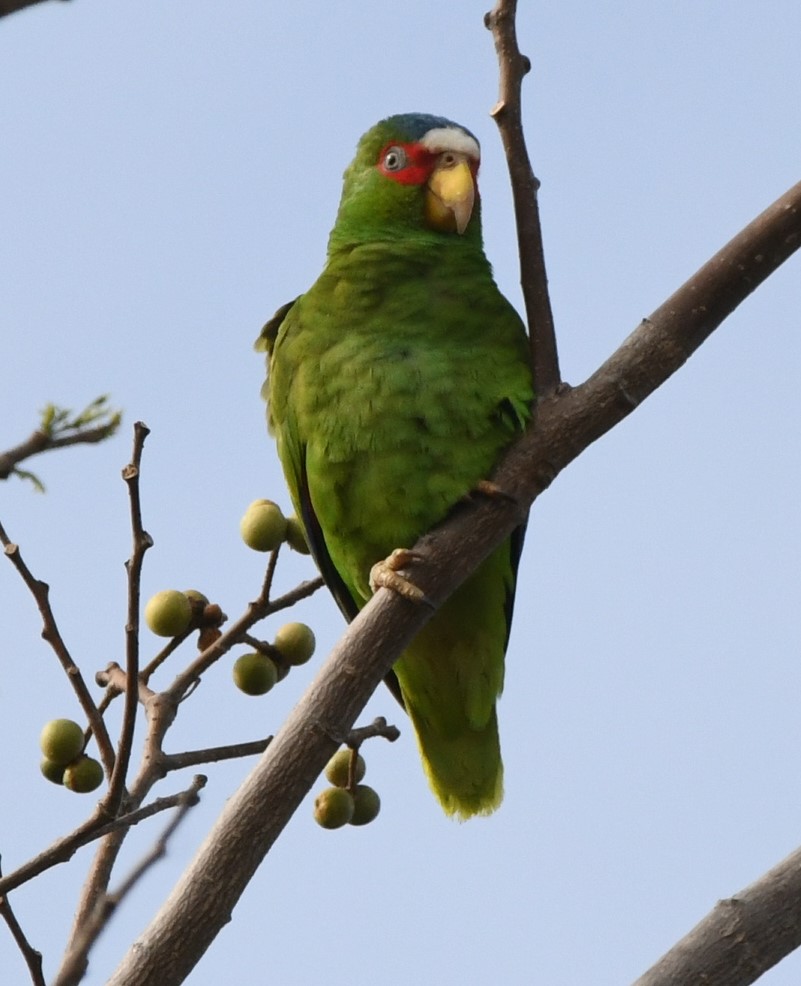
- Orange-fronted Parakeet Eupsittula canicularis 18 vocal, highly gregarious, often seen in flight, FC (photo).
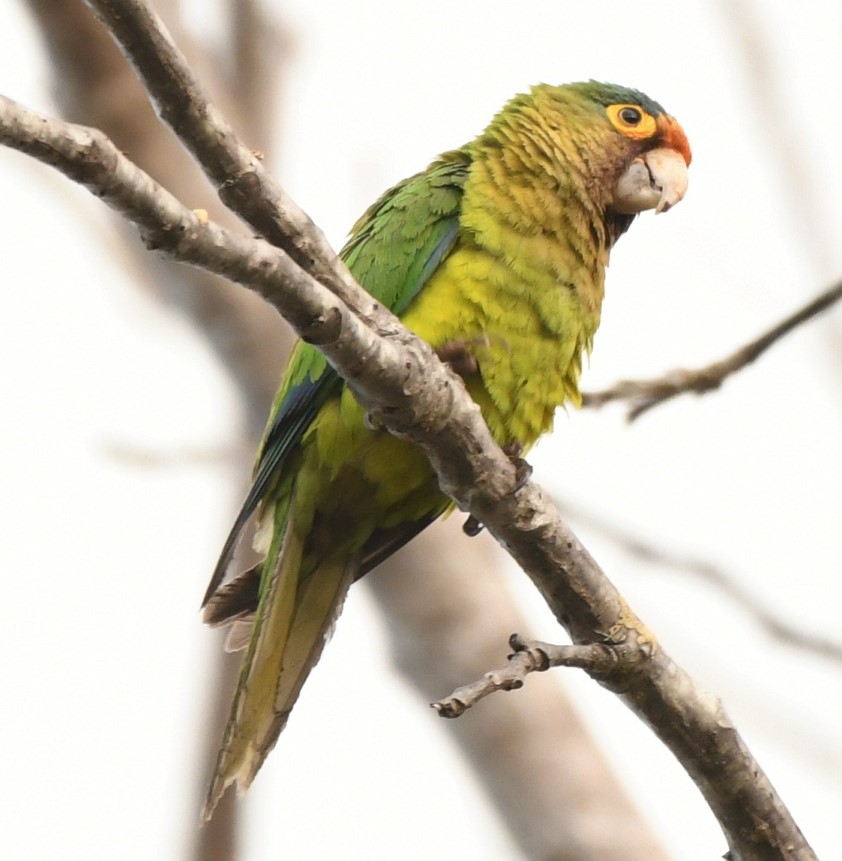
- Masked Tityra Tityra semifasciata 1 vocal in garden trees around lodge and trail near lodge, UC
- Rose-throated Becard Pachyramphus aglaiae 1 sallying from lower middle level of a large tree, R
- Brown-capped Tyrannulet Ornithion brunneicapillum 1 appearing briefly in the forest understory along the Oropendola Waterfall trail, R
- Brown-crested Flycatcher Myiarchus tyrannulus 2 a pair evidently engaged in courtship and nesting activities near the lodge, FC
- Great Kiskadee Pitangus sulphuratus 4 nesting in a small tree next to a busy parking lot, C
- Social Flycatcher Myiozetetes similis 2 a pair in the subcanopy of a large tree near the lodge, FC
- Tropical Kingbird Tyrannus melancholicus 2 on a roadside utility wire, FC
- Scissor-tailed Flycatcher Tyrannus forficatus 1 on a tree-top perch, R
- Vireo sp. 1 seen briefly in canopy of tall tree next to the lodge, R
- White-throated Magpie-Jay Calocitta formosa 4 gregarious, vocal in and around gardens with tall trees, C
- Barn Swallow Hirundo rustica 1 flying low over hilltop roadway, FC
- Rufous-naped Wren Campylorhynchus rufinucha 6 vocal, gregarious, active in and around gardens and roadside shrubs, C
- Clay-colored Thrush Turdus grayi 2 in and around gardens, C
- Yellow-throated Euphonia Euphonia hirundinacea 2 (m,f) a pair in the upper middle level of a large tree, UC (photo).
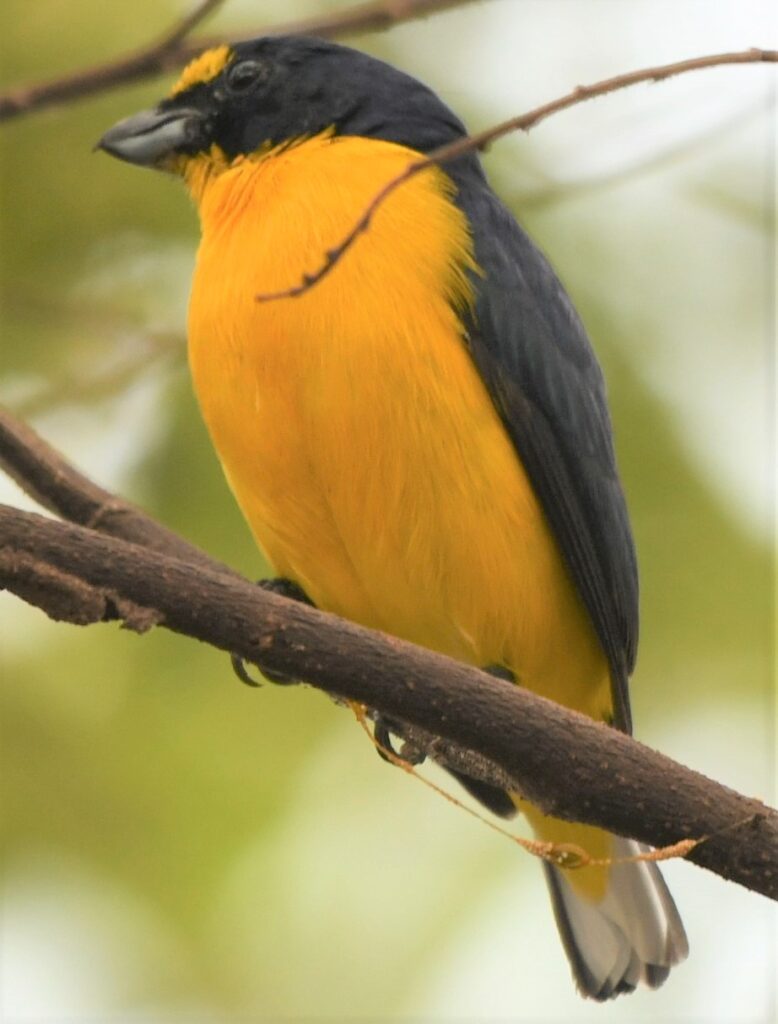
- Stripe-headed Sparrow Peucaea ruficauda 2 retreating to shrubs when approached in a tall grassy area, UC
- Montezuma Oropendola Psarocolius montezuma 6 vocal, gregarious in large trees around the lodge, C
- Baltimore Oriole Icterus galbula 2 foraging on flowers in the garden, C
- Melodius Blackbird Dives dives 2 in and around gardens, UC
- Great-tailed Grackle Quiscalus mexicanus 6 ocal, gregarious in gardens, C
- Yellow Warbler Setophaga petechia 1 (m) in trees at edge of trail near lodge, FC
- Western Tanager Piranga ludoviciana 1 (imm. m) in trailside trees near lodge, R
- Blue-gray Tanager Thraupis episcopus 2 a pair in a large tree canopy next to the lodge, UC
Arenal Observatory Lodge, Alajuela, Elevation 780 m, 1 – 4 March, 2021
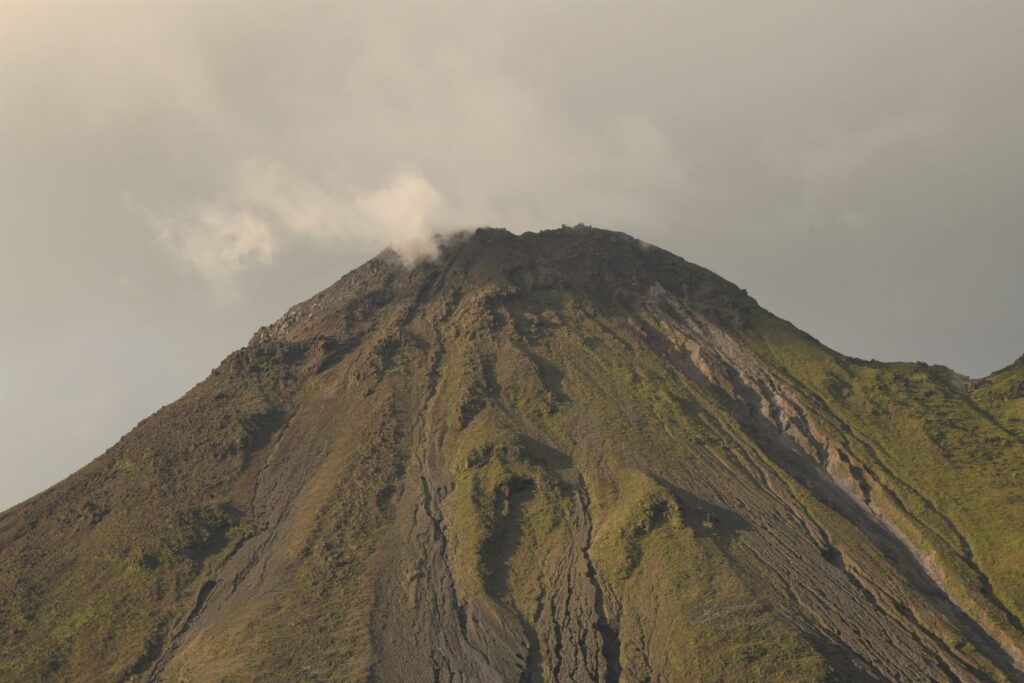
Driving in Costa Rica almost certainly guarantees an adventure, as I have described ad nauseatum in multiple previous reports. No worries. I fully expected to be wonderously lost and was rarely disappointed. The route from HG to the Arenal Observatory Lodge involved a series unmarked junctions (e.g. HWY 1 & HWY 142), sometimes resulting in driving several kilometers on the wrong compass heading and having to double back in search of the correct way. The Garmin GPS unit that was cheerfully included with the rental vehicle at no extra charge, was worth about what it cost me: nothing. The problem was two-fold: a) unmarked or ambiguously labeled roads at nearly all key intersections and b) the navigation device refusing to recognize correctly (or incorrectly) spelled destinations that were clearly marked on a well annoted, recently published road map of Costa Rica. After multiple questionable decisions at unmarked intersections, I was somewhat pleasantly surprised to have arrived at the lodge in just under three hours.
The facilities and staff at the Arenal Observatory Lodge were outstanding. I checked into a large room with a balcony practically inside the lower mid-level of the forest.
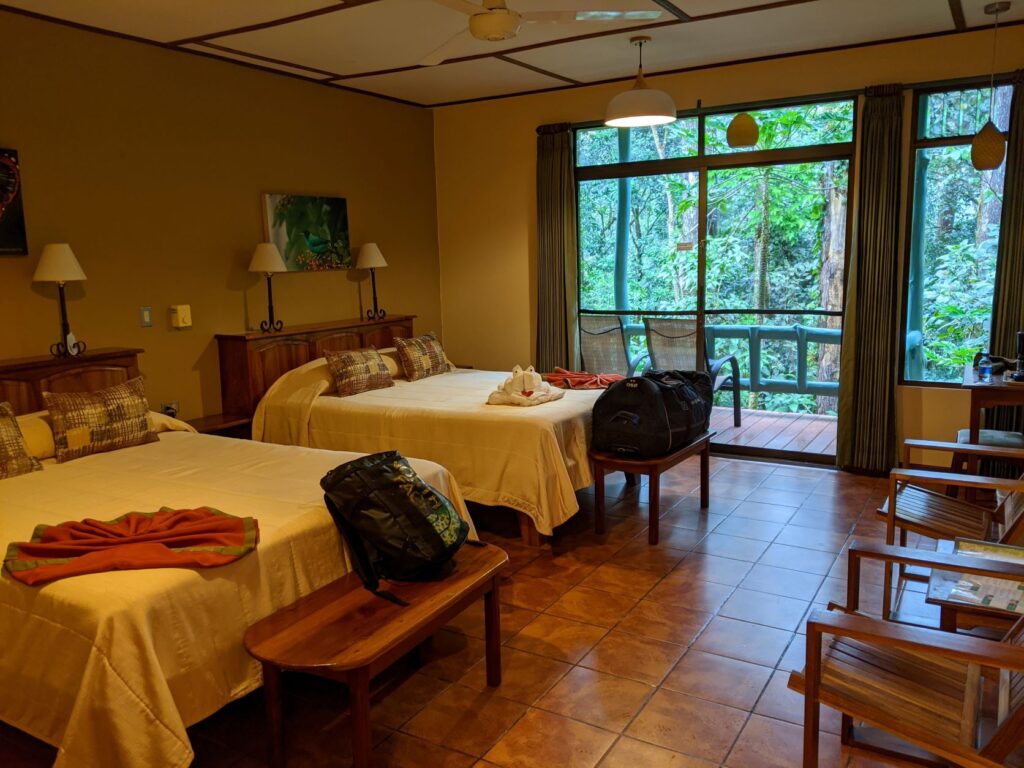
Almost immediately upon my arrival, Zuco, a young Costa Rican Biologist working for the lodge, asked me what particular birds I was interested to see and promised to help me find them. This place was a fairly well known stop on the Costa Rican birding circuit; a tour group that I had met briefly at the Oropendola Falls in HG, arrived at the reception desk just minutes after me.
The tour leader, an attractive young woman named Magdalena, immediately mentioned the observation deck next to the dining room. It was not to be missed. The dining room and deck turned out to be the best place to bird on the lodge property, especially during wet weather, which was frequent during my brief, three-day visit.
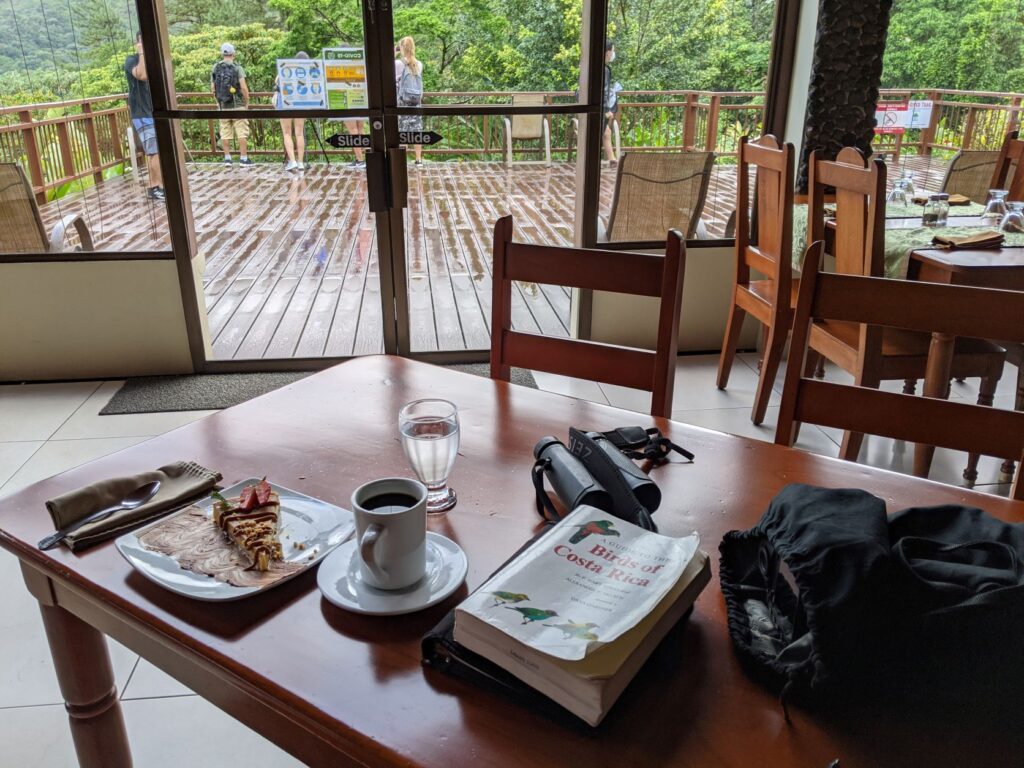
An elevated rope and pulley feeding contraption with skewered fruit for birds, provided entertainment for the lodge guests. Amateur bird photography was justifiably popular here, as the distance between the deck railing and feeder (about 5 m) was convenient for close-up shots. My 200-500m lens was useful here, however the foliage from adjacent trees was too close to produce images with a uniformly blurred pastel background preferred by experienced wildlife photographers. Nevertheless, most of the birds on or near the feeding station were relatively habituated to people and quite cooperative for extended photographic work. Indeed, finishing a meal in the adjacent dining room was often problematic. New birds at the feeder demanded immediate attention.
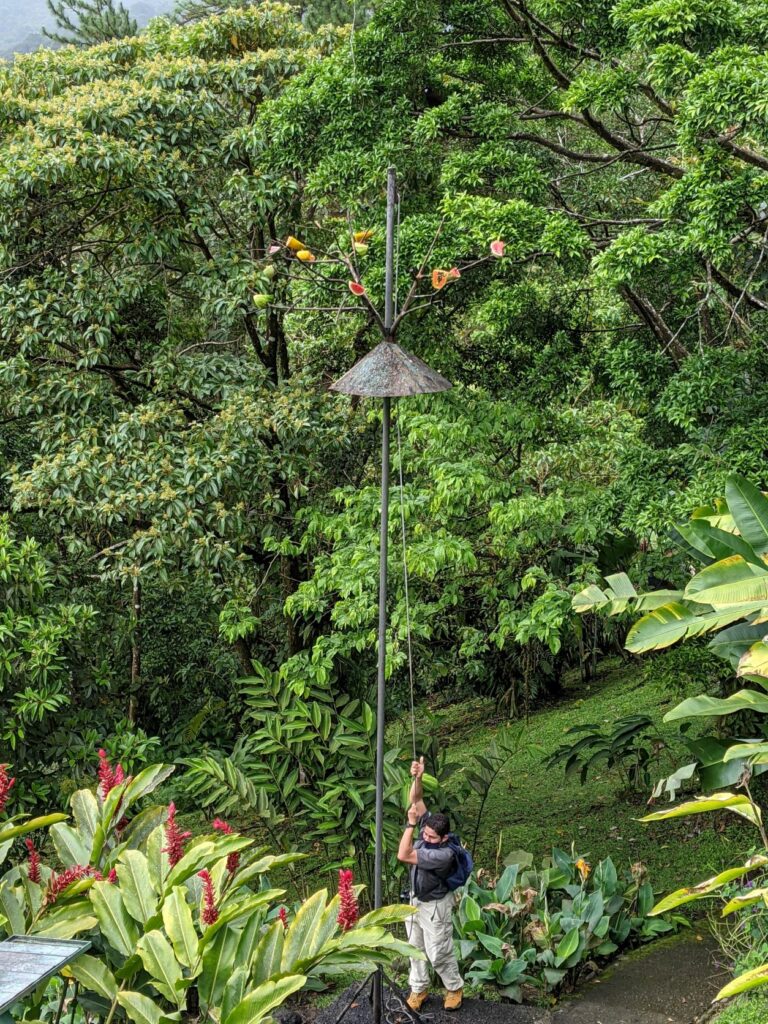
Zuco was duitiful in keeping the bird feeder supplied with fruit, particularly as more lodge guests arrived. A delightful variety of birds frequented the feeder, usually the larger species first, e.g. Crested Guan, Great Curassow and Collared Aracari, followed by a colorful array of tanagers, euphonias, honeyreepers and migratory warblers, e.g. Emerald Tanager, Golden-hooded Tanager, Tawny-capped Euphonia, Yellow crowned Euphonia, Green Honeycreeper, Chestnut-sided Warbler and Black & White Warbler.
A well maintained system of signed trails allowed easy access for birding and photography around the lodge. Further afield, the impressive Danta Waterfall and mature secondary forest was a good area for finding relatively shy forest birds, e.g. Spotted Antbird, a life bird for me. Unfortunately, I was unable to find the relatively secretive Ocellated Antbird, which would have been another lifer.

Arenal Observatory Lodge Annotated Bird List (1 – 4 March, 2021) Callyn Yorke
Abundance: Numbers following each species represent the maximum number of individuals found during a survey. Except for multiple visits to the bird feeder station at the lodge, most areas were surveyed only once (1-4 March, 2021).
Systematics and Nomenclature follows Avibase and Clements (2021)
- Crested Guan Penelope purpurascens 2 (m,f) pairs often at feeder
- Great Curassow Crax rubra 3 (m,f) in trees and on ground around feeder
- Red-billed Pigeon Patagioenas flavirostris 1 in tall trees on Peninsular Sector Rd.
- White-tipped Dove Leptotila verreauxi 2 on ground in garden
- Gray-chested Dove Leptotola cassinii 1 walking on forest trail
- Violet-headed Hummingbird Klais guimeti 1 on blue flowering garden shrub
- Violet Sabrewing Campylopterus hemileucurus 1 (m) in garden and second-growth
- Rufous-tailed Hummingbird Amazilla tzacatl 2 on a variety of flowering and non flowering garden shrubs
- Bronze-tailed Plumeleteer Chalybura urochrysia 1 (m) lower mid-story of trees in garden
- Cattle Egret Bubulcus ibis 20 gregarious – with cattle and a cohesive flock flying across an open field
- Black Vulture Coragyps atratus 4 gregarious around highway bridge at Peninsula Sector Rd
- Turkey Vulture Cathartes aura 1 soaring above the forest
- Rufous Motmot Baryphthengus martii 1 perched nearly motionless for several minutes on a 2 m high branch at the edge of the forest along the Hormiga Trail
- Collared Aracari Pteroglossus torquatus 3 gregarious at feeder
- Keel-billed Toucan Ramphastos sulfuratus 2 vocal, in tall deciduous trees above Saina trail and in pines over entrance road
- Black-cheeked Woodpecker Melanerpes pucherani 2 pairs at feeder and in trees on Saina and Danta Waterfall trails
- Pale-billed Woodpecker Campephilus guatemalensis 1 (m) foraging actively on large diameter horizontal branch in subcanopy of forest
- Golden-olive Woodpecker Colaptes rubiginosus 2 in leafless tree subcanopy at edge of forest
- White-fronted Parrot Amazona albifrons 2 a vocal pair in the canopy of a tall tree
- Orange-fronted Parakeet Eupsittula canicularis 2 a pair in trees near the feeder
- Great Antshrike Taraba major 1 vocal and responsive to playback (Zuco) in shrubby second-growth, Siena Trail
- Dull-mantled Antbird Sipia laemosticta 1 vocal (unseen) but responsive to playback (Zuco)
- Spotted Antbird Hylophylax naevioides 1 very shy , moving slowly on moss covered ground, Danta Waterfall trail
- Wedge-billed Woodcreeper Glyphorynchus spirurus 2 individuals on lower to middle sections of main trunks of forest trees, Siena Trail
- Black-striped Woodcreeper Xiphorhynchus lachrymosus 1 middle level of forest trees, Siena – Ormiga Trail
- Black-crowned Tityra Tityra inquisitor 1 in outer canopy of a tall deciduous tree with a mixed species flock, next to suspension bridge over a stream, Danta Waterfall trail
- Cinnamon Becard Pachyramphus cinnamomeus 1 with a mixed species flock in subcanopy of a deciduous tree, Saina-Hormiga Trail
- Slaty-capped Flycatcher Leptopogon superciliaris 1 in subcanopy at edge of Danta Waterfall trail
- Common Tody-Flycatcher Todirostrum cinereum in second growth, Siena Trail
- Tropical Pewee Contopus cinereus 1 in a hedgerow tree bordering a pasture, Danta Waterfall Trail
- Brown-crested Flycatcher Myiarchus tyrannulus 1 in same area as TRPE
- Great Kiskadee Pitangus sulphuratus 1 at edge of clearing near feeder
- Social Flycatcher Myiozetetes similis 1 in at edge of pasture on Danta Waterfall Trail
- Sulphur-bellied Flycatcher Myiodynastes luteiventris in middle level of tall deciduous trees at edge of Saina Trail
- Piratic Flycatcher Legatus leucophaius 1 with mixed species flock in large tree near suspension bridge, Danta Waterfall Trail
- Tropical Kingbird Tyrannus melancholicus 1 in tree with msf at edge of pasture, Danta Waterfall Trail
- Brown Jay Psilorhynus morio 2 a pair in trees near the bird feeder
- Cliff Swallow Petrochelidon pyrrhonotus 1 flying low over pasture, Danta Waterfall Trail
- Southern Rough-winged Swallow Stelgidopteryx ruficollis 2 flying low over pasture with CLSW, Danta Waterfall Trail
- House Wren Troglodytes aedon 1 vocal (unseen) in shrubby second-growth, Siena Trail
- Bay Wren Cantorchilus nigricapillus 1 vocal at edge of forest, Siena-Hormiga Trail
- White-throated Thrush Turdus assimilis 1 at edge of forest, Danta Waterfall Trail
- Clay-colored Thrush Turdus grayi 5 on ground at edge of clearings, feeder and forest
- Yellow-crowned Euphonia Euphonia luteicapilla 2 (m,f) on and around bird feeder
- Tawny-capped Euphonia Euphonia anneae 1 (m) in trees on Siena Trail
- Black-striped Sparrow Arremonops conirostris 1 on ground beneath bird feeder
- Orange-billed Sparrow Arremon aurantiirostris 2 vocal in trailside understory Saina-Hormiga Trail
- Montezuma Oropendola Psarocolius montezuma 20 vocal, gregarious, forest edge and feeder
- Baltimore Oriole Icterus galbula 2 (m,f) a pair in trees around the feeder
- Louisiana Waterthrush Parkesia motacilla on ground at edge of forest stream
- Golden-winged Warbler Vermivora chrysoptera 1 (m) in trees on Siena Trail
- Black and White Warbler Mnotilta varia 1 in trees next to the feeder
- Chestnut-sided Warbler Setophaga pensylvanica 2 (m,f) at and around feeder and adjacent garden vegetation
- Buff-rumped Warbler Myiothlypis fulvicauda 2 vocal, very active on ground near streams
- Wilson’s Warbler Cardellina pusilla 1 (m) in roadside forest understory
- Summer Tanager Piranga rubra 1 (m) in large deciduous tree subcanopy, Siena Trail
- Scarlet-rumped Tanager Ramphocelus passerinii 2 (m,f) on and around feeder, vegetation in garden
- Blue-gray Tanager Thraupis episcopus 2 on and around feeder
- Palm Tanager Thraupis palmarum 2 on and around feeder
- Golden-hooded Tanager Stilpnia larvata 2 (m,f) on and around feeder
- Bay-headed Tanager Tangara gyrola 1 (m) msf in trees at edge of forest, Danta Trail
- Emerald Tanager Tangara florida 2 in trees and shrubs in garden around feeder
- Scarlet-thighed Dacnis Dacnis venusta 1 (m) in tree at edge of forest and pasture, Danta Trail
- Red-legged Honeycreeper Cyanerpes cyaneus 1 in subcanopy, Siena Trail
- Green Honeycreeper Chlorophanes spiza 2 (m,f) on and around feeder
- Variable Seedeater Sporophila corvina 2 roadside second-growth
- Bananaquit Coereba flaveola 2 at feeder and adjacent flowering shrubs
- Buff-throated Saltator Saltator maximus 2 msf in large, streamside tree, Danta Trail
- Black-headed Saltator Saltator atriceps 2 vocal in secondary forest, Pen. Sector Rd.
Laguna Del Lagarto Lodge, Alajuela, Elevation 100 m, 4-15 March 2021
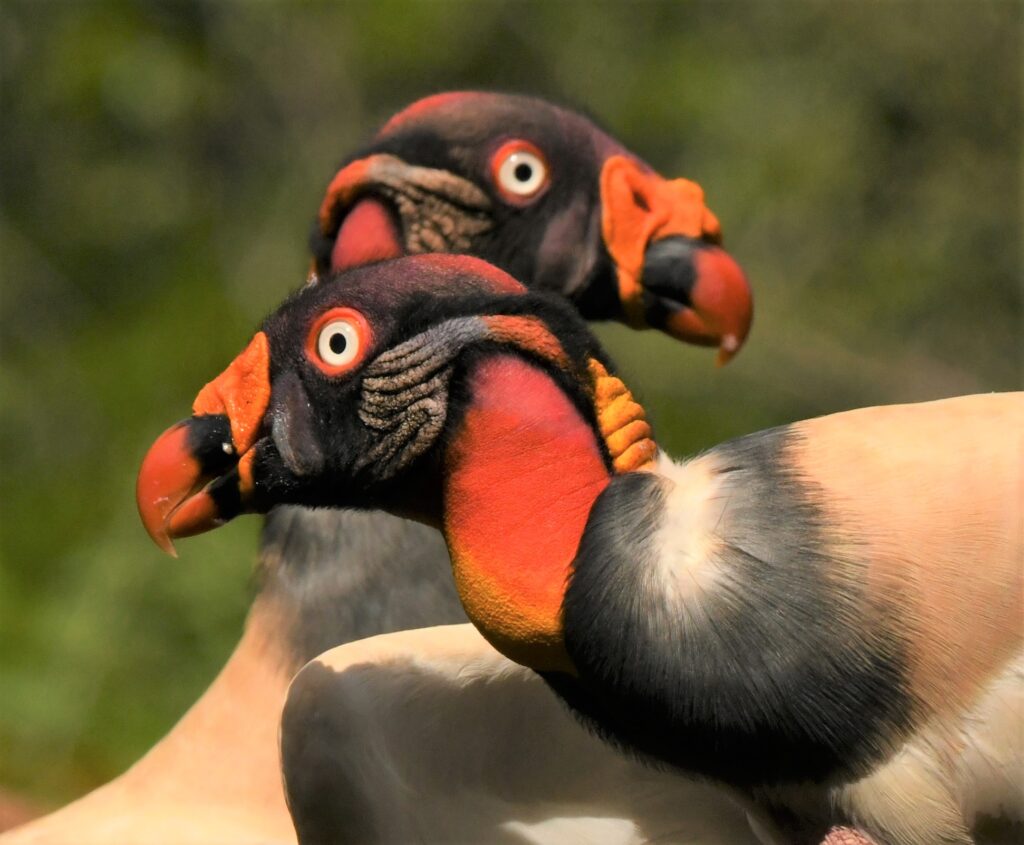
Most of the route from AOL to LDL was familiar to me and the notoriously long, bumpy drive north from Pital seemed surprisingly smooth. Recent road improvements had been made; new eco-lodges appeared along the way. What was a remote, largely unvisited region two decades ago, had become quite popular, particularly with recreational vehicle enthusiasts, cyclists and birders. Laguna Del Lagarto Lodge, one of the original eco-lodges in the region, was now internationally renowned for wildlife photography. The BBC had recently done a wildlife documentary at LDL; numerous professional photography groups had used the lodge facilities and forest trails for both daytime and nightime photography, documenting some of the rare and extraordinary birds and mammals of the region.
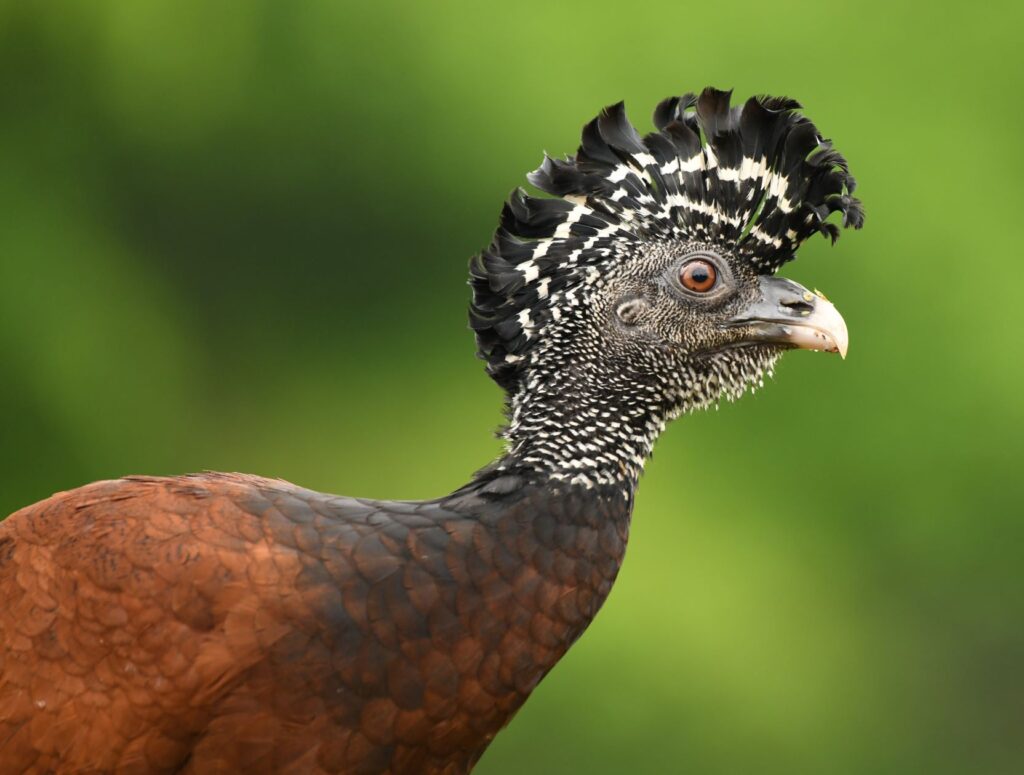
Upon arrival, I was greeted by my Tico friends Didier and Adolfo, both of whom had been working at LDL for about twenty years. Didier was in charge of general maintenance and guiding bird/nature walks in the area. In the early years I had witnessed his development as a young birder and naturalist, rising to the level of an undisputed local expert. Adolfo, the LDL manager and also a competent naturalist, remained as cheerful as ever. It was good to see both of them again. A couple days later, the LDL owner, Kurt Schmack, arrived by car from San Jose. The old LDL crew was together again.
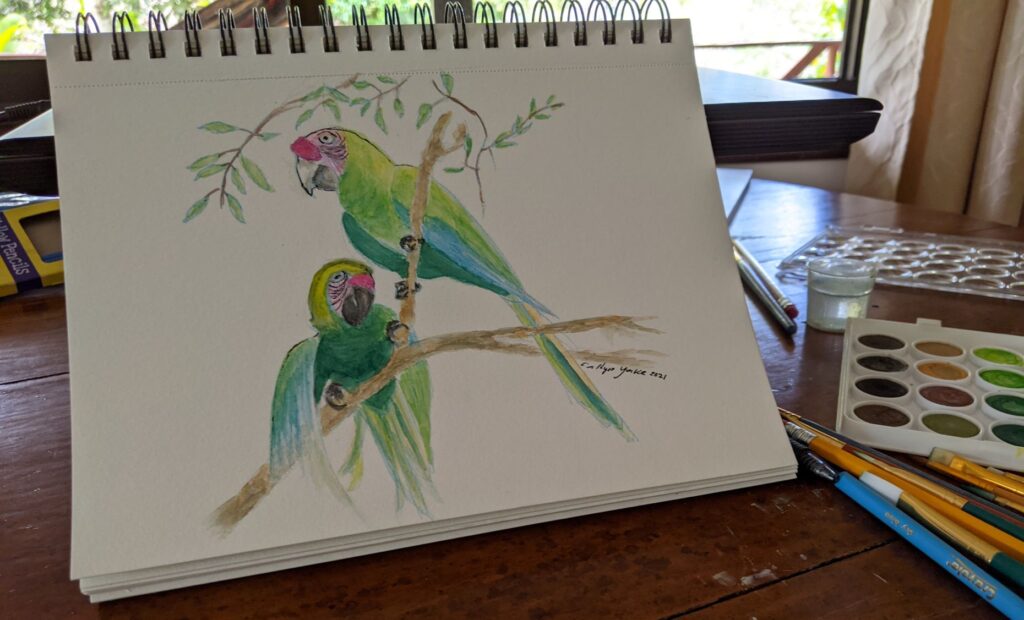
The famous Laguna del Lagarto eco-lodge was largely vacant and there was a wide choice of rooms. I took #19 in one of the original buildings, which had two large windows, a portable fan mounted on the wall and a wooden deck overlooking the lagoon. Reflecting on some of my more memorable times here, this room and the others next to it had been occupied by my Antelope Valley College Tropical Biology class in January, 1999. Except for new paint and bathroom upgrades, little had changed. LDL retained its original rustic charm, including an amazing variety of nocturnal insects ambushed by geckos darting across the walls. I’m unsure if any of the students ever returned to LDL but if they had, it may have appeared as if they had never left.
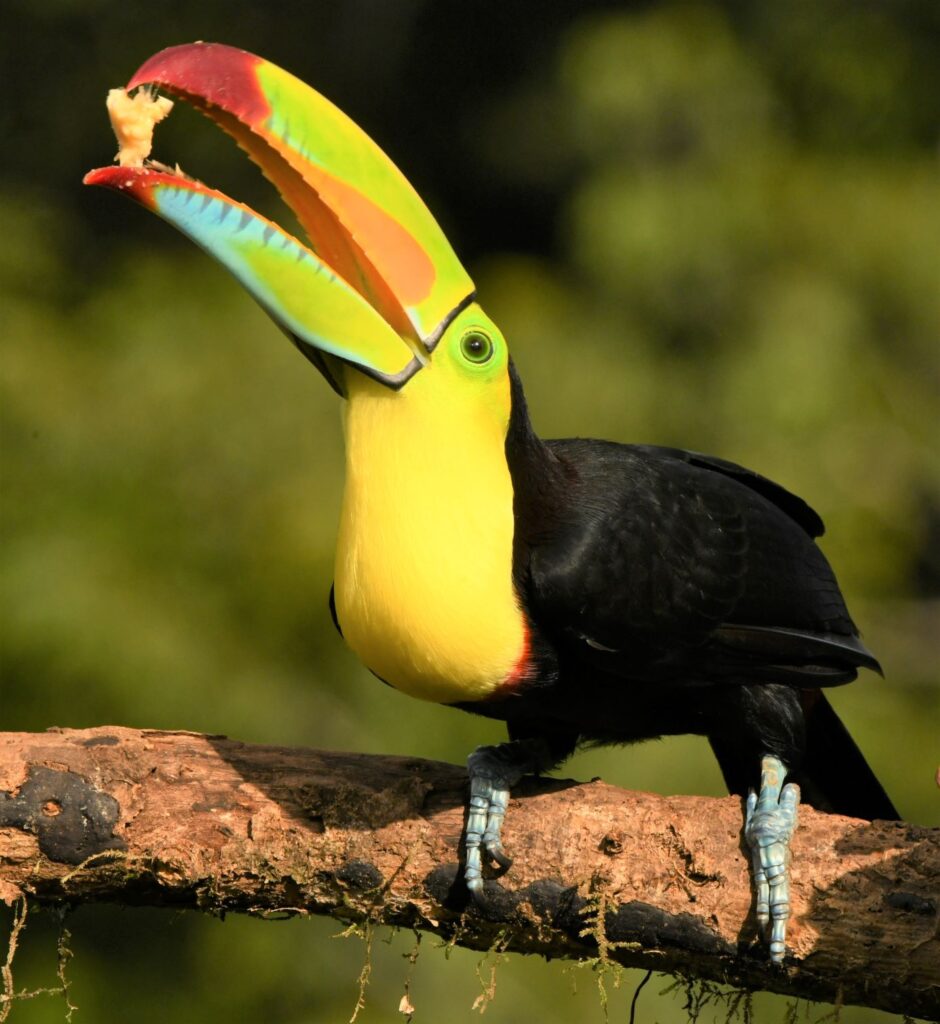
Three of the workers helped remove a window screen and lift a large table into the room that I could use for artwork. Rainy afternoons would be perfect for doing watercolor paintings. I finished unpacking and organized my stuff for an extended stay. Delicious aromas wafted through the window of my room. Mealtime at LDL was a pavlovian event.
Adolfo, a Nicaraguan immigrant, who had been trained as a chef in Europe, was busy in the kitchen next to the elevated dining room with a dozen sets of empty wooden tables and chairs; the neat place settings and freshly laundered tablecloths looked ready for business. Reservations had been confirmed; new guests were expected later that day and throughout the week. Meanwhile, toucans, aracaris and a variety of tanagers and honeycreepers were picking apart a fresh bunch of bananas hoisted up to a platform at eye-level. Cumulus clouds crowded together in electric blue skies; a cracking good thunderstorm was imminent.
There was a stillness and silence for a few moments – a dramatic pause hanging in the air. Birds at the feeder were growing restless, their vocalizations became more frequent. Simultaneously, increasingly overcast skies softened the lighting, now nearly perfect for photography. My Nikon D850 was within reach and fully charged; the 200-500 mm AF, VR lens cleaned and polished. Perfect. A wave of nostalgia swept over me as I gazed out into the garden, lagoon and nearly solid wall of mature secondary forest surrounding the lodge. Didier came over to my table and asked how I had been. Adolfo emerged from the kitchen smiling, carrying a freshly prepared gourmet meal. Life couldn’t be better than this. I was home.
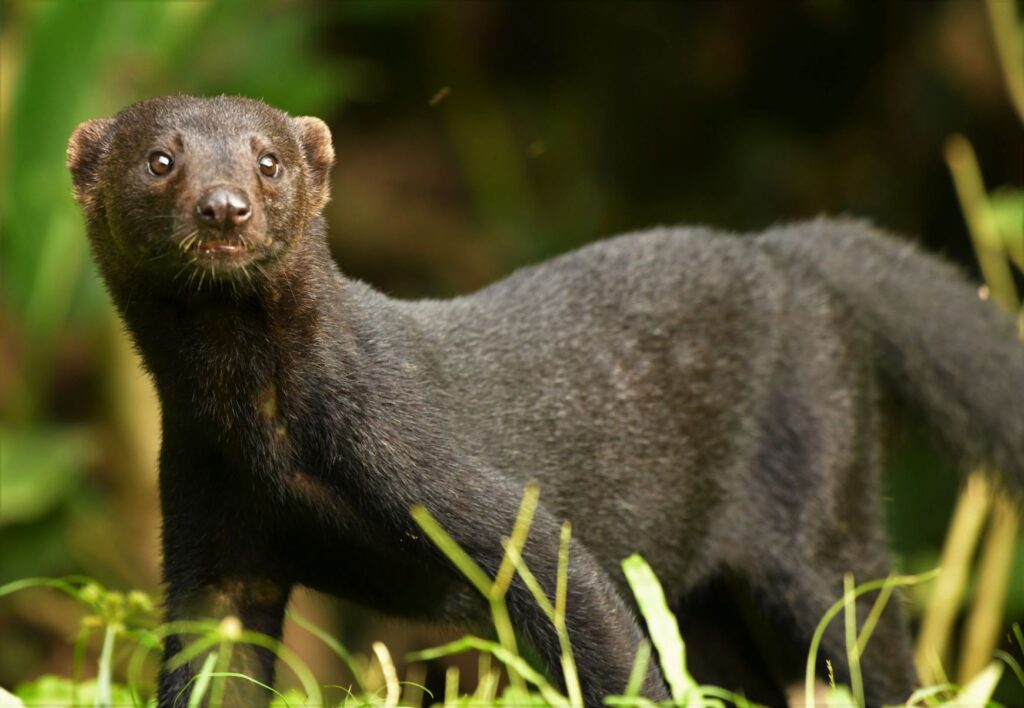
Several more guests arrived at LDL during the next few days, including a serious wildlife photographer from Poland, Marek Jakowski. In fact, as I later learned, Marek was an award-winning, internationally acclaimed photographer with an impressive gallery displayed on his website.
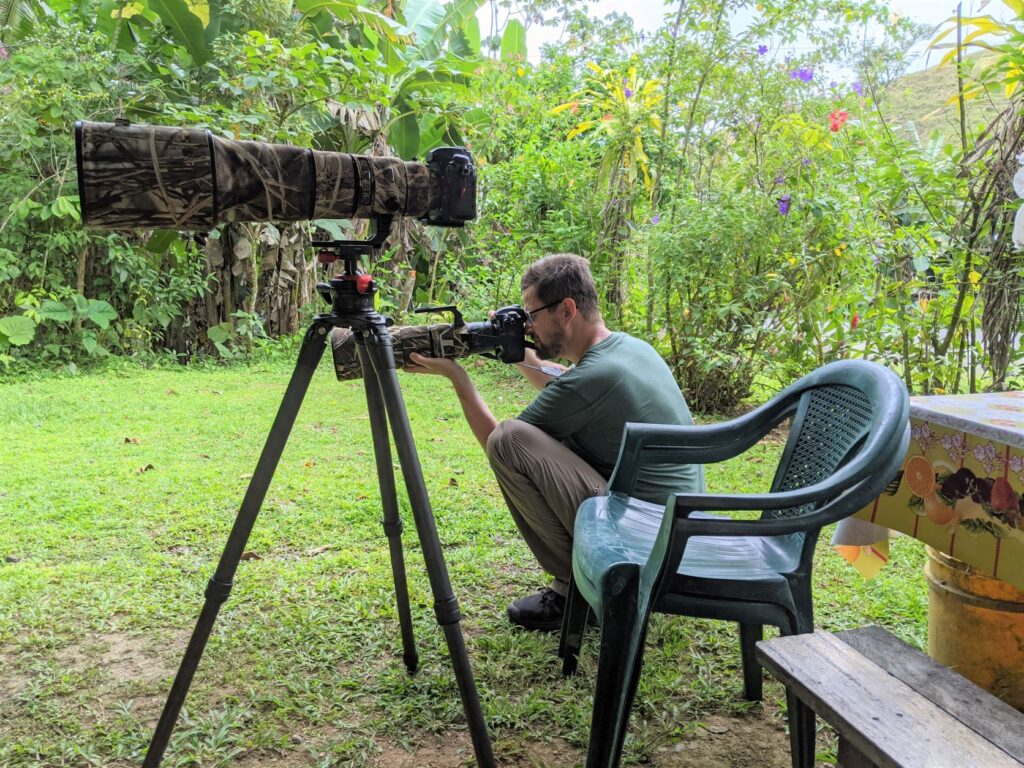
Almost immediately following our introduction, Marek and I began discussing plans to visit various locations within and beyond the LDL property in search of photographic opportunities. Those places included Diego’s residence bird garden and Adolfo’s residence bird garden, both located in the nearby village of Santa Rita; Henri’s bird garden in Boca Tapada, Maquenque Lodge near Boca Tapada and property I purchased about ten years earlier, Loma Lapa Verde, adjacent to the LDL vulture photography hide, designed and built by renowned Hungarian photographer, Bence Mate.

Marek and I were keen to find birds and other wildlife, particularly species that were uncommon or absent elsewhere in Costa Rica. Our Nikon equipment was fully interchangable and luckily for me, Marek seemed to have nearly every piece of camera gear recently available on the market. He was quite a trooper as well, toting much of the heavy equipment on his back, including an extra camera body, lenses and tripods. Tagging along with only a binocular and camera, I must have appeared as a bit of an amateur, which compared to Marek, was most certainly the case. If I had any slight advantage over Marek, it was due to acquired knowledge of local wildlife and ecology. Marek was a quick study, however, and always eager to learn about the natural history of the area. It was great having such an enthusiastic, outgoing photographer for a companion. When I mentioned to Marek my plan for an insect light trap in the LDL forest, he readily offered his help, which was gratefully accepted.
On the 8th of March, 2021, two LDL workers, Marek and I, installed a light trap that I designed to attract nocturnal insects, e.g. moths, as potential prey items for birds. Many birds are highly responsive to new food sources and repeatedly visit locations where food is available. This opportunistic, adaptive behavior plays into the bird photography game quite well. Hidden in a blind nearby, birders with their cameras on tripods stand ready to capture stunning close-up images of a variety of birds in a natural setting, including secretive species otherwise seldom seen.
Indeed, insect light traps were quite productive at several eco-lodges I had visited in Ecuador. Upon close inspection, I noted that the materials and methods for installation were fairly simple and could be easily adapted to a particular location. In the present case, a white bed sheet was suspended on a limb tied between two trees, directly under a florescent light with a metal hood to prevent water damage (photo). The light was switched on manually at sunset and off at dusk each day (an automatic timer switch was subseqently ordered for it).
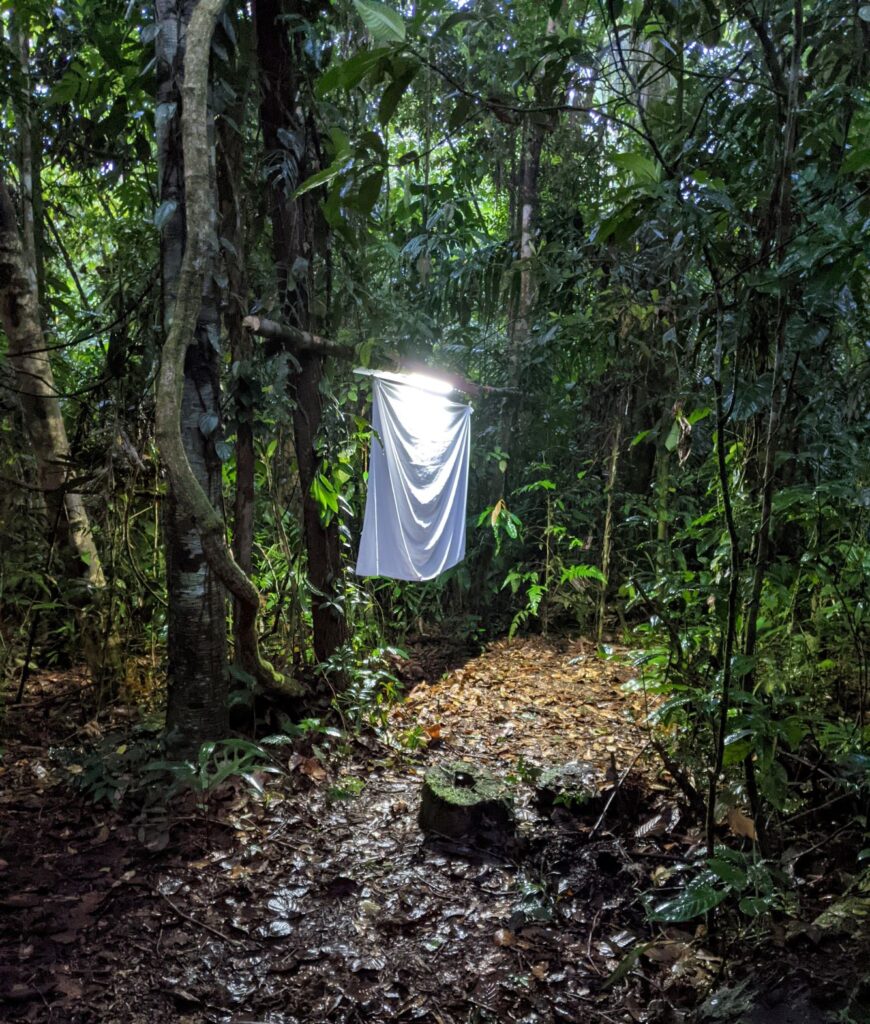
I checked the newly installed light trap early each morning and noted the number and kind of insects attached to the sheet. Taken together over a period of several days, only a handful of insects were found, predominantly small moths (Lepidoptera), katydids (Orthoptera), an assortment of tiny bugs (Hemiptera) and beetles (Coleoptera). A hopeful sign was that insects on and around the bed sheet, briefly attracted the curiosity of a
Russet-naped Wood-Rail (Aramides albiventris). But no other birds, even those vocalizing nearby, appeared interested, at least when I was there alone and trying to be inconspicuous. Although the light trap was working properly, March was perhaps not the optimal time of year; July – September might be best for catching nocturnal insects in the forest, according to Didier and Adolfo. I’m planning a subsequent visit to LDL in September, 2021 to see, among other things, how our new insect light trap is doing.
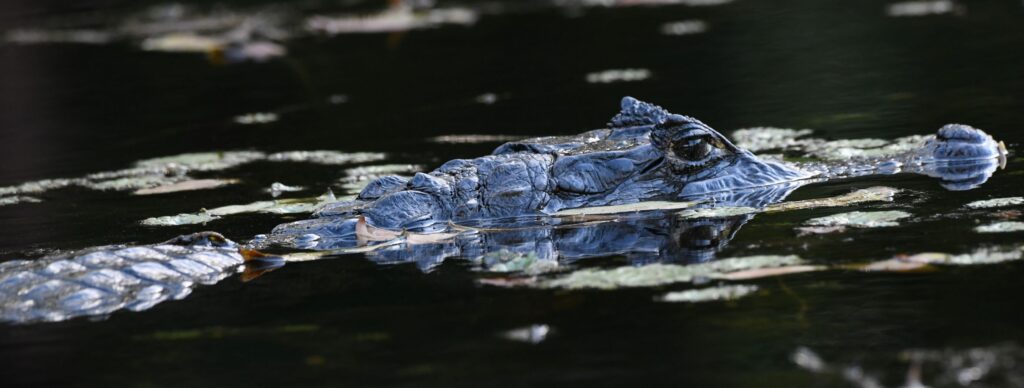
Laguna Del Lagarto Annotated Bird List (4-15 MARCH 2021) Callyn Yorke
Explanation of Symbols
Abundance: Numbers following each species represent the maximum number of individuals found during a survey.
Frequency: C = Commonly found (or expected to be found) during all or most surveys; FC = Fairly commonly found on about half of the surveys; UC = Uncommonly found less than half of the surveys; R = Rarely found; i.e. only once during the surveys. (Note: Some areas were surveyed only once, e.g. Maquenque Lodge).
Locations: ABG = Adolfo’s Bird Garden, Boca Tapada; BT = Boca Tapada, road between Santa Rita and Boca Tapada, including adjacent secondary forest, weedy drainage ditches and roadsides, homesteads, agriculture and pasture; DBG = Diego’s Bird Garden, Santa Rita; HBG = Henri’s Bird Garden, secondary forest and stream (0.2 ha), Boca Tapada; LDL = Laguna Del Lagarto lodge, gardens, lagoons, forest and trails, pasture and cultivations (270 ha); LLV = Loma Lapa Verde, second-growth, grassland, including the adjacent vulture photography hide (1 ha); MAQ = Maquenque Lodge, short segment of the San Carlos River , lagoons, second-growth and gardens (ca. 50 ha).
Systematics and Nomenclature follows Avibase and Clements (2021)
- Black-bellied Whistling Duck Dendrocygna autumna 120 a large, wary, scattered flock, apparently composed of smaller famly groups along the south shore of a large lagoon next to and easily viewed from the lodge, MAQ, C
- Muscovy Duck Cairina moschata 2 (m,f) individuals seen flying and alighting in the main lagoon in front of the lodge, LDL, C
- Blue-winged Teal Spatula discors 6 (m,f) gregarious, a cohesive flock on the south shore of lagoon, MAQ, C
- Gray-headed Chachalaca Ortalis cinereiceps 6 coming to elevated bird feeder with fruit, MAQ, C
- Crested Guan Penelope purpurascens 2 (m,f) pairs on and around feeder, LDL, C
- Great Currasow Crax rubra 6 (m,f) gregarious, frequenting feeder and ground below, LDL, C
- Short-billed Pigeon Patagoienas nigrirostris 1 vocal in a Cercropia tree next to the driveway, LDL, UC
- Inca Dove Columbina inca 2 on utility wire BT, C
- Common Ground Dove Columbina passerina 2 flushed from roadside, BT FC
- Ruddy Ground Dove Columbina talpacoti 10 flushed from roadside, BT, FC
- White-tipped Dove Leptotila verreauxi 2 on ground in garden, LDL, C
- Groove-billed Ani Crotophaga sulcirostris 4 roadside scrub and pasture, BT, C
- Squirrel Cuckoo Piaya cayana 1 subanopy of forest edge trees, LDL, FC
- Common Paraque Nyctidromus albicollis 1 resting and well concealed during the day in shady, short grass and leaf litter, discovered by Diego, LDL, FC
- White-necked Jacobin Florisuga mellivora 10 (m,f) habituated to human presence (e.g. photographers) and attracted to hummingbird feeders and flowers with artificially supplied nectar, ADG, LDL, C
- Long-billed Hermit Phaethornis longirostris 1 attracted to and briefly visiting garden Heliconias, LDL, ADG, UC
- Bronze-tailed Plumeleteer Chalybura urochrysia 1 perched quietly for several minutes in garden trees and under eaves of the house, DBG, C
- Crowned Woodnymph Thalurania colombica 1 (m) briefly visiting a nectar filled banana flower at the covered bat photography station in the forest, LDL, UC
- Rufous-tailed Hummingbird Amazilla tzacatl 5 foraging on inflorescences of a wide variety of flowering shrubs and trees in garden, LDL, C
- Ruset-naped Wood-Rail Aramides albiventris 1 on ground around bird feeder and insect light trap, LDL, UC
- Purple Gallinule Porphyrio martinica 6 (including one adult followed by a nearly full grown immature bird) on edge of lagoon and on bird feeder, MAQ, C
- Northern Jacana Jacana spinosa 8 (including 2 immatures) on lagoon shore and on bird feeder, MAQ, C
- Anhinga Anhinga anhinga 2 (ad, imm) perched on snags in west lagoon, MAQ, C
- Bare-throated Tiger Heron Tigrisoma mexicanum 1 (imm) at edge of main lagoon, LDL, FC
- Great Egret Ardea alba 1 in shallows of east lagoon, MAQ, C
- Green Heron Butorides virescens 1 (ad) on lily pads at edge of main lagoon, LDL, UC
- King Vulture Sarcoramphus papa 10 (ad. and at least 2 imm.) gregarious in pairs circling 100-200m above the forest; flock feeding actively with BLVU on cow head bait at vulture photography hide; now well habituated to the nearby presence of humans in the photography hide (one-way glass front had been removed months ago), LLV, C
- Black Vulture Coragyps atratus 20 gregarious, circling above forest and actively feeding with KIVU, as noted above, ubiquitous.
- Turkey Vulture Cathartes aura 4 gregarious when circling high above forest and pasture but not present with KIVU and BLVU at the LLV vulture photography feeding station, LDL, BT, UC
- Gray-headed Kite Leptodon cayanensis 1 perched in tree at edge of the main lagoon and harassed by a Melodius Blackbird, LDL, R
- Broad-winged Hawk Buteo platypterus 1 (imm.) perched in tree at edge of main lagoon, LDL, R
- Central American Pygmy Owl Glaucidium griseiceps 2 a pair nesting/roosting in a trunk cavity of a decaptitated palm tree in the front garden, occasionally emerging and flying to nearby trees, habituated to frequent human presence, LDL, C
- Slaty-tailed Trogon Trogon massena 1 (m) perched on low tree branch, HBG, FC
- Ringed Kingfisher Megaceryl torquata 1 flying over lagoon, MAQ, FC
- Pied Puffbird Notharchus tectus 1 in canopy of large garden tree, LDL, R
- Collared Aracari Pteroglossus torquatus 3 gregarious at the feeder, LDL,C
- Yellow-throated Toucan Ramphastos ambiguus 2 a pair at the feeder, LDL, FC
- Keel-billed Toucan Ramphastos sulfuratus 3 vocal in garden trees and at feeder, LDL, C
- Olivaceous Piculet Picumnus olivaceus 1 in roadside trees, BT, garden trees, LDL, UC
- Black-cheeked Woodpecker Melanerpes pucherani 4 regular at feeder and adjacent gardden trees, LDL, C
- Pale-billed Woodpecker Camphephilus guatemalensis 1 on garden tree, DBG, UC
- Lineated Woodpecker Dryocopus lineatus 1 in garden tree, LDL, R
- Chestnut-colored Woodpecker Celeus castaneus 1 fem. at feeder, LDL and in garden, ABG, UC
- Crested Caracara Caracara plancus 3 an immature at vulture feeding station, LLV, in pasture, BT, FC
- Laughing Falcon Herpetotheres cachinn 1 in subcanopy of tall garden tree, LDL, UC
- Orange-chinned Parakeet Brotogeris jugularis 2 gregarious in garden trees, ABG LDL, FC
- Brown-hooded Parrot Pyrilia haematotis 2 a pair in garden trees and at the feeder, LDL, FC
- Red-lored Parrot Amazona autumnalis 2 apparently nesting in topless garden palm cavity, habituated to frequent human presence LDL, C
- White-fronted Parrot Amazona albifrons 1 in distant canopy of secondary forest, LDL, R
- Mealy Parrot Amazona farinosa 2 flying over lagoon and forest, MAQ, UC
- Great Green Macaw Ara ambiguus 10 gregarious in pairs and small (family?) groups, vocal, foraging on almonds in Alemendro trees above the water tanks, LDL, C
- Scarlet Macaw Ara macao 2 gregarious, pairs flying north to roost in late afternoon, LDL, BT, FC
- Streak-headed Woodcreeper Lepidocolaptes souleyetii 1 in subcanopy and mid level of large roadside and garden trees, LDL, BT, FC
- White-collared Manakin Manacus candei 1 vocal around lagoon, LDL, active in garden, HBG, FC
- Red-capped Manakin Ceratopipra mentalis 1 (m) active in garden flowering shrubs, HBG, UC
- Masked Tityra Tityra semifasciata 1 in large trees around garden, LDL, FC
- Common Tody-Flycatcher Todirostrum cinereum 1 in shrubby second growth, ubiquitous, FC
- Yellow-bellied Elaenia Elaenia flavogaster 1 second-growth edge of forest, HBG, UC
- Eastern Wood Pewee Contopus virens 1 roadside second-growth, BT, UC
- Tropical Pewee Contopus cinereus 1 second-growth edge of pasture, BT, UC
- Bright-rumped Attila Attila spadiceus 1 vocal, garden shrubs, LDL, FC
- Great-crested Flycatcher Myiarchus crinitus 1 in large garden tree, ABG, R
- Great Kiskadee Pitangus sulphuratus 2 vocal, regular at and around feeder, LDL, C
- Social Flycatcher Myiozetetes similis 2 in garden trees and edge of second-growth, LDL, BT, FC
- Tropical Kingbird Tyrannus melancholicus 2 on utility wires, BT, LDL, C
- Southern Rough-winged Swallow Stelgidpteryx ruficollis 8 gregarious on utility line, BT, flying low around lagoon, MAQ, FC
- Mangrove Swallow Tachycineta albilinea 20 gregarious, a pair flyng low over San Carlos River bank, alighting on ferry, large flock flying over east lagoon, MAQ, C
- Cliff Swallow Petrochelidon pyrrhonota 2 on roadway, BT, UC
- Southern House Wren Troglodytes musculus 1 vocal, active low in garden shrubs and on the floor in dining area, LDL, C
- Wood Thrush Hylocichla mustelina 1 on and near the ground at shady edge of forest clearing, HBG, UC
- Clay-colored Thrush Turdus grayi 5 active in garden and other disturbed areas, ubiquitous
- Yellow-crowned Euphonia Euphonia luteicapilla 1 roadside second-growth, BT, UC
- Olive-backed Euphonia Euphonia gouldi 2 (m,f) at feeder, LDL, DBG, UC
- Rufous-collared Sparrow Zonotrichia capensis 2 on grass in garden, LDL, FC
- Chestnut-headed Oropendola Psarocolius wagleri 2 a pair at feeder, LDL, UC
- Montezuma Oropendola Psarocolius montezuma vocal, gregarious at feeder, ubiquitous C
- Black-cowled Oriole Icterus prosthemelas 1 relatively shy, at feeders in garden, LDL, ABG, UC
- Baltimore Oriole Icterus galbula 2 in flowering trees around garden and roadside second-growth, LDL, LLV, BT, C
- Melodius Blackbird Dives dives 3 vocal, garden and second-growth also feeder, LDL, FC
- Great-tailed Grackle Quiscalus mexicanus 1 (f) in garden and at feeders, ABG, BT, C
- Golden-winged Warbler Vermivora chrysoptera 1 roadside trees and second-growth, BT, R
- Chestnut-sided Warbler Setophaga pensylvanica 2 garden trees, second-growth, ubiquitous, C
- Summer Tanager Piranga rubra 2 (m,f) garden trees and feeders, LDL, DBG, ABG, C
- Indigo Bunting Passerina cyanea 2 (f, imm) roadside second-growth, BT, FC
- White-lined Tanager Tachyphonus rufus 1 visited feeder briefly, LDL, R
- Scarlet-rumped (Passerini’s) Tanager Ramphocelus passerina 4 garden and feeders, second-growth, ubiquitous, C
- Blue-gray Tanager Thraupis episcopus 4 regular at feeders, ubiquitous, C
- Palm Tanager Thraupis palmarum 2 regular at feeders, ubiquitous, C
- Golden-hooded Tanager Stilpnia larvata 2 regular at feeders, LDL, ABG, C
- Plain-colored Tanager Tangara inornata 2 occasional at feeder, LDL, UC
- Shining Honeycreeper Cyanerpes lucidus 1 (m) at feeder, DBG, U
- Red-legged Honeycreeper Cyanerpes cyaneus 2 (m,f) regular at feeders, LDL, ABG, C
- Green Honeycreeper Chlorophanes spiza 2 (m,f) pairs regular at feeders, LDL, ABG, C
- Blue-black Grassquit Volatinia jacarina 4 roadside grassland and second-growth, BT, C
- Variable Seedeater Sporophila corvina 6 gardens, roadside second-growth and pasture edge, ubiquitous, C
- Morelet’s Seedeater Sporophila morelleti 5 roadside grassland and second-growth, BT, C
- Yellow-faced Grassquit Tiaris olivaceus 2 gregarious, very local in roadside ditches and fenced pastures, BT, FC
- Buff-throated Saltator Saltator maximus 2 second-growth, feeders, forest edge, ubiquitous, FC
Samara, Guanacaste 15-29 March, 2021 Callyn Yorke
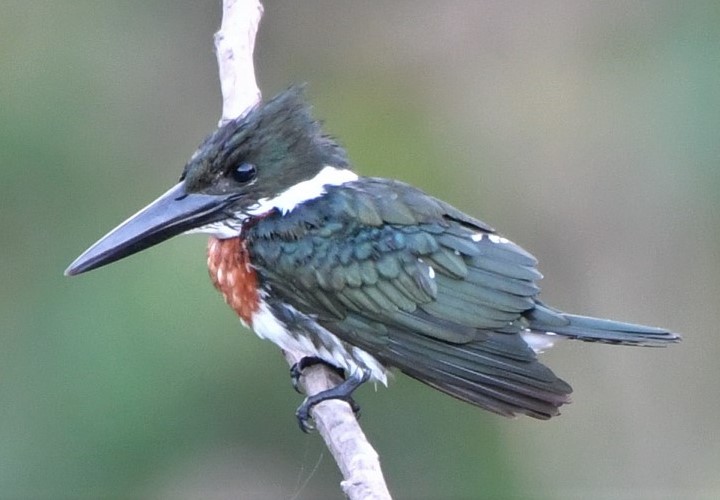
During the two weeks spent in Samara (pronounced, SAM – ah – ruh), I encountered about 100 species of bird within a 5 km radius of the town center. No less than seventy-five species were found within an easy walking distance from the GoodLife Lodge, located near the beach and terminus of a seasonal stream (Rio Lagarto) on the west side of town. Since I added new species to the list nearly every day a survey was made, it seemed likely that the total number of bird species that might be found in and around Samara during a single year would be somewhere around 300. Given the amount of development and habitat fragmentation in this incresingly popular tourist area, bird species diversity was surprsingly high.
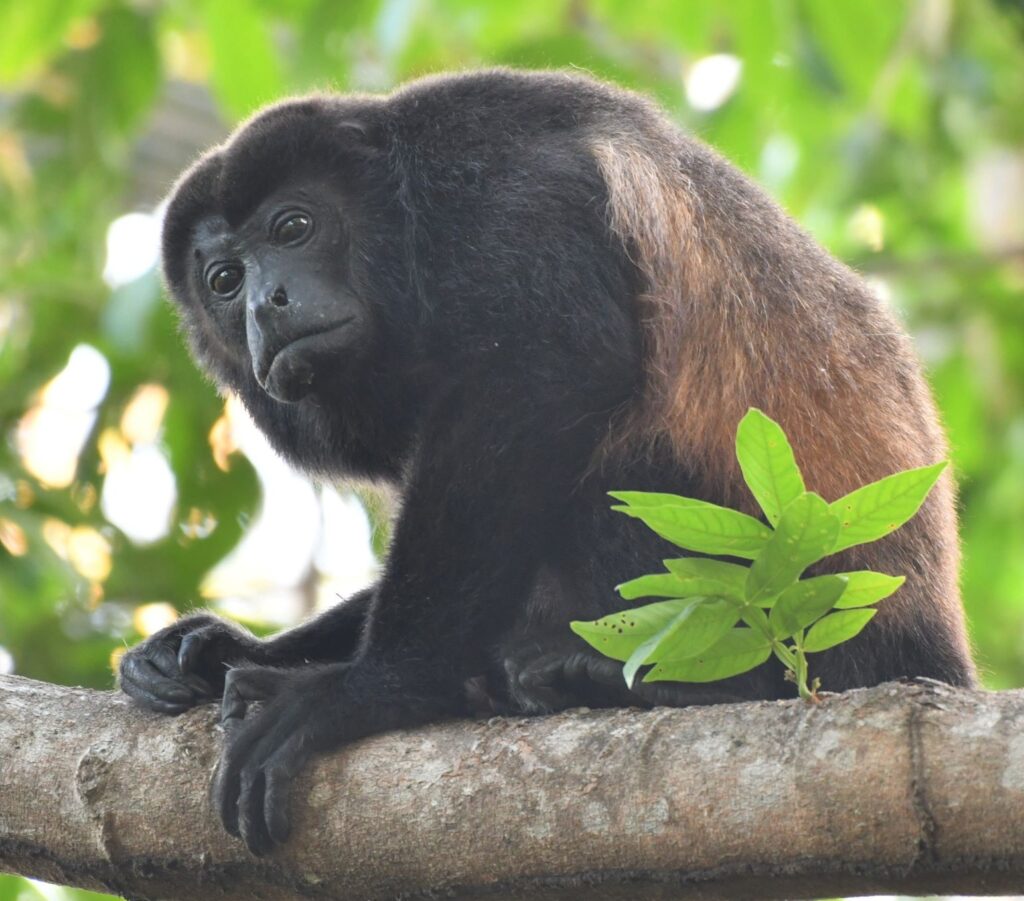
Other widlife was fairly active and conspicuous as well. Nearly every morning at dawn howler monkeys would sound off with their deeply resonant calls that carried for several hundred meters. These monkeys were evidently habituated to tourists staring up at them in the tree canopy, and were generally cooperative for portraits, provided a reasonably powerful lens was being used, e.g. 500 mm. Their diet appeared to include simple winged, indehiscent fruits (‘samara’) which were abundant in the seasonal deciduous forests of the area.
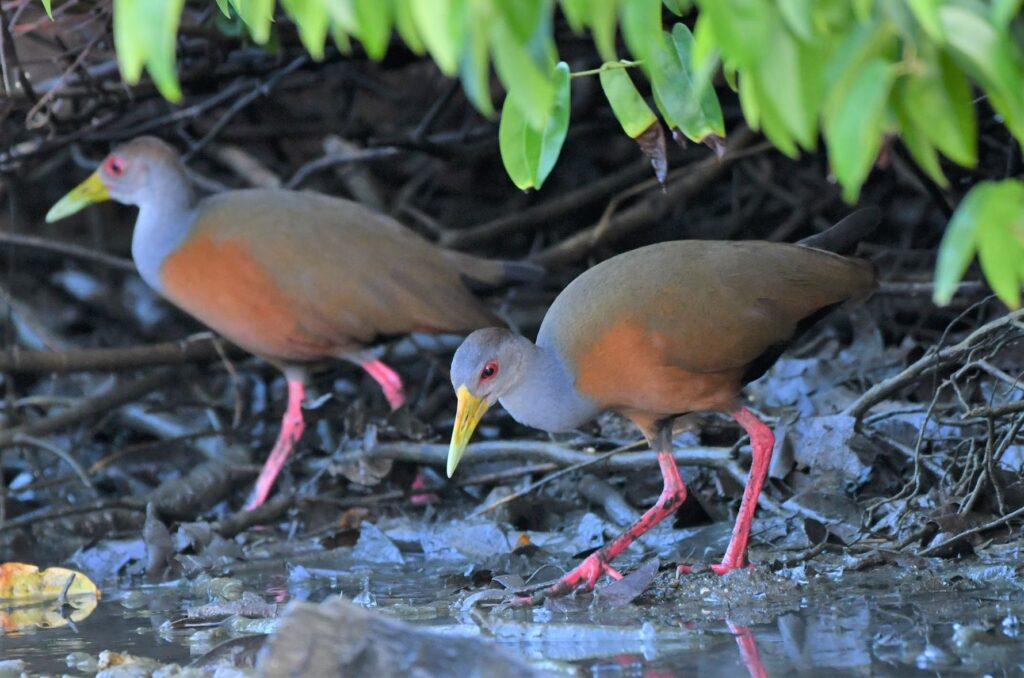
Northbound migration along the coast was gaining momentum during the latter half of March. Small flocks of sandpipers and a few larger shorebirds were present in nearby lagoons; Rio Lagarto (‘Lizard River’) on the west end and Rio Mala Noche (‘Bad Night River’) terminating on the east-central shore of Playa Samara. Remnant patches of mangrove and estaurine backwaters were haunts of secretive waterbirds, e.g. Little Blue Heron, Yellow-crowned Night Heron and Gray-cowled Wood-Rail. Estuarine mudflats and sandspits attracted Black-bellied Plover, Least Sandpiper, Sanderling and Ruddy Turnstone. Birds of the outer shore and bay included, Tricolored Heron, Willet, Whimbrel, Brown Pelican, Magnificent Frigatebird and Royal Tern.
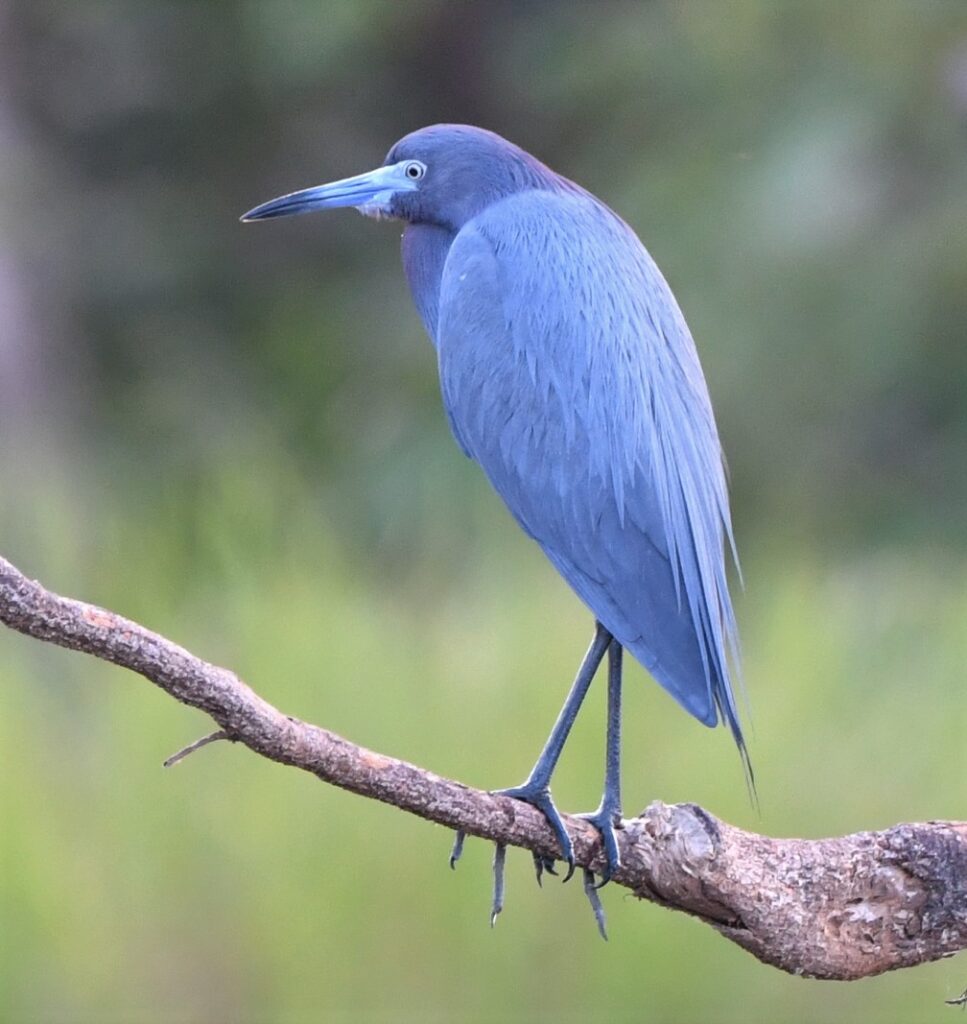
I usually began my surveys on the shoreline at dawn, hoping to avoid the locals with their free-ranging, unleashed dogs. Unfortunately, that was seldom the case. Shorebirds bolted as soon as they caught sight of dogs headed their way, flying off to a distant, less disturbed section of the bay.

If I was patient and just waited where the birds had departed, they would eventually return when the dogs were gone and the coast was clear. The extra energy used for emergency escape flights cost these birds dearly. Finding enough food in the mud and sand was difficult enough, let alone being chased around in the process. Many migratory shorebirds such as the Ruddy Turnstone, attempt to fly thousands of miles between their wintering grounds in Central and South America and breeding grounds in the Arctic Circle; these flights are often made on minimal fat reserves with regular stops for refueling.
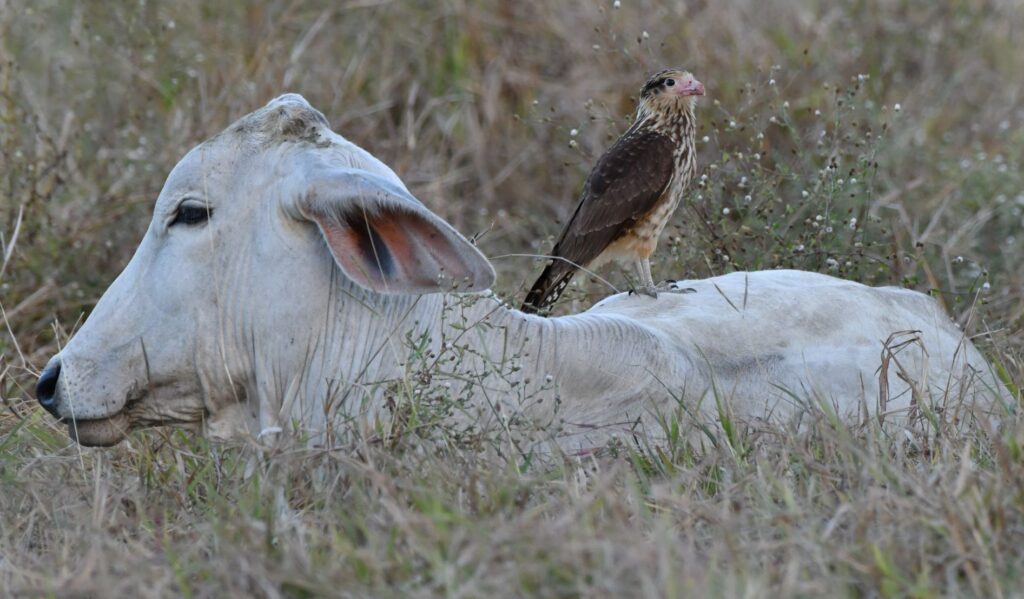
Gardens in town supported an abundance of flowering and fruiting shrubs and trees, attracting a variety of parrots and tanagers, in addition to swarms of insects, which in turn attracted flycatchers, gnatcatchers, wrens and warblers. By any measure, Samara was rich with birdlife. Highlights included Green-breasted Mango, Plain-capped Starthroat, Cinnamon Hummingbird, Orange-fronted Parakeet, Streaked Flycatcher, Lesser Greenlet, White-lored Gnatcatcher, Streak-backed Oriole and Mourning Warbler.

From the shoreline, I followed the main road (Via 160) into the adjacent suburbs, pastures, shrubland, seasonal secondary forest and riparian woodland. After completing a two-hour walking circuit covering a distance of about 4 km, I usually arrived back at the GoodLife lodge in time for breakfast, with a list of around thirty bird species. By then the air temperature had reached the mid 20C range and depending on prevailing onshore winds, could be in the low 30C’s by the early afternoon. Unsurprisingly, birds, like many residents of Samara, were most active during the early morning hours.
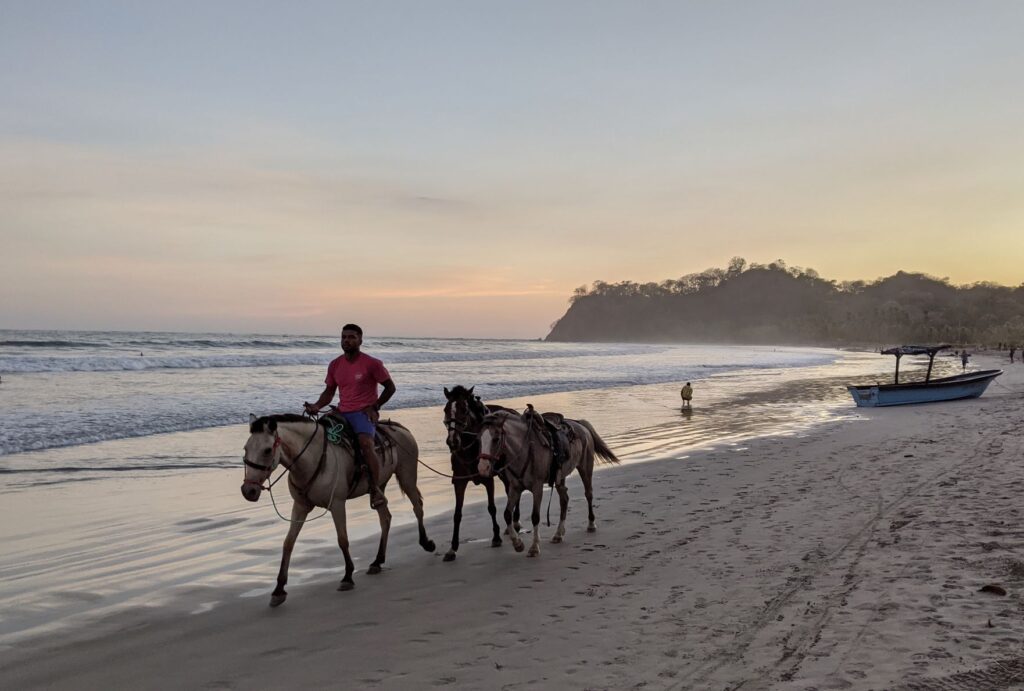
Further from town, there were different birds to be found. Driving westward on Via #160 for about 5 – 7 km, the road transected a series of ranches with open, sometimes wet pastures and scattered trees. One such location with the curious name of Finca Taranta (‘madness farm’) supported a small population of Double-striped Thicknee, a life bird for me. Perhaps the haunting, reed-like calls given by this bird on moonlit nights, explains the rather disturbing name of this place.
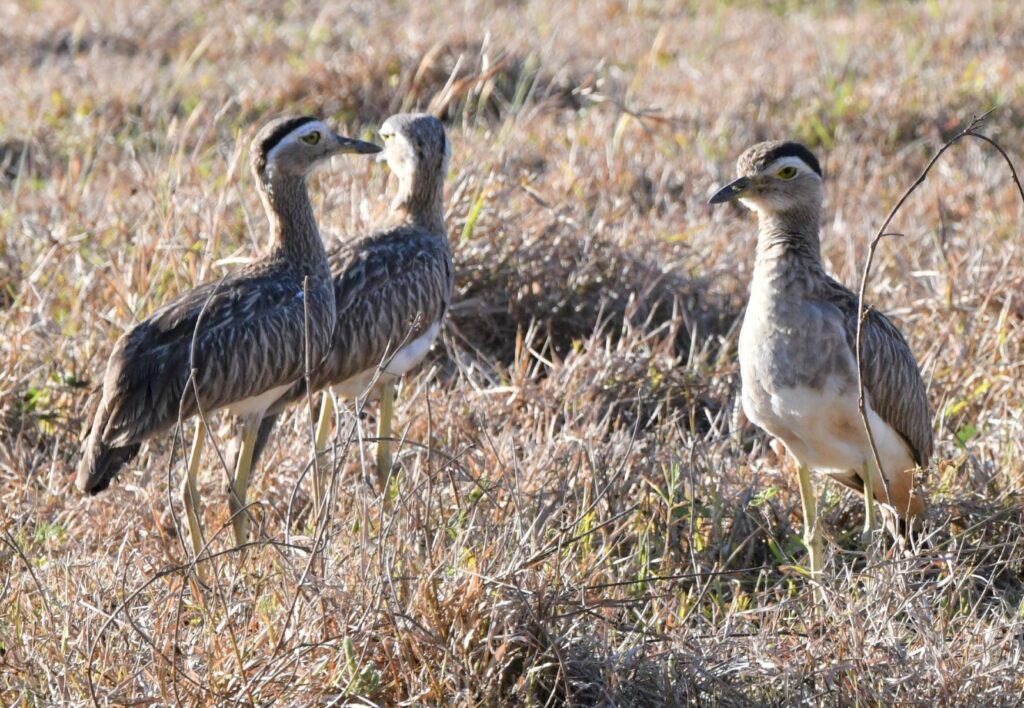
Another 2km to the northwest of Finca Taranta, the road crossed the largest river in the Samara district, Rio Buena Vista. At the bridgeless river crossing, a mature riparian forest provided excellent cover for several more species of bird that I would add to the list, including Boat-billed Heron, White Ibis and Black-crowned Tityra. This river terminated at another mangrove estuary about 1 km south, which though comparatively secluded at the end of a rough dirt road, appeared rather devoid of birdlife.

Samara Annotated Bird List 15-29 March, 2021 Callyn Yorke
Explanation of Symbols
Abundance: Numbers following each species represent the maximum number of individuals found during a survey.
Frequency: C = Commonly found (or expected to be found) on all or most surveys; FC = Fairly commonly found on about half of the surveys; UC = Uncommonly found in less than half of the surveys; R = Rarely found; i.e. only once during the surveys. (Note: Some areas were surveyed only once, e.g. Playa Buena Vista ).
Locations: FITA = Finca Taranta, adjacent ranches and pastureland on Via 160; PBV = Playa Buena Vista and adjacent mangrove estuary; PSAM = Playa Samara, including bay; RBVC = Rio Buena Vista at the Via 160 crossing; RLEM = Rio Lagarto estuary and mangrove; RLVC = Rio Lagarto bridge on Via 160, west Samara; RMAN = Rio Mala Noche, including mangrove and estuary; SAM = Samara town and gardens, e.g. The GoodLife Lodge (GLL).
Systematics and Nomenclature follows Avibase and Clements (2021)
- Muscovy Duck Cairina moschata 2 (m,f) a pair flying to limbs overhanging the river, RBVC UC
- Plain Chachalaca Ortalis vetula 4 vocal, gregarious, SAM, FC
- Red-billed Pigeon Patagioenas flavirostris 4 gregarious, flying over riparian woodland, RLVC, FC
- Inca Dove Columba inca 3 on ground in riparian woodland, SAM, FC
- Ruddy Ground Dove Columbina talpacoti 2 on roadside, FITA, FC
- Common Ground Dove Columbina passerina 1 roadside scrub, FITA, UC
- White-tipped Dove Leptotila verreauxi 1 on roadside in forest, FITA, UC
- White-winged Dove Zenaida asiatica 4 gregarious in and around gardens, SAM, C
- Groove-billed Ani Crotophaga sulcirostris 4 gregarious at edge of pasture, west SAM, C
- Squirrel Cuckoo Piaya cayana 1 in canopy of riparian woodland, RLVC, FC
- Common Paraque Nyctidromus albicollis 1 active at dusk on dirt road near the beach, SAM, FC
- Green-breasted Mango Anthracothorax prevostii 2 (m,f) frequenting sugar-water feeder at GLL, SAM, C
- Plain-capped Starthroat Heliomaster constantii 2 (m,f) at GLL feeder, SAM, FC
- Blue-vented Hummingbird Saucerottia hoffmanni 3 regular visitor to garden and feeder, riparian woodland understory flowering shrubs, SAM, RLVC, C
- Cinnamon Hummingbird Amazilla rutilla 2 regular visitor to garden and feeder, GLL, SAM, C
- Rufous-tailed Hummingbird Amazilia tzacatl 2 frequenting GLL feeder, SAM, C
- Gray-cowled Wood-Rail Aramides cajaneus 2 a pair foraging on edge of mangrove, RMAN, SAM, FC
- Double-striped Thicknee Burhinus bistriatus 6 gregarious in open field and short-grass pasture, FITA, FC
- Black-bellied Plover Pluvialis squatarola 1 in basic plmg. at edge of lagoon, RLEM, UC
- Semipalmated Plover Charadrius semipalmatus 10 (ad, imm) gregarious, on shore, PSAM, FC
- Northern Jacana Jacana spinosa 1 foraging on flat river bank, RBVC, R
- Hudsonian Whimbrel Numenius hudsonicus 1 on edge of lagoon, RLEM, R
- Ruddy Turnstone Arenaria interpres 12 (trans. alt. plmg.) gregarious, moving from lagoon shore into shallows, RLEM, UC
- Sanderling Calidris alba 2 (bsc. plmg.) individuals on outer shore, PSAM, UC
- Least Sandpiper Calidris minutilla 12 (bsc and trans. alt. plmg.) gregarious on lagoon shore, flying off together when disturbed by dogs, RLEM, C
- Western Sandpiper Calidris mauri 1 (bsc. plmg.) on edge of lagoon w flock of LESA, RLEM, R
- Spotted Sandpiper Actitis macularius 3 (alt. plmg.) individuals very active on shore of lagoons and streams, RLEM, RMAN, RLVC, C
- Solitary Sandpiper Tringa solitaria 1 active and wary on shore of lagoon, RMAN, R
- Willet Tringa semipalmata 2 active on outer shore and edge of lagoon, RLEM, PSAM, FC
- Royal Tern Thalasseus maximus 3 loosely gregarious, circling and diving in bay, PSAM, FC
- Magnificent Frigatebird Fregata magnificens 1 circling the bay, PSAM, R
- Brown Pelican Pelecanus occidentalis 3 circling the bay, diving near anchored boats, PSAM, FC
- Bare-throated Tiger-Heron Tigrisoma mexicanum 3 (ad, imm) one imm capturing a crayfish from the stream, RLVC, elsewhere individuals in marshy fields and ditches, SAM, FITA, C
- Great Egret Ardea alba 2 individuals at edges of lagoon and wet pastures, RMAN, FITA, FC
- Snowy Egret Egretta thula 3 individuals at edges of lagoon and wet pastures, RMAN, FITA, FC
- Little Blue Heron Egretta caerulea 1 (alt. plmg. ) on snag in lagoon, RMAN, R
- Tricolored Heron Egretta tricolor 1 foraging in shallows of outer shore, PSAM, FC
- Cattle Egret Bulbulcus ibis 10 gregarious, flying up river and over pastures, RBVC, FITA, FC
- Green Heron Butorides virescens 1 individuals foraging at edge of lagoon and mangrove, RLEM, FC
- Yellow-crowned Night-Heron Nyctanassa violacea 2 (ad., imm.) individuals partially concealed while perched in mangrove adjacent to main lagoon, RLEM, UC
- Boat-billed Heron Cochlearius cochlearius 5 gregarious, easily overlooked from a distance, perched 2 – 8m high in a riverbank tree 70 m downstream from road crossing, RBVC, UC
- White Ibis Eudocimus albus 2 (ad. imm) gregarious, flying upriver, RBVC, R
- Glossy Ibis Plegadis falcinellus 2 gregarious, flying upriver, RBVC, R
- Black Vulture Coragyps atratus 5 circling above forest, pasture and town, roosting in garden trees, ubiquitous, C
- Turkey Vulture Cathartes aura 1 circling high above town with BLVU, SAM, UC
- Osprey Pandion haliaetus 1 circling over outer bay, PSAM, R
- Roadside Hawk Rupornis magnirostris 1 vocal in riparian and dry woodland subcanopy, RLVC, FITA, FC
- Black-headed Trogon Trogon melanocephalus 1 (m) in subcanopy of riparian forest, RLVC, FC
- Turquoise-browed Motmot Eumomota superciliosus 2 a pair active at cavity nest in riverbank, RBVC; subcanopy of riparian forest RLVC, FC
- Amazon Kingfisher Chloroceryle amazona 1 (m,) individuals on snag perches diving in river, RBVC and lagoon, RMAN, C
- Green Kingfisher Chloroceryle americana 2 (f) diving in lagoon, RMAN, UC
- Collared Aracari Pteroglossus torquatus 1 entering nest cavity at 10 m height in main trunk of tree in riparian forest, RBVC, UC
- Keel-billed Toucan Ramphastos sulfuratus 1 vocal (unseen) in riparian forest, RBVC, R
- Crested Caracara Caracara plancus 2 one feeding on mammal carcas in pasture, FITA, FC
- Yellow-headed Caracara Milvago chimachima 3 on west shore, PSAM, an imm. on a resting cow in a pasture, FITA, C
- Orange-chinned Parakeet Brotergis jugularis 10 vocal, gregarious in fruiting trees, SAM, FC
- White-fronted Parrot Amazona albifrons 2 apair in mangrove trees, RLEM, FC
- Orange-fronted Parakeet Eupsittula canicularis 4 vocal, gregarious, trees west SAM, FC
- Streak-headed Woodcreeper Lepidocolaptes souleyetii 1 on main limbs of riparian trees, RLVC, FC
- Black-crowned Tityra Tityra inquisitor 1 perched on canopy of tall riparian tree, RBVC, R
- Masked Tityra Tityra semifasciata 2 in low trees at edge of camping resort, RLEM, FC
- Rose-throated Becard Pachyramphus aglaiae 1 in subcanopy of riparian woodland, RLVC, UC
- Bright-rumped Attila Attila spadicens 1 vocal (unseen) west SAM, UC
- Brown-crested Flycatcher Myiarchus tyrannulus 1 edge of riparian forest, SAM, FC
- Empidonax sp. 1 c.f. E. trailli 1 second-growth trees at edge of marsh and pasture, FITA, R
- Great Kiskadee Pitangus sulphuratus 4 vocal, in trees and shrubs next to clearings, ubiquitous, C
- Boat-billed Flycatcher Megarynchus pitangua 1 sallying to beach from snag, RAMN, UC
- Social Flycatcher Myiozetetes similis 3 gregarious, active in small trees, shrubs and on fences at edge of pasture, FITA, FC
- Streaked Flycatcher Myiodynastes maculatus 1 active in subcanopy of riparian woodland, RLVC, UC
- Tropical Kingbird Tyrannus melancholicus 4 on utility lines at edge of pastures, FITA, C
- Lesser Greenlet Pachysylvia decurtata 2 a pair foraging quickly upper middle of riparian forest, RLVC, UC
- Red-eyed Vireo Vireo olivaceus 1 vocal, active in canopy and subcanopy in riparian woodland, RLVC, C
- Yellow-green Vireo Vireo flavoviridis 1 active in canopy, subcanopy and upper-mid level of riparian woodland and garden trees, RLVC, SAM, FC
- White-throated Magpie-Jay Calocitta formosa 5 vocal, gregarious, bold and opportunistic, in gardens, habituated to people, regularly coming to fruit feeder at GLL; subcanopy of riparian woodland, RLVC, C
- Southern Rough-winged Swallow Stelgidopteryx ruficollis 2 flying low over beach and adjacent coastal scrub, pasture, PSAM, FC
- Gray-breasted Martin Progne chalybea 4 gregarious in town, on utility wires, SAM, C
- Barn Swallow Hirundo rustica 1 flying low over beach and adjacent open fields, PSAM, FC
- White-lored Gnatcatcher Polioptila albiloris 1 foraging in lower level vines in riparian woodland, RLVC, R
- Rufous-naped Wren Campylorhynchus rufinucha 6 vocal, gregarious in gardens and understory of riparian woodland, nesting in electrical box at top of a utility pole, SAM, RLVC, FITA, C
- Banded Wren Thryophilus pleurostictus 1 vocal in shady, sloped garden, road to PBV, UC
- Clay-colored Thrush Turdus grayi 5 vocal, individuals on ground in gardens and shady riparian woodlands, SAM, RLVC, C
- Yellow-crowned Euphonia Euphonia luteicapilla 2 (m,f) a pair foraging in fruiting shrub understory and lower middle of riparian woodland, RLVC, UC
- Stripe-headed Sparrow Peucaea ruficauda 1 on shrub in tall grass pasture, west SAM, R
- Streak-backed Oriole Icterus pustulatus 2 active in gardens and second-growth, SAM; one constructing a fibrous, pendant nest about 4m off the ground in a tree at the edge of the mangrove, PBV, FC
- Bullock’s Oriole Icterus bullockii 3 (m,f) active in flowering garden trees and shrubs, SAM, FC
- Baltimore Oriole Icterus galbula 2 (m,f) active in canopy and subcanopy of flowering garden trees, SAM, C
- Bronzed Cowbird Molothrus aeneus 2 (f) gregarious, and with GTGR at edge of pasture, PSAM, R
- Melodius Blackbird Dives dives 4 gregarious, vocal, in gardens and second-growth, ubiquitous, C
- Great-tailed Grackle Quiscalus mexicanus 7 (m,f) vocal, gregarious, in clearings, on shore, gardens, edge of pasture, SAM, C
- Northern Waterthrush Parkesia noveboracensis 1 foraging on mudflats at edge of lagoon and mangrove, shady streamsides, RLVC, RMAN, FC
- Tennessee Warbler Leiothlypis peregrina 2 individuals and pairs foraging quickly in outer canopies of a variety of trees, riparian woodland and gardens, SAM, RLVC, FC
- Mourning Warbler Geothlypis philadelphia 1 foraging low in understory of riparian woodland, RLVC, R
- Yellow Warbler Setophaga petechia 4 (m,f) individuals foraging from ground to canopy in a variety of shrubs and trees, ubiquitous, C
- Palm Warbler Setophaga palmarum 2 foraging on ground under shady trees in town, SAM FC
- Summer Tanager Piranga rubra 3 (m,f) active in canopy and subcanopy of a variety of garden and riparian trees, ubiquitous, C
- Painted Bunting Passerina ciris 2 (f, imm) drinking from puddle at edge of river, RBVC, UC
- Blue-gray Tanager Thraupis episcopus 2 in canopy and subcanopy of a variety of garden and riparian trees and shrubs, SAM, RLVC, FC
- Blue-black Grassquit Volatinia jacarina 2 (m,f, imm) roadside pasture and fences, SAM, FITA, FC
- Variable Seedeater Sporophila corvina roadside grass and fence line, FITA, UC
- Morelet’s Seedeater Sporophyla morelleti 4 (ad, imm) gregarious, edge of pasture in trees and on fence, FITA, FC
Santa Elena, Puntarenas, Elevation 1395-1600m, 30 March – 12 April, 2021 Callyn Yorke
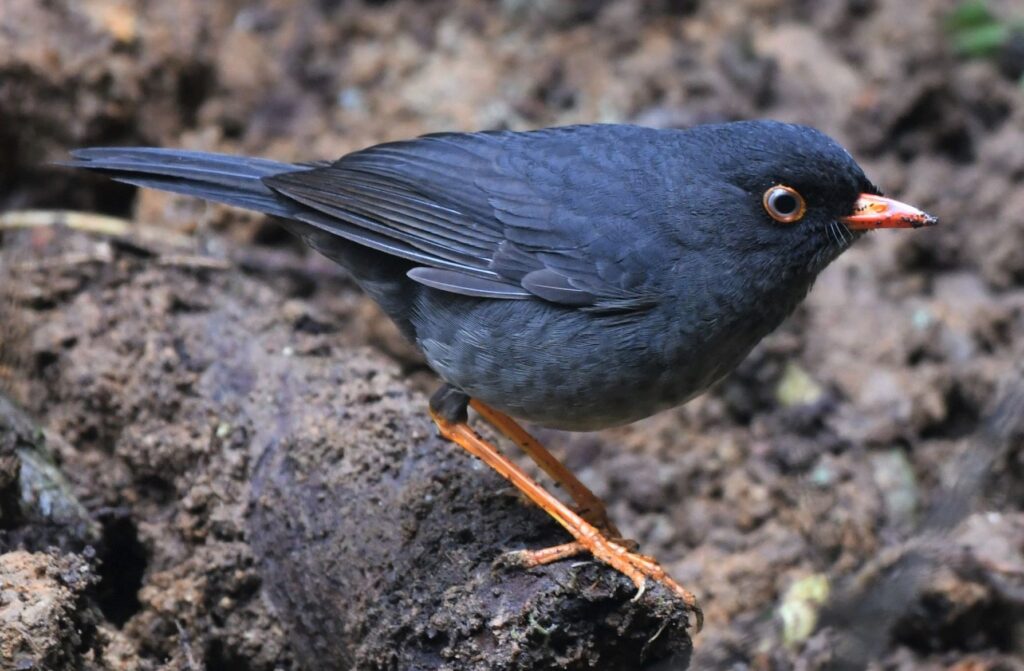
The drive from Samara to Santa Elena – Monteverde, covering a distance of about 135 km, took four hours. A series of narrow mountain roads, often with slow trucks, slowed me down a bit. The elevation gain between the two locations was significant (sea level to 1,400 m), along with associated changes in the weather and life zones (hot and dry on the coast, to cool and wet in the mountains; subtropical dry forest transitioning to montane cloud forest). Of course, it was precisely those physiographic differences that drew me to this area. The Santa-Elena- Monteverde bird list included numerous species restricted to the highlands, and a fairly large number of birds that I would not see elsewhere in Costa Rica.
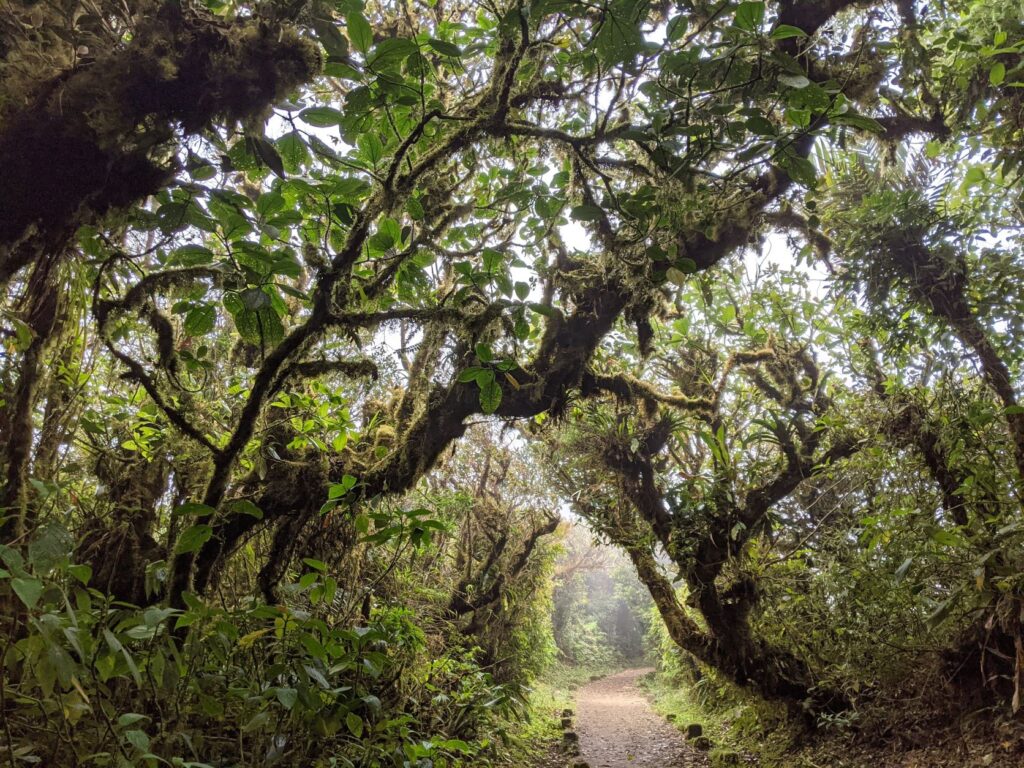
I checked into the Arco Iris Lodge, located in the middle of the small town of Santa Elena. The staff and facilities were superb. Several cafes and restaurants were within walking distance. As for most of the lodges I visited during the pandemic, this one also had plenty of vacancy.
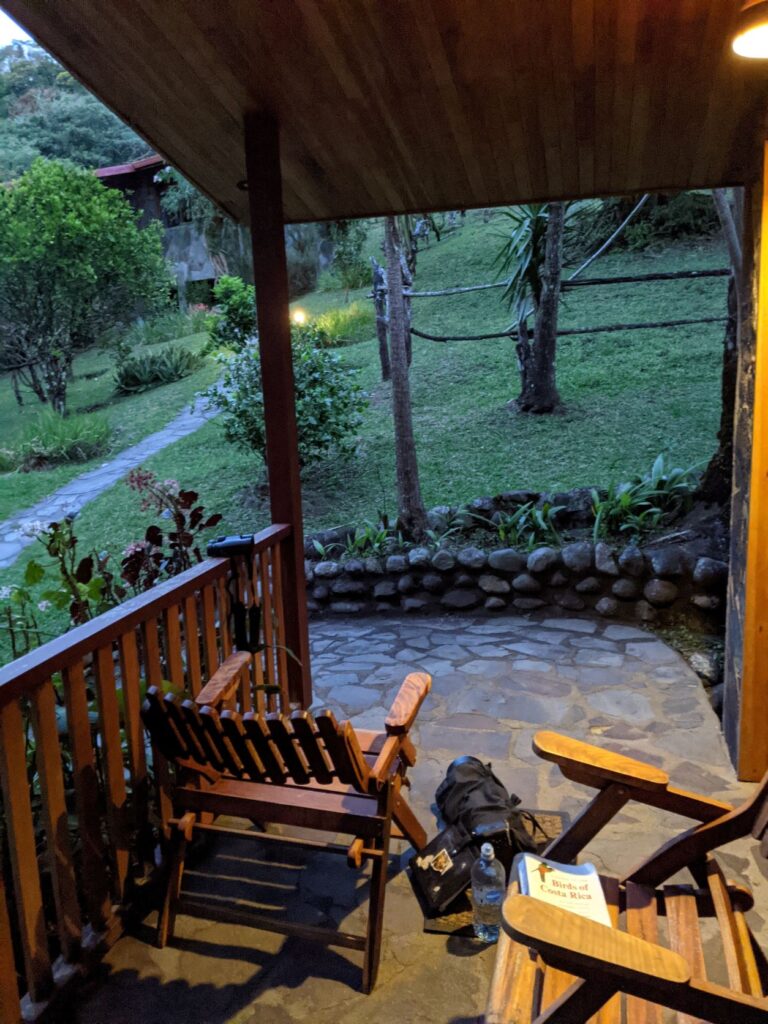
The management thoughtfully gave me a one-bedroom cabin that was well located for birding; a riparian forest on the south side, gardens with fruiting trees and shrubs elsewhere. A sitting area outside offered excellent views of the property; infact, I added several new birds to my local list by routinely being an armchair Ornithologist.
Soon after my arrival I was put into contact with a local bird guide, Victor Manuel Mejias Lopez, recommended by my photographer friend, Marek Jackowski, who had been at this lodge earlier. Marek’s recommendation was well founded. Victor and I made two birding excursions together over the next few days; a walking tour on the trails of the nearby Curi-Cancha Reserve and a driving tour of the Santa Elena Reserve and adjacent rural area.
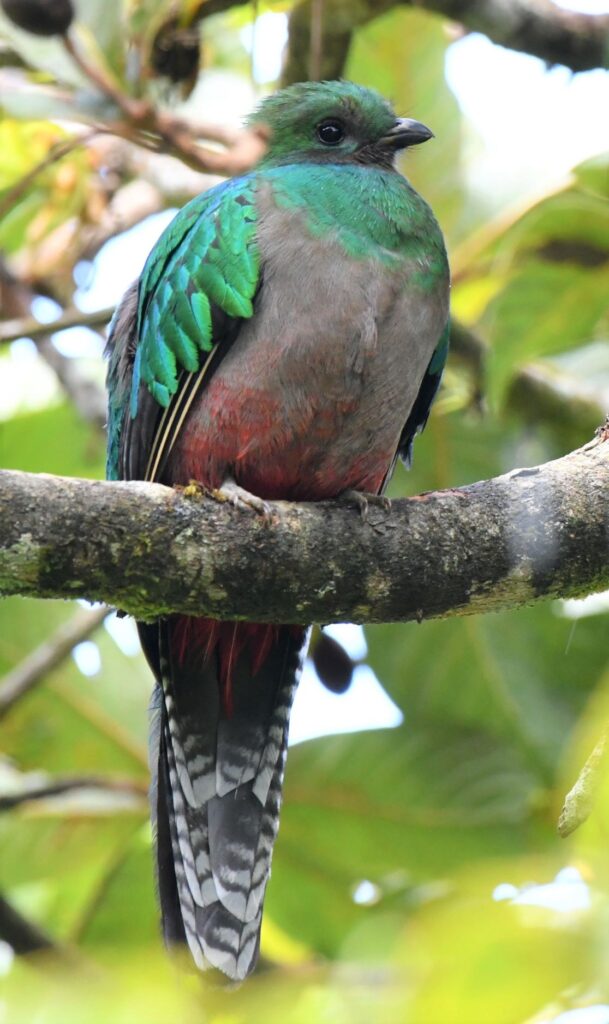
Both areas produced a good variety of montane specialties. Highlights included, Black Guan, Purple-throated Mountain-gem, Magenta-throated Woodstar, Stripe-tailed Hummingbird, Resplendent Quetzal, Collared Trogon, Prong-billed Barbet, Three-wattled Bellbird, Tufted Flycatcher, Brown-capped Vireo, Ochraceous Wren, Slaty-backed Nightingale Thrush, Elegant Euphonia and White-naped Brushfinch.
I made two visits to the Monteverde Cloud Forest Reserve, both without assistance from a local guide. In retrospect, that may have been a mistake. Although the cloud forest itself is hauntingly beautiful and well worth the visit, birding within the dense, misty forest was unproductive, as far as I could see.
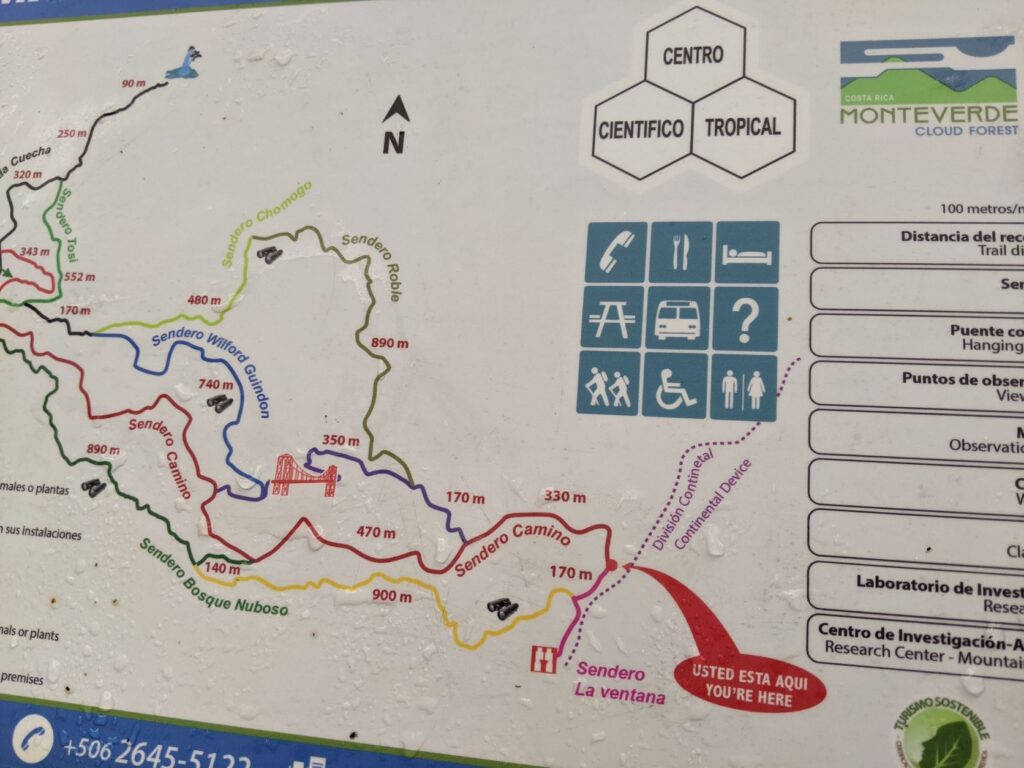
A consolation gift was being able to stand literally on the Middle America Continental Divide at 1600 m in elevation, where on a clear day, one might see both the Pacific and Caribbean Oceans. But clear days at this location are a rarity. All I could see was a couple of informative signs showing the location and describing the unique geography. Beyond that, wet foliage and fog. On the way back down to the entrance, a friendly park ranger stopped to chat and told me of a place where the nest of a Resplendent Quetzal had recently been found. Yes! This could be good. I still needed a photo of the elusive male quetzal. It was on the only trail in the park which I had not yet covered. Twenty minutes later, I arrived out of breath at the site, along with several other people and their naturalist guide, who had a spotting scope. None of us could find the nest or the bird. Evidently, I wasn’t the only one having difficulty finding birds here. Pretty well spent from a few hours on the mountain trails, I headed back to my car and then for a restful evening of journal entries and photo editing at the lodge.
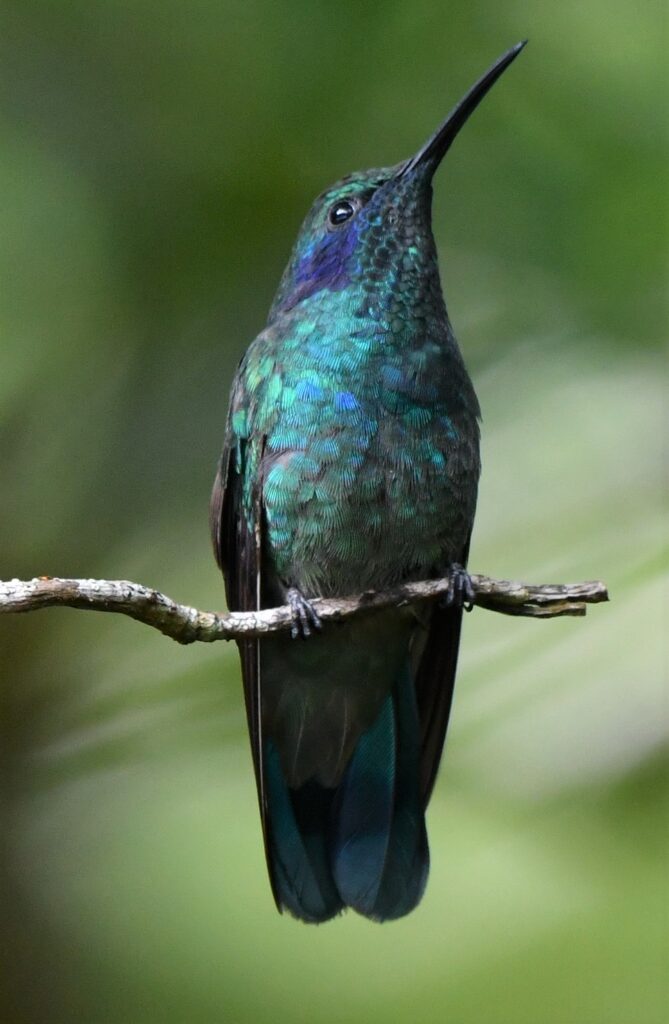
Three days earlier, I visited the Monteverde park entrance, and struggled to find a parking space along the only park access, a one-lane road. A surprisingly large crowd of college-aged kids were queued up to pay the $20 park entry fee. Avoiding what appeared to be a pedestrian traffic jam going somewhere to happen, I sought refuge in the adjacent Colibri Cafe. It was definitely the correct move. The sitting area offered close-up views of a variety of hummingbirds attending a series of suspended sugar-water feeders. This turned out to be one of the best places to study hummingbirds in the entire area. While sipping a cup of fine Costa Rican coffee, I was treated to multiple views of several species, including Green Hermit, Lesser Violetear, Coppery-headed Emerald and Green-crowned Brilliant.
Santa Elena – Monteverde Annotated Bird List (30 March – 12 April, 2021) Callyn Yorke
Explanation of Symbols
Abundance: Numbers following each species represent the maximum number of individuals found during a survey.
Frequency: C = Commonly found (or expected) during all or most surveys; FC = Fairly commonly found on about half of the surveys; UC = Uncommonly found less than half of the surveys; R = Rarely found; i.e. only once during the surveys (Note: some areas, i.e., AIV, COL, RSE, were surveyed only once).
Locations: AIL = Arco Iris Lodge gardens and adjacent riparian woodland; AIVP = Arco Iris Vacation Property, Santa Elena; CCR = Curi- Cancha Reserve; MVFR = Monteverde Forest Reserve, including the adjacent Colibri Cafe (COL). RSE = Reserva Bosque Santa Elena and adjacent rural roads through area.
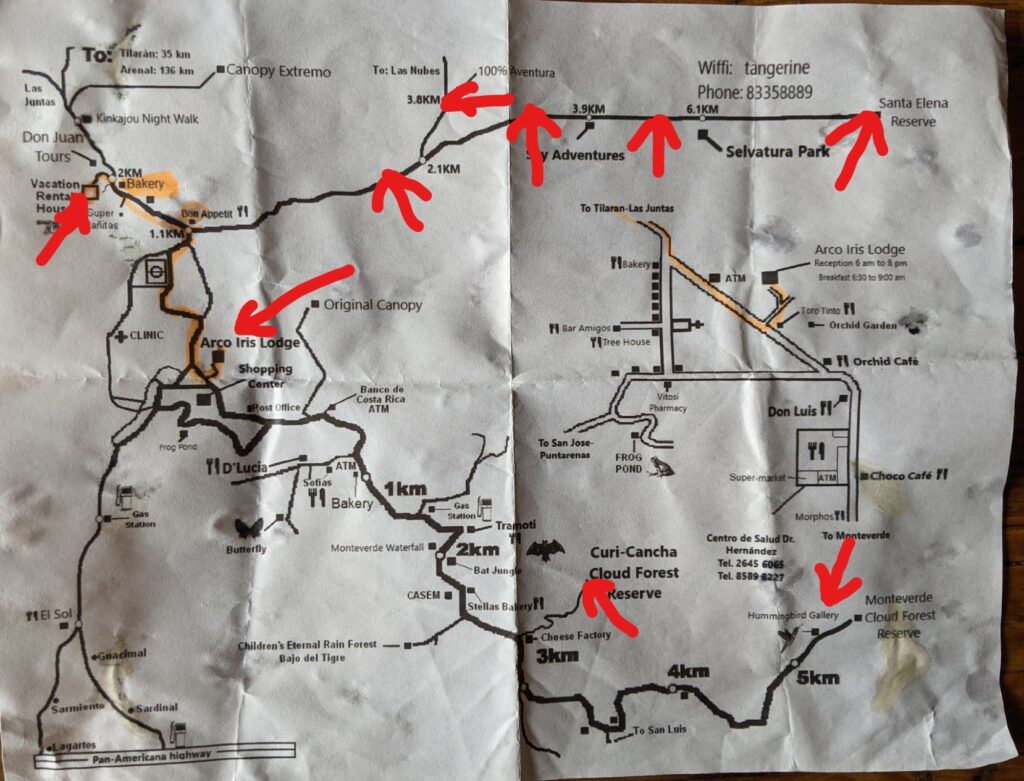
Systematics and Nomenclature follows Avibase and Clements (2021)
- Highland Tinamou Nothocercus bonapartei 1 vocal (unseen) RSE, FC
- Gray-headed Chachalaca Ortalis cinereiceps 2 gregarious, pairs in garden and riparian trees, AIL, C
- Crested Guan Penelope purpurascens 2 gregarious in large trees at edge of forest, CCR, FC
- Black Guan Chamaeptes unicolor 2 gregarious, shy, in large fruiting tree, CCR, UC
- Red-billed Pigeon Patagioenas flavirostris 6 gregarious, pairs flying over; in garden and forest trees, AIL, AIVP, CCR, RSE, C
- Ruddy Pigeon Patagioenas subvinacea 1 in flight, RSE, UC
- Short-billed Pigeon Patagioenas nigrirostris 1 on distant bare limb at edge of clearing, AIV, UC
- White-tipped Dove Leptotila verreauxi 1 in garden tree, AIL, UC
- Green Hermit Phaethornis guy 1 briefly visiting feeders, COL, FC
- Brown Violetear Colibri delphinae 1 edge of forest, RSE, R
- Lesser Violetear Colibri cyanotus 10 frequenting feeders, COL, CCR, C
- Green-crowned Brilliant Heliodoxa jacula 2 (m,f) at feeders, CCR, COL, C
- Purple-throated Mountain-gem Lampornis calolaemus 1 (m,f) at feeders COL, edge of forest, RSE, FC
- Magenta-throated Woodstar Philodice bryantae 2 at feeders, CCR, COL, C
- Violet Sabrewing Campylopterus hemileucurus 4 gregarious and dominant at feeders, CCR COL, C
- Coppery-headed Emerald Microchera cupreiceps 2 gregarious at feeders, CCR, COL, C
- Stripe-tailed Hummingbird Eupherusa eximia 2 gregarious at feeders, CCR, FC
- Blue-tailed Hummingbird Saucerottia cyanura 1 at feeder, CCR, UC
- Rufous-tailed Hummingbird Amazilla tzacatl 1 in flowering garden shrubs, AIL, FC
- Black Vulture Coragyps atratus 5 gregarious, ubiquitous, C
- Turkey Vulture Cathartes aura 3 gregarious, C
- Swallow-tailed Kite Elanoides forficatus 1 soaring over forest, CCR, R
- Gray Hawk Buteo nitidus circling above the forest, RSE, R
- Resplendent Quetzal Pharomachrus mocinno 2 (m,f) individuals perched nearly motionless in subcanopy at edge of forest; males relatively shy and retiring; relentlessly pursued by tour groups, CCR, FC
- Collared Trogon Trogon collaris 3 perched nearly motionless for long periods of time in subcanopy within and at the edge of the forest, CCR, C
- Lesson’s Motmot Momotus lessonii 2 pairs in small, fruiting trees, edge of clearing at park entrance, garden, CCR, AIL, C
- Prong-billed Barbet Semnornis frantzii 1 excavating a nest cavity in the trunk of a large tree near the edge of the forest, RSE, R
- Northern Emerald Toucanet Aulacorhynchus prasinus 4 two pair, separated by 200 m or more on different trails, engaged in courtship and/or nesting behavior, MVFR; an individual using a cavity for roosting each evening in a dead garden tree, AIL, C
- Keel-billed Toucan Ramphastos sulfuratus 2 gregarious, vocal in tall trees in second-growth woodland, AIL, RSE, CCR. UC
- Hoffmann’s Woodpecker Malanerpes hoffmannii 3 vocal, gregarious in gardens, second-growth and forest edge, ubiquitous, C
- Pale-billed Woodpecker Campephilus guatemalensis 1 in trees at entrance, CCR, R
- Lineated Woodpecker Dryocopus lineatus 1 vocal (unseen) riparian forest, AIVP, R
- Orange-chinned Parakeet Brotogeris jugularis 5 vocal, gregarious, second-growth, gardens, forest edge, ubiquitous, C
- Crimson-fronted Parakeet Psittacara finschi 2 in trees at edge of clearing, AIVP, UC
- Olivaceous Woodcreeper Sittasomus griseicapillus 2 on trunks of trees in the forest, CCR, UC
- Streak-headed Woodcreeper Lepidocolaptes souleyetii 2 in garden trees, second-growth and forest edge, uiquitous, C
- Three-wattled Bellbird Procnias tricarunculatus 6 vocal, pairs in subcanopy of tall forest trees, CCR, C
- Black and White Becard Pachyramphus albogriseus 2 a pair in a garden tree, AIL, R
- White-throated Spadebill Platyrinchus mystaceus 1 perched briefly in upper mid-level of forest near a stream, MVFR, R
- Mountain Elaenia Elaenia frantzii 1 in trees at edge of woodland and pasture, RSE, UC
- Mistletoe Tyrannulet Zimmerius parvus 2 often in pairs in shrubs and low garden trees, one found on ground, apparently with an injured wing, AIL, FC
- Tufted Flycatcher Mitrephanes phaeocercus 2 individuals perched and sallying from middle to lower mid-level of forest, CCR, FC
- Western Wood Pewee Contopus sordidulus 1 in trees at edge of clearing, CCR, UC
- Eastern Wood Pewee Contopus virens 2 individuals on fences, and small trees at edge of pastures, gardens RSE, AIL, FC
- Tropical Pewee Contopus cinereus 1 in tall trees at edge of riparian forest and garden, AIL, FC
- Yellow-bellied Flycatcher Empidonax flaviventris 1 on lower-mid level perch at edge of clearing, CCR, R
- Yellowish Flycatcher Empidonax flavescens 2 lower to upper mid-level of forest, CCR, FC
- Eastern Phoebe Sayornis phoebe 1 perched on fence at edge of pasture, RSE, UC
- Dusky-capped Flycatcher Myiarchus tuberculifer 2 garden and second-growth trees, forest edge, ubiquitous, FC
- Great Crested Flycatcher Myiarchus crinitus 1 at edge of forest clearing, CCR, UC
- Brown-crested Flycatcher Myiarchus tyrannulus 2 in a variety of garden trees and edges of forest clearings, CCR, AIL, RSE, FC
- Great Kiskadee Pitangus sulphuratus 3 vocal, active in gardens and forest edge, ubiquitous, C
- Social Flycatcher Myiozetetes similis 2 in trees at edge of clearings, gardens, AIL, AIV, CCR, RSE, FC
- Sulphur-bellied Flycatcher Myiodynastes luteiventris 3 gregarious, vocal in tall trees in gardens and edge of forest clearings, AIL, CCR, FC
- Piratic Flycatcher Legatus leucophaus 2 gregarious, a pair sallying to low shrubs and trees in garden, AIL, UC
- Tropical Kingbird Tyrannus melancholicus 2 on utility wires in open areas, AIL, CCR, RSE, FC
- Philadelphia Vireo Vireo philadelphicus 1 in flowering garden tree, AIL, UC
- Brown-capped Vireo Vireo leucophrys 1 in garden trees and edges of forest clearings, AIL, CCR, UC
- Yellow-green Vireo Vireo flavoviridis 1 in canopy of riparian trees, AIL, CCR, RSE, FC
- Brown Jay Psilorhinus morio 3 gregarious in fruiting garden tree, AIL, edge of forest, CCR, C
- Blue-and-White Swallow Pygochelidon cyanoleuca 4 flying over open areas of garden and adjacent town, AIL, C
- Southern Rough-winged Swallow Stelgidopteryx ruficollis 2 a pair flying low, back and forth over a pasture, RSE, UC
- Gray-breasted Martin Progne chalybea 4 gregarious, flying over open areas, AIL, RSE, C
- Southern House Wren Troglodytes musculus 2 vocal, active along fence line and in garden shrubs, AIL, CCR, C
- Ochraceous Wren Troglodytes ochraceus 1 active near ground in flowering shrubs at edge of clearing, CCR, UC
- Rufous-and-white Wren Thryophilus rufalbus 2 active at edge of forest, CCR, FC
- Cabani’s Wren Cantochilus modestus 1 active at edge of large forest clearing, CCR, UC
- Gray-breasted Wood-Wren Henicorhina leucophrys 1 vocal at edge of forest, RSE, FC
- Black-faced Solitaire Myadestes melanops 1 perched in lower middle level of forest, SRE, MVFR, FC
- Slaty-backed Nightingale-Thrush Catharus fuscater 1 investigating mossy ditch next to recent roadside excavations at park entrance, RSE, R
- Black-headed Nightingale Thrush Catharus mexicanus 1 in lower mid-level of forest, RSE, UC
- Swainson’s Thrush Catharus ustulatus 2 forest floor, lower middle and edge of clearings, CCR, RSE, C
- Mountain Thrush Turdus plebejus 1 vocal in forest near trail, RSE, UC
- White-throated Thrush Turdus assimilis 1 lower middle level of forest, CCR, RSE, FC
- Clay-colored Thrush Turdus grayi 3 vocal, active on ground in gardens, second-growth, edge of forest, ubiquitous, C
- Elegant Euphonia Euphonia elegantissima 1 (m) active in outer canopy of large fruiting tree in clearing, CCR, R
- Yellow-crowned Euphonia Euphonia luteicapilla 2 pairs active in fruiting garden trees and at edge of forest clearings, AIL, CCR, FC
- Yellow-throated Euphonia Euphonia hirundinacea 1 eating small red fruits of a garden tree, AIL, FC
- Common Chlrospingus Chlorospingus flavopectus 6 individuals active on outer canopies of forest edge, RSE, CCR FC
- Chestnut-capped Brushfinch Arremon brunneinucha 2 in second-growth at edge of forest, CCR, FC
- Rufous-collared Sparrow Zonotrichia capensis 8 gregarious on ground and grass in gardens and clearings, AIL, AIV, RSE, C
- White-eared Ground-Sparrow Melozone leucotis 2 a pair active on trail through second-growth clearing, CCR, RSE, AIL, FC
- White-naped Brushfinch Atlaptes albinucha 1 active in forest near clearing, CCR, UC
- Yellow-thighed Brushfinch Atlaptes tibialis 2 a pair on edge of forest trail, CCR, R
- Chestnut-headed Oropendola Psarocolius wagleri 2 gregarious, a pair with a large, pendant nest in a large tree at the edge of a forest clearing, CCR, C
- Streak-backed Oriole Icterus pustulatus 2 active in garden trees, AIL, FC
- Bullock’s Oriole Icterus bullockii 2 (m,f) active in garden flowering trees, AIL, FC
- Baltimore Oriole Icterus galbula 2 (m,f) active in garden flowering trees AIL, RSE, C
- Melodius Blackbird Dives dives 2 vocal, active in garden trees, AIL, FC
- Great-tailed Grackle Quiscalus mexicanus 10 (m,f) gregarious, vocal, in clearings, gardens, towns, farms, AIL, RSE, C
- Tennessee Warbler Leiothlypis peregrina 1 active in canopies of flowering garden trees, AIL, C
- Yellow Warbler Setophaga petechia 2 (m,f) active in canopies of garden and riparian trees, often with TEWA, AIL, C
- Wilson’s Warbler Cardellina pusilla 1 (m) active in understory at edge of forest, CCR, FC
- Slate-throated Redstart Myioborus miniatus 2 (m,f) active on and near the ground at edge of forest clearings, CCR, C
- Summer Tanager Piranga rubra 2 (m,f) active in a variety of garden shrubs and trees and forest edge, ubiquitous, C
- Blue-gray Tanager Thraupis episcopus 2 active in flowering trees and tall shrubs, AIL, AIV, CCR, C
- Palm Tanager Thraupis palmarum 2 active in a variety of flowering trees and shrubs, AIL, AIV, CCR, RSE, C
- Silver-throated Tanager Tangara icterocephala 2 foraging in outer canopy of fruiting tree at the forest edge, RSE, R
- Blue Dacnis Dacnis cayana 2 (m,f) foraging actively in fruiting tree in forest clearing, CCR, UC
- Red-legged Honeycreeper Cyanerpes cyaneus 2 active in outer canopies of fruiting garden trees, AIL, FC
- Bananaquit Coereba flaveola 1 frequenting feeders with hummingbirds, COL, FC
- Yellow-faced Grassquit Tiaris olivaceus 4 gregarious, active on grass in gardens and roadside scrub, AIL, C
- Buff-throated Saltator Saltator maximus 1 in canopy of tall riparian tree, AIL, R
Escazu, San Jose 12 -13 April, 2021 Elevation 1055 m Callyn Yorke
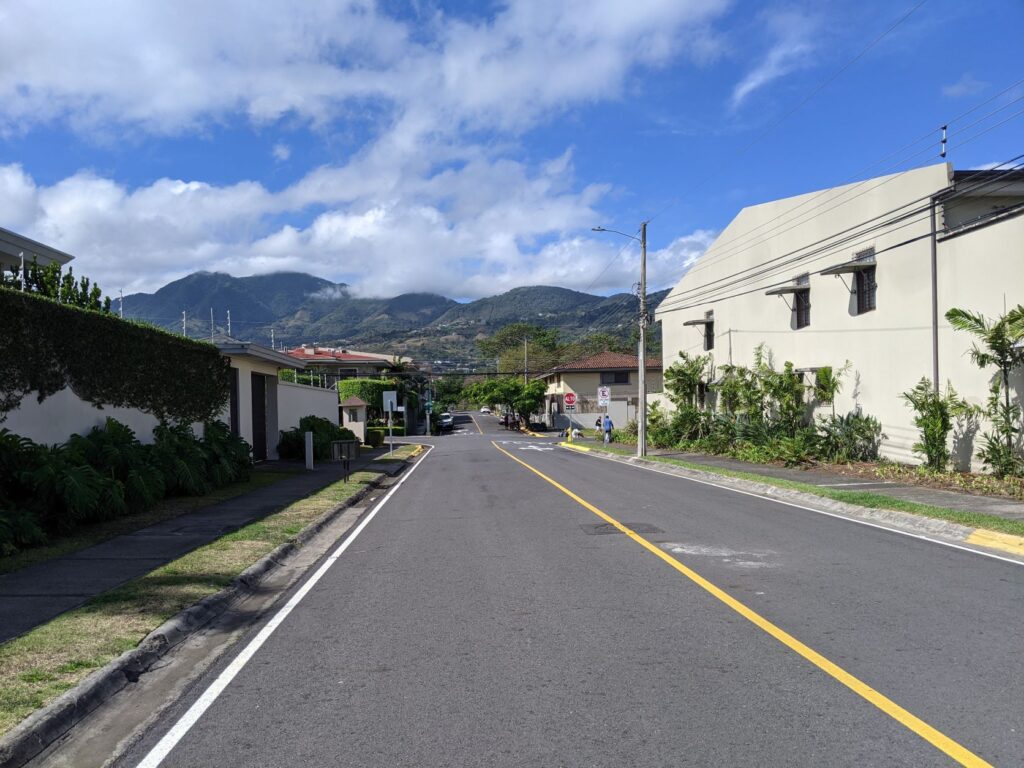
I spent two nights in this pleasant suburb of the capital city, San Jose, for a business meeting with my friend Kurt Schmack, owner of the Laguna del Lagarto (LDL) lodge in Boca Tapada, CR. Kurt and I were scheduled to meet with his attorney to discuss legal issues regarding the Loma Lapa Verde property next to LDL.
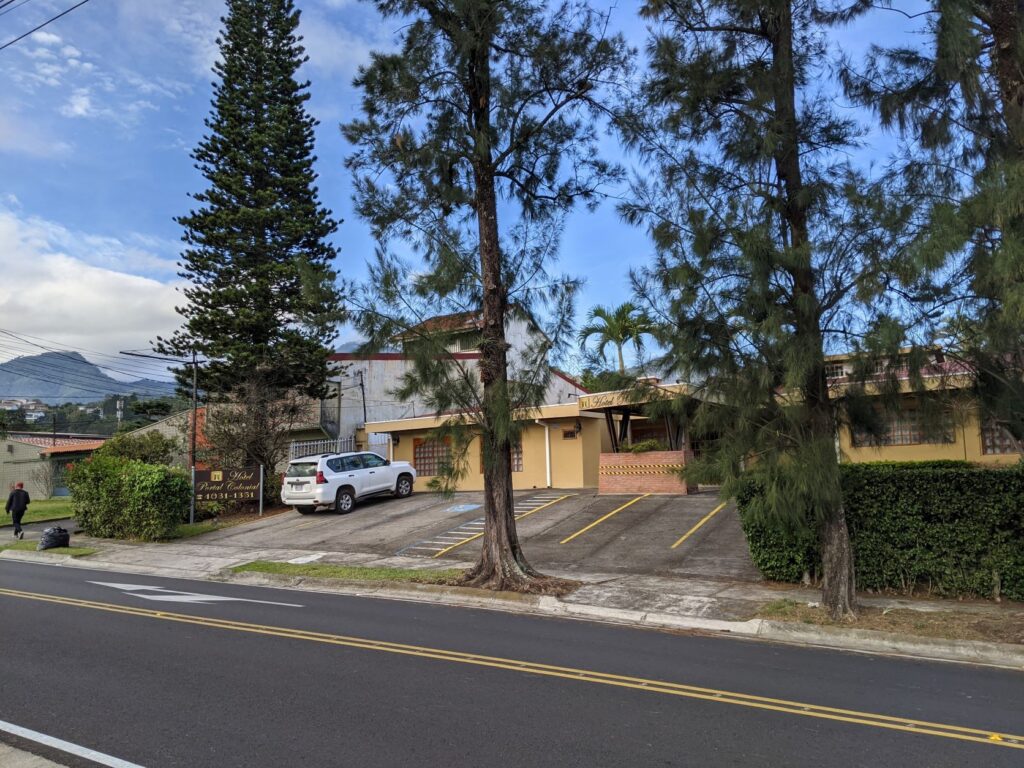
The next day our business was concluded and everything went well, punctuated by a little early morning birding in Escazu. Most of the following day I would driving to the Danta Corcovado Lodge, Peninsula de Osa, Puntarenas.
While in Escazu, I stayed at the Hotel Colonial Portal (formerly Pine Tree Inn). This had been where the AVC Tropical Biology class had stayed on our first day in January, 1999. Kurt met us there with transportation for our tour, which included Volcan Poas, Volcan Arenal and finally, the newly built Laguna del Lagarto Lodge. For most of the students, this was their first time out of the United States. The quiet little suburb of Escazu and modest accomodations of the Pine Tree Inn, made for a relatively soft landing. That was some time ago with many fond memories for all of us, I’m sure.
Indeed, twenty-two years had passed since I walked the streets of Escazu early one morning before our class assembled in the dining room for breakfast. Without access to my field notes from that day, I now had only a vague recollection of what birds were found in the neighborhood and, except for the pine trees in front of the hotel, nothing looked especially familiar. I would simply be wandering around on the streets as a stranger, mostly lost, peering into people’s yards and scanning the many large trees. Luckily, there was a nearby series of small urban parks bordering a riparian greenbelt. A few residents, out for an early morning walk with their dogs, had them leashed and well controlled. Everyone smiled and appeared to recognize what I was doing there.
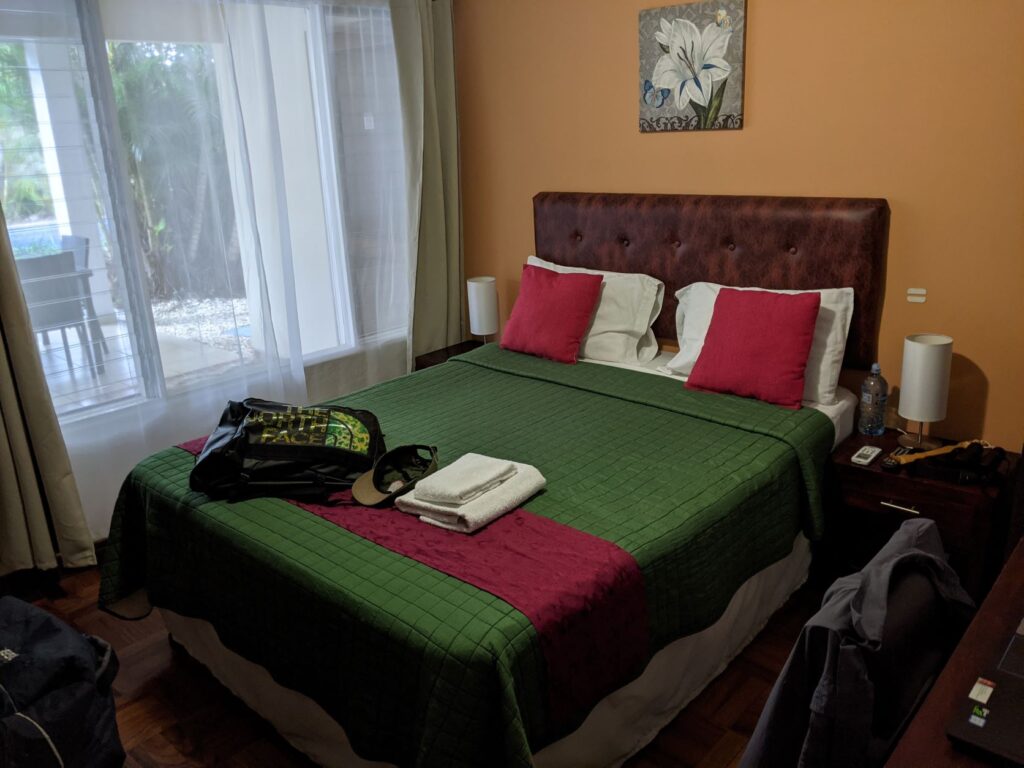
I was beginning to like this town. If I had to live in the Costa Rican capitol, Escazu might be a good choice. The quiet, upscale, internationally hip enclave was surprisingly birdy, particularly in and around a series of small parks bordering the greenbelt. By 0930 hrs. I had found 39 species. Not bad for a morning of casual urban birding. Highlights included, Vaux’s Swift, Olive-throated Parakeet, Lesser Elaenia, Blue-gray Saltator and Blue Grosbeak.
Escazu Annotated Bird List 13 April, 2021 Callyn Yorke
Locations: BP = Buenavista Park; CP = Corcori Park; LBP = La Boa Park; SGL = Streets, residential gardens and weedy vacant lots
Systematics and Nomenclature follows Avibase and Clements (2021)
- Red-billed Pigeon Patagioenas flavirostis 1 in a large tree, BP
- Inca Dove Columbina inca 2 on ground, BP
- Common Ground Dove Columbina passerina 1 on a utility line, SGL
- White-winged Dove Zenaida asiatica 20 gregarious, ubiquitous
- Squirrel Cuckoo Piaya cayana 1 in a the subcanopy of an ornamental tree, CP
- Vaux’s Swift Chaetura vauxi 5 loosely gregarious, flying back and forth at heights of 50-100m over the neighborhood
- Plain-capped Starthroat Heliomaster constantii 1 perched on a utility line, SGL
- Gray-cowled Wood-Rail Aramides cajaneus 2 one carrying long strands of grass nest material in shady, streamside tall grass, BP
- Green Heron Butorides virescens nesting in ornamental trees outside of park entrance, CP
- Black Vulture Coragyps atratus 3 circling at 50 -100m over greenbelt, LBP
- Lesson’s Motmot Momotus lessonii 1 perched on low, horizontal limb of large tree inside park, BP
- Hoffmann’s Woodpecker Melanerpes hoffmannii 2 vocal in subcanopy of a large tree, BP
- Crimson-fronted Parakeet Psittacara finschi 4 gregarious while eating fruits from a large tree, BP
- Olive-throated Parakeet Eupsittula nana 1 (possibly more unseen) consuming fruit in the canopy of a large tree, LBP
- Amazona sp. 25, vocal, gregarious, distantly flying over the neighborhood, SGL
- Lesser Elaenia Elaenia chiriquensis 1 at a rather untidy nest on outer, lower limb (3 m) of large tree at the edge of the park, LBP
- Great Kiskadee Pitangus sulphuratus 6 vocal, in trees and on utility lines, ubiquitous
- Boat-billed Flycatcher Megarynchus pitangua 2 vocal, gregarious in canopy of large riparian tree, BP
- Social Flycatcher Myiozetetes similis 2 vocal, gregarious on utility line, SGL
- Tropical Kingbird Tyrannus melancholicus 4 vocal, gregarious on utility lines and in ornamental trees, SLG
- Vireo sp. c.f. V. philadelphicus 1 in outer canopy of an ornamental flowering/fruiting tree, LBP
- Blue-and-white Swallow Pygochelidon cyanoleuca 20 gregarious, flying 10- 30 m through neighborhood, SGL
- Gray-breasted Martin Progne chalybea 3 flying 20-50m over greenbelt and adjacent suburbs, LB
- Cliff Swallow Petrochelidon pyrrhonota 1 flying in same area with GBMA, but closer to a multi-story building
- Southern House Wren Troglodytes musculus 4 vocal, BP, SGL
- Rufous-naped Wren Campylorhynchus rufinucha 4 vocal, gregarious, active in lower branches of shade trees, BP
- Rufous-and-white Wren Thryophilus rufalbus 2 gregarious in dense streamside vegetation, BP
- Swainson’s Thrush Catharus ustulatus 1 in subcanopy of large tree, BP
- Clay-colored Thrush Turdus grayi 12 loosely gregarious, individuals and pairs on ground, ubiquitous
- House Sparrow Passer domesticus 1 (m) in fenced garden next to the front of a house, SGL
- Rufous-collared Sparrow Zonotrichia capensis 10 on ground in parks and gardens, ubiquitous
- Baltimore Oriole Icterus galbula 1 (m) in canopy of tall, flowering tree, BP
- Great-tailed Grackle Quiscalus mexicanus 4 (m,f) SGL
- Tennessee Warbler Leiothlypis peregrina 3 loosely gregarious, foraging in tall, fruiting tree, LB
- Yellow Warbler Setophaga petechia 2 (m,f) foraging in canopy of tall riparian tree, BP
- Summer Tanager Piranga rubra 1 (imm m, trans. molt) in tall fruiting tree, LB
- Blue Grosbeak Passerina caerulea 2 (m,f) a pair active in weedy vacant lot, SGL
- Blue-gray Tanager Thraupis episcopus 1 associated in a mixed species flock with SUTA, TEWA in a large fruiting tree, LB
- Blue-gray Saltator Saltator coerulescens 3 gregarious in ornamental trees, SGL
Danta Corcovado Lodge, Osa Peninsula, Puntarenas 15-20 April, 2021 Callyn Yorke

A good network of paved highways connected San Jose to Puerto Jimenez and there was very little traffic once I reached the Osa Peninsula. But locating the relatively secluded Danta Corcovado Lodge required stopping in the nearby village of La Palma to ask for directions. Upon arrival at the lodge, a young Costa Rican woman introduced me to the nearly vacant yet spotlessly clean facilities (shoes were not permitted to be worn in the dining area) and showed me to my room.

Nearly the entire lodge had been built within a lowland rainforest, giving a first impression that the forest and its inhabitants were the main attraction. That turned out to be most definitely the case. Danta Corcovado was a naturalist’s dream.
All of the accomodations were separate bungalows, that had been artistically designed and decorated by the owner. My habitacion was shaped like an ovenbird’s nest, essentially without any interior corners.
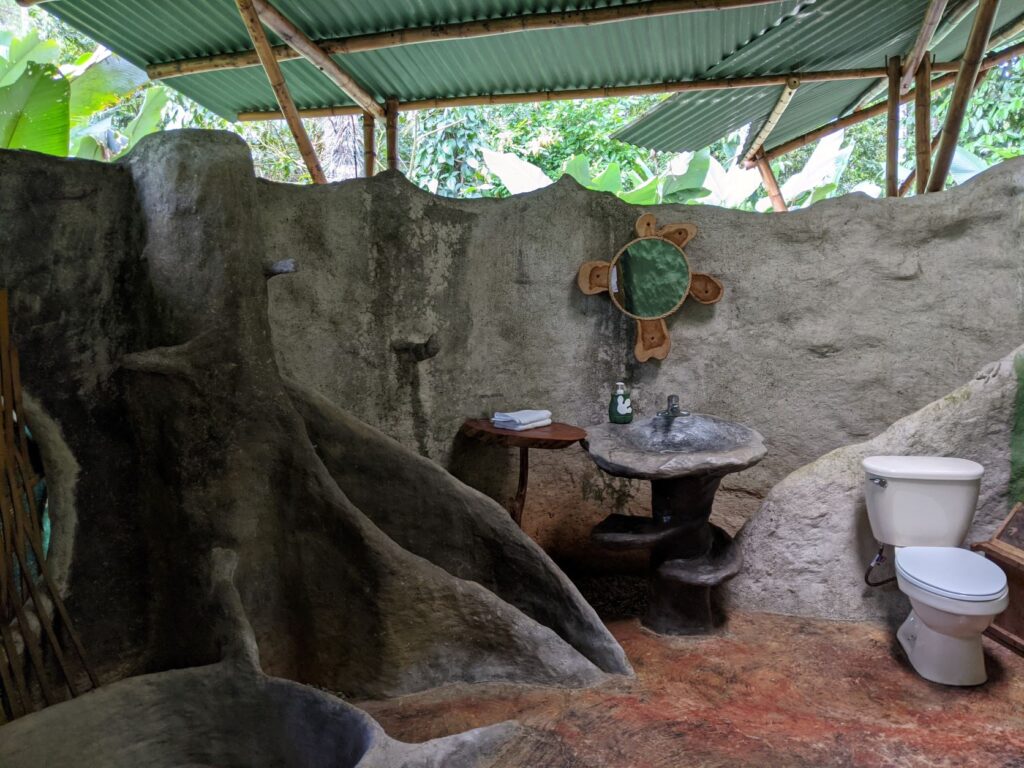
The bathroom, which looked like a desgn inspired by the Flintstones TV series, was open to the outside with a large, airy gap between a corrugated steel roof and concrete wall. The bathroom door was on a spring loaded hinge to keep mosquitoes and other flying critters out of the bedroom at night. Best of all, was a sitting area outside the room, where I could wait for birds and other wildlife to show themselves, as they made their daily rounds through the forest and garden. One afternoon, a troupe of the coastal endemic Red-backed Squirrel Monkey, appeared at such close range that I had to move further away with my big camera lens to get them into focus.
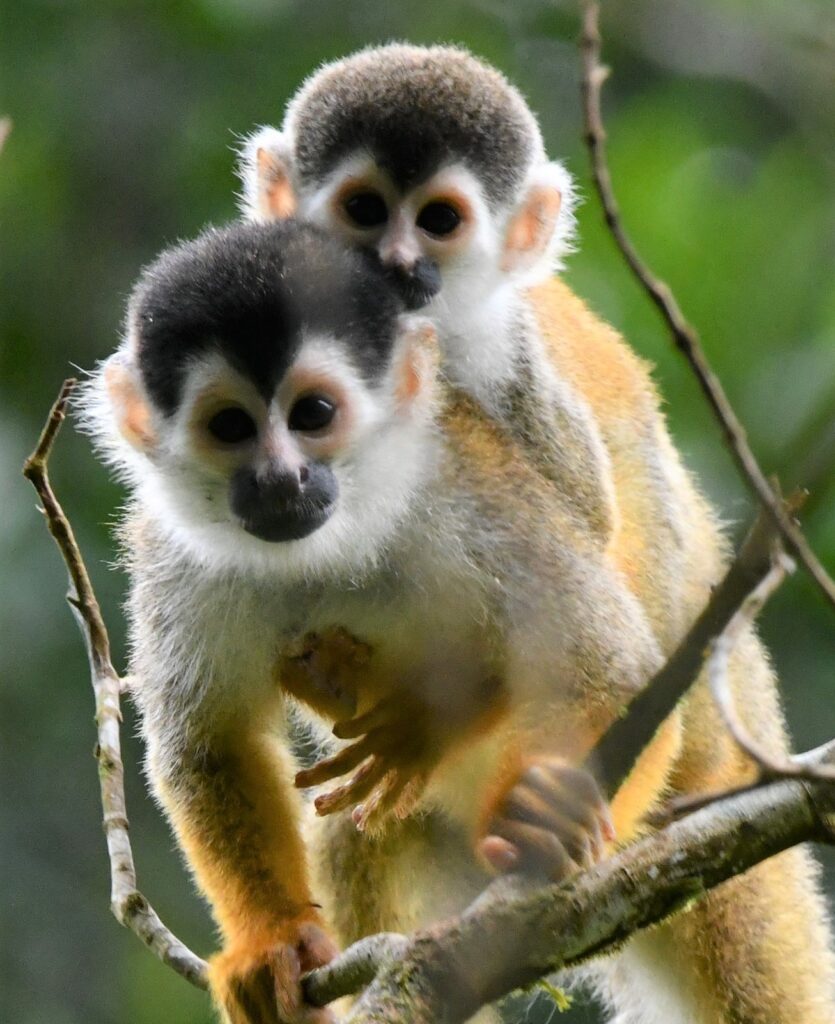
There was a well-maintained and signed trail system on the property leading to an elevated observation platform where mixed species flocks of tanagers could be seen at eye level, early in the morning. Columns of leaf-cutter ants\ accompanied me along the way.
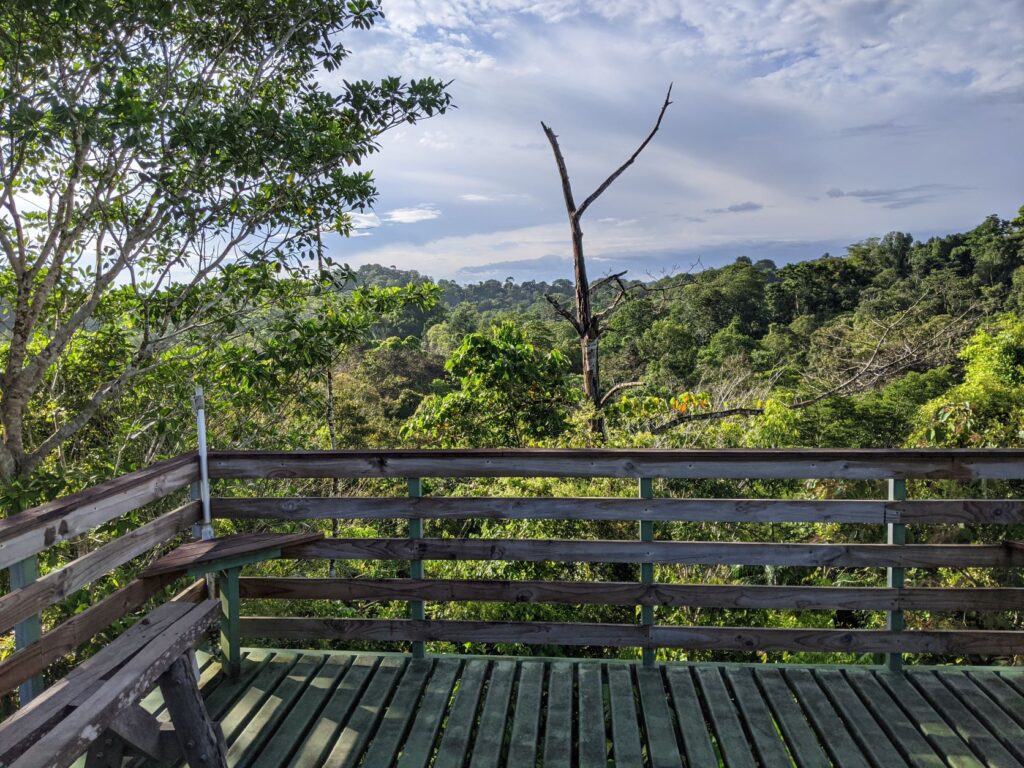
Many of the birds appeared relatively habituated to visitors with cameras and binoculars, allowing for some good photo opportunities.
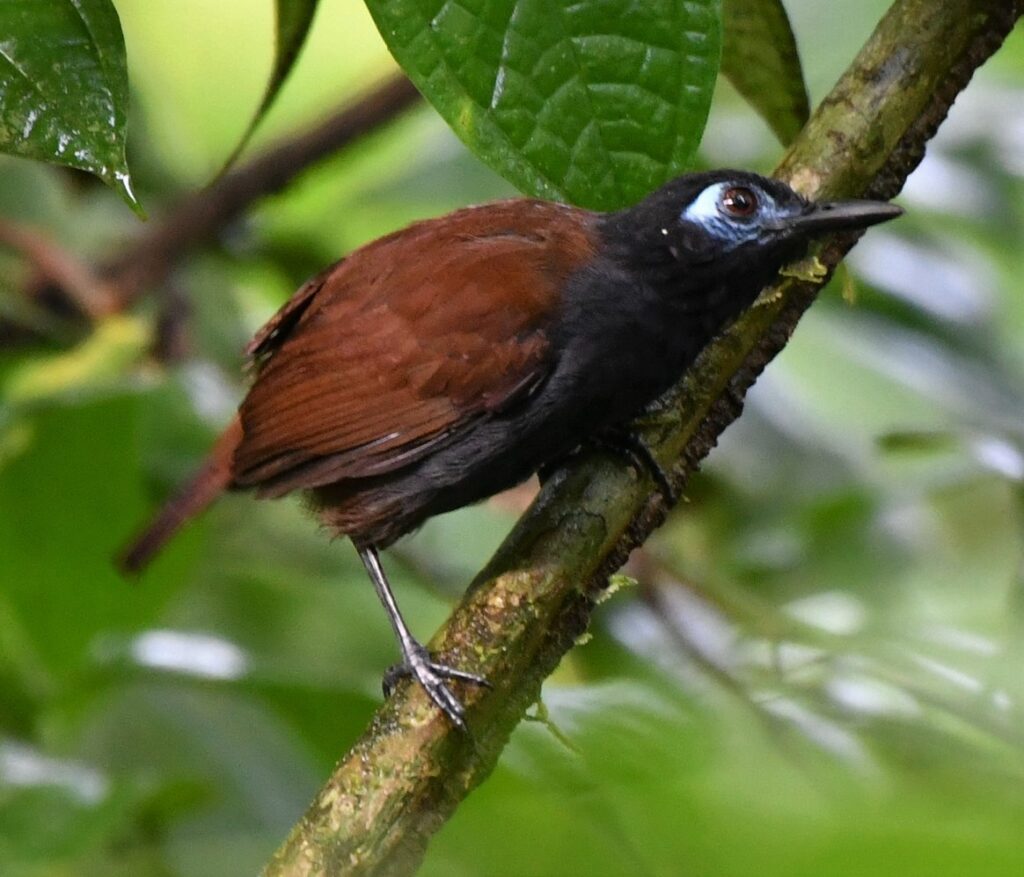
I was especially keen to photograph two antbirds, Black-hooded Antshrike and Chestnut-backed Antbird, that would otherwise be scarcely encountered in the forest; here the birds were habituated and approachable. Both of those species appeared at the same location along one of the trails each morning at 6:30 am. Once I learned their habits, it was fairly easy obtaining photos of them.
The main town of Puerto Jimenez was about a forty-minute drive south of DCL and I found it a very worthwhile side-trip on two occasions. At low tide, an extensive sandflat and mangrove was exposed, which attracted a variety of shorebirds.
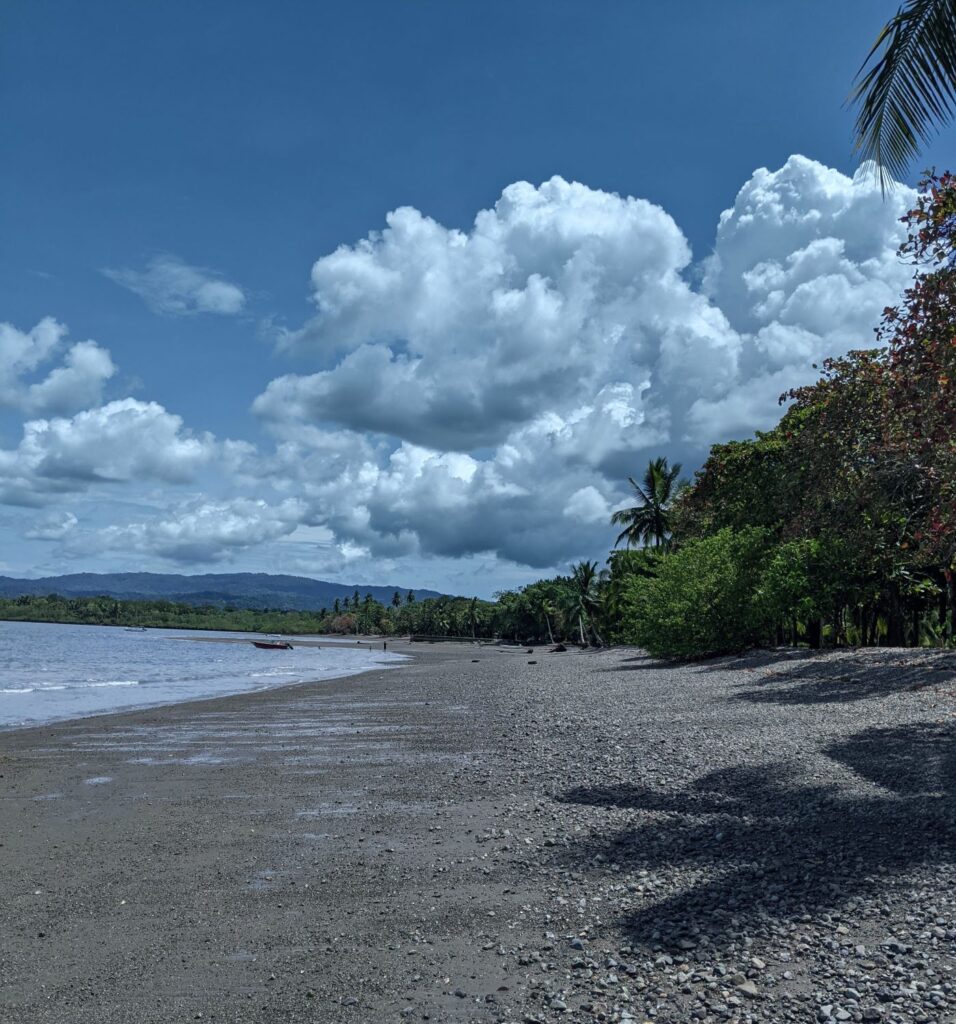
One afternoon, I spotted a group of gulls and terns in the distance, resting at the water’s edge. I couldn’t quite make out the specific identifications from the shady table where I was having lunch. The only option was to walk out on the fully exposed sandflats to be close enough to photograph the birds before they bolted. Among the Laughing Gulls, Royal Terns and Sandwich Terns, were several absolutely stunning Franklin’s Gulls in full breeding plumage.
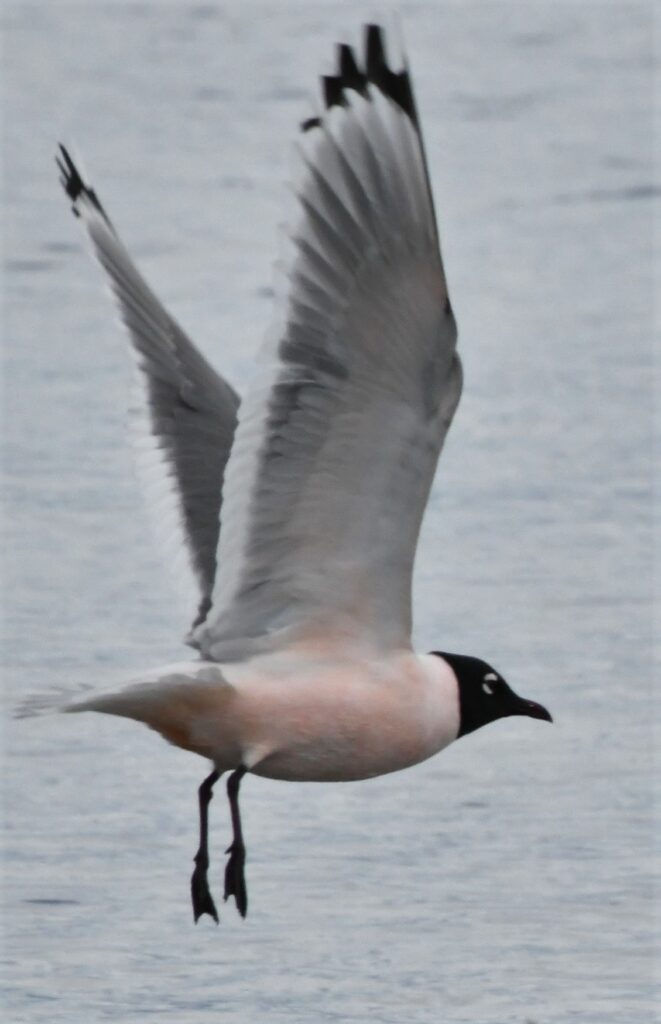
Not surprisingly, the wary birds flushed before I could get a really clear photo. Nonetheless, Just seeing Franklin’s Gull in that dazzling alternate plumage was unforgettable. This flock had evidently made a pit stop in Puerto Jimenez, northbound to their breeding grounds in Montana, North Dakota and Canada.
Having seen a bit of the eastern and northern Osa Peninsula and a few of its endemic species, I was eager to explore the southern and western portions. What happened next was one of the highlights of the entire two-month journey through Costa Rica. Below is a description of this particular side-trip, taken from my daily journal, as I related at the time to folks back in the States.
………………
I’m nearly finished with my CR journey. Yesterday I left this wonderful resort called Danta Corcovado in La Palma, Puntarenas. It’s been great photographing the birds and other aspects of nature in this relatively remote but not forgotten corner of Costa Rica, The other day, I drove a clockwise route from La Palma to the small coastal village of Carate (pronounced exactly like the kind of fight you don’t want to get into). And what a battle it was. I think it ended in a draw, almost literally. Here is a summary of what I found.
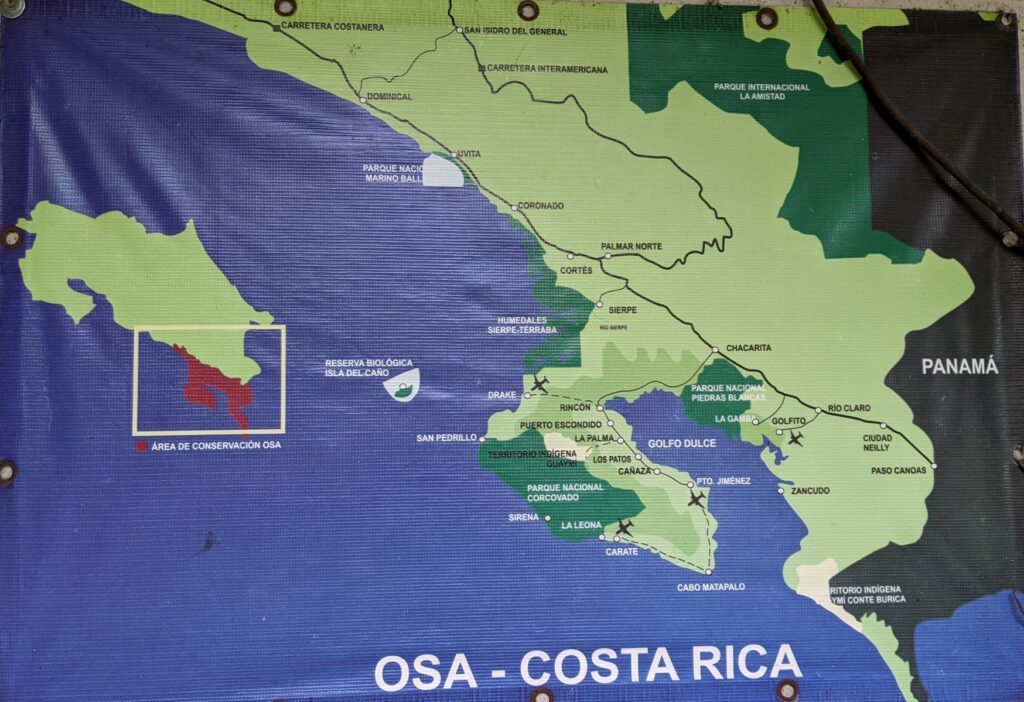
There is no such thing as a leisurely drive around the Osa Peninsula. I had little idea what to expect, aside from bad roads. Most of the southern peninsula is a mosaic of pastureland and humid evergreen rainforest leading right up to long stretches of coarse sandy beaches with world class surf breaks. Few tourists come here, except some adventurous surfers willing to brave the bull sharks, crocodiles, unforgiving rip currents, and Colombian drug traffickers searching for their lost shipments. Si, esta es un problema aquí.. A turtle biologist was found murdered along with a few locals who tried to hide some of the cartel’s missing stash. One of bodies was missing several fingernails. There aren’t many signs along the main road around the southern Osa Peninsula, but one of them should be a skull and crossbones stating the obvious: DON’T FUCK WITH THE CARTELS.
The roads were as bad and sometimes worse than I expected. Pothole craters big enough to hide small passenger cars, landslides, washed out bridges, mud as slick as snot, etc. This went on for many kilometers, without giving much incentive for me to stop and relax my grip on the wheel. Few birds were seen; a small flock of Yellow-headed Caracara standing on resting cattle, picking arthropods off their backs, gave me about the only opportunity for an interesting photo. But the birds flushed as soon as I turned off the growling diesel motor of the Landcruiser. I continued, looking for a sign or something indicating a point of interest. Nada. Only an occasional gated entry to a finca or fallen sign for an abandoned roadside cafe. This was the main road around the peninsula. Folks living out here needed not just a car to get into town, but one with high ground clearance, 4WD and a snorkel. This was a tour through about the most rural and remote part of Costa Rica I had ever seen.
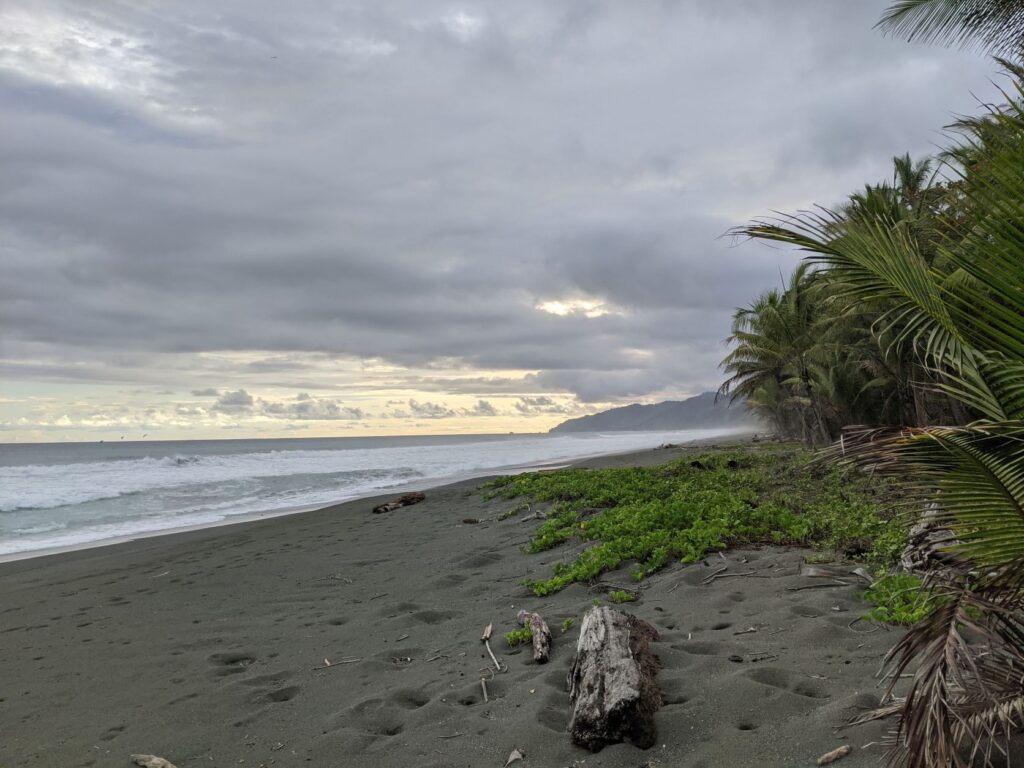
After about twenty kilometers of a bone-rattling ride, when at times the seatbelt seemed designed primarily to prevent occupants from catapulting through the roof, I came to a small wooden, hand-painted sign, announcing some sort of bird sanctuary 5 km ahead. Great. That should be interesting. But after six more brutally won kilometers, I found no further sign of the facility. Oh well, another casualty of the pandemic, I concluded. Then, 2 km further down the road, there it was, a well signed entrance road to this mysterious, unmapped bird sanctuary. A bigger sign spelled out all of the features, such as,: Endangered Bird Species Recovery and Rehabilitation; Natural History Museum, Tours, and finally, a $20 General Admission, $10 for Students. Wow. This was like wandering through the desert, dying of thirst and stumbling into a sign for Zeek’s Bar and Grill…
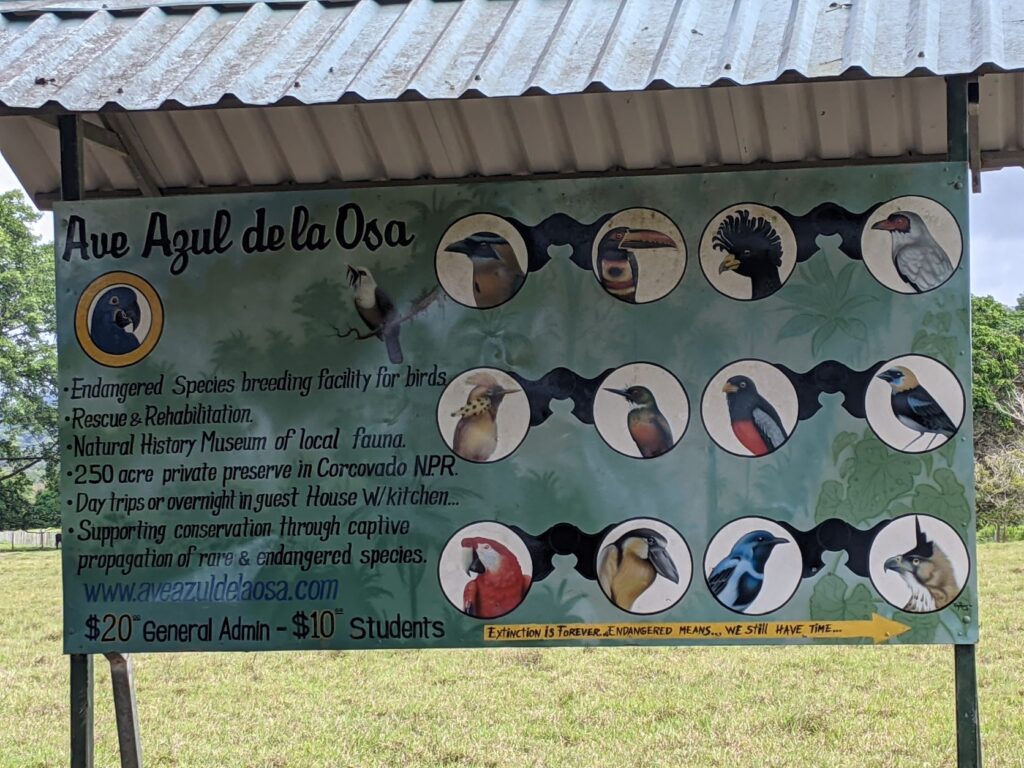
Frustratingly, the entry road went on and on into the hills, getting narrower and with tree limbs fallen from recent heavy rains, began to look nearly impassable, even for a Landcruiser. I pressed on and within a few minutes arrived at a homestead perched on an eroded embankment above a stream. Someone appeared briefly out front, then quickly disappeared. I reached in the back for my walking stick, expecting to be greeted by a frisky ranch dog.
Soon, a gentleman wearing shorts, t-shirt and bathroom sandals, came out to greet me. He looked at me with a curious gaze, as though I could be familiar. We exchanged names and I mentioned I had been driving in the area and had seen the sign for the facility, called Ave Azul de la Osa. He invited me into his home, a one-man construction project in progress – all native wood and stone frame structure with a surrounding deck overlooking a forest clearing with a perimeter of metal cages.
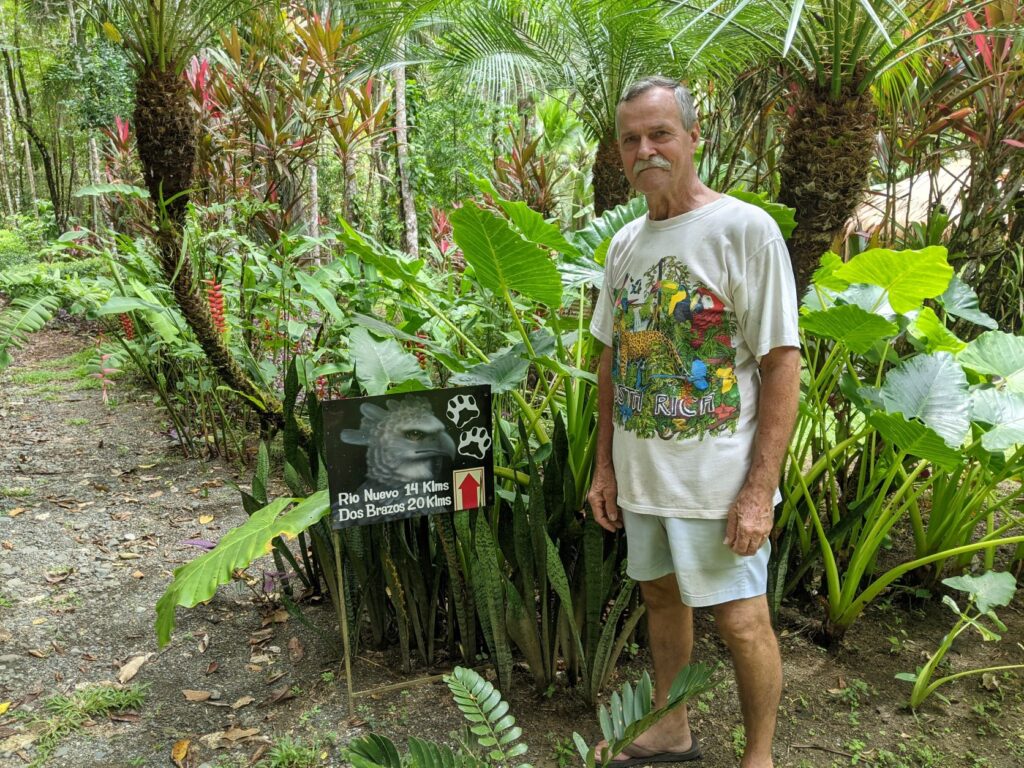
His name was Patrick Shawn Dunn. Now there was an Irish name. As it turned out, one of Patrick’s grandparents had immigrated from Ireland. At least we had that interesting historical coincidence as an introductory topic between two complete strangers; we shared a distant but common Irish ancestry. There was more. Patrick was a self-educated Zoologist. He designed and managed the first and only zoo in Kauai before it was destroyed by a hurricane some years ago. Patrick and his wife’s newly constructed home went with it. Incredibly, out of the pile of debris that was their home, only the bird egg collection remained intact. After months living in a tent, there was late arriving insurance money and little else. Divorce followed shortly thereafter. Patrick left the island, found this property in Costa Rica (100 hectares of mostly rainforest), and began rebuilding his life. Some years later, he remarried.
Unfortunately, things again went south for Patrick. His second wife loved Costa Rica but was stung by an urticating caterpillar and had a severe allergic reaction to the toxin. Subsequently, she had to return to the States where she developed a debilitating illness, myasthenia gravis. Patrick hasn’t seen her for three years and misses her very much. She wants to return to their life in Costa Rica but needs regular medical care. The Ave Azul home is 35 km from the nearest town, Puerto Jimenez, which is largely a dilapidated fishing village with a couple of seafood restaurants. There may be a medical clinic but I didn’t see one. And Patrick has no transportation, not even a motorbike. If a local rancher doesn’t pick him up on the main road, he must walk; the public bus broke down and quit the route altogether two years ago. Patrick lives in what most folks would call, remote isolation.
In fact, I was the first visitor Patrick had in over a year, except for his cousin Jack from South Carolina, who showed up one rainy evening on horseback and decided to move in. Jack, another aging pensioner, had his own hard luck story to tell. We sat at a small wooden table on the deck, Patrick, Jack and I, along with their rescued, still nameless dog, and a menagerie of exotic birds in small metal cages around the yard.
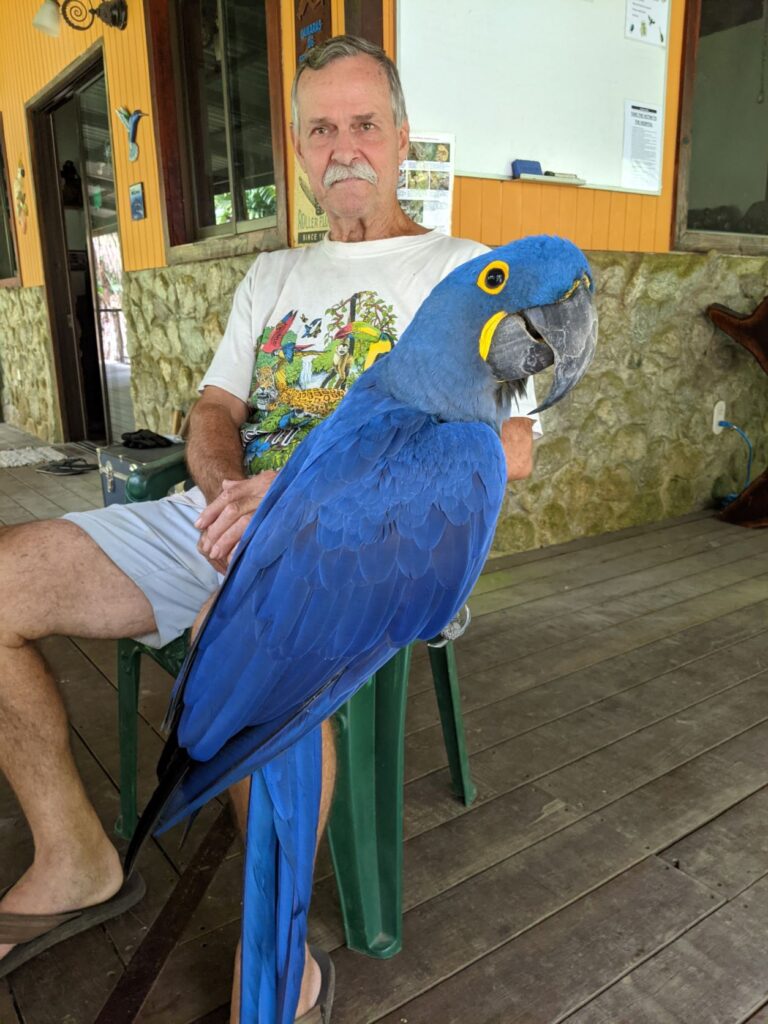
Patrick brought out his two favorites, third and fourth generation, hand raised macaws – a gorgeous Hyacinth (mascot of Ave Azul de la Osa) and a stunning Military Macaw. These birds, like the rest of his imported collection from the now defunct Kauai Zoo, had never known life in the wild. Jack began telling his story.
Jack, a native of South Carolina, had been living with his lifelong friend from college days in Charleston. His friend was a recovering drug addict and of rather unpredictable temperament. Nevertheless, Jack, a kind hearted fellow, insisted on nursing this man back to health. But one evening, his friend suddenly became angry with Jack, pulled out a pistol and shot Jack in the face.
After several weeks, Jack recovered well enough to leave the hospital. He still needed help. A service dog would be ideal but they were quite expensive and Jack was living solely on his monthly Social Security checks. He went to an online site, Go Fund Me, and managed to get a few hundred dollars, though it wasn’t enough for a service dog. So Jack began to consider his options. One of those was rather far-fetched. He could search for his long lost cousin of some 50 years, who was said to have moved to Costa Rica. And so off he went in search of Cousin Patrick.
A few months ago, Patrick, living alone with his birds and occasional wildlife visitors, including a full grown Terciopelo found on the stairway, heard a commotion outside. Visitors, tour groups and even locals had been absent for many months at Ave Azul de la Osa. Who could it possibly be? Patrick was and still is without a phone or internet connection. Imagine his surprise. What a joyous reunion that must have been. Jack had found his cousin. In fact, Jack was so happy to see Patrick, that he had another surprise for him. Jack indicated that this was the end of the line for him. Jack had decided to stay there, as in forever.
And so the two cousins somehow made the surprise permanent reunion work. They appeared to get along with each other just fine. They explained that Jack cooks the meals while Patrick tends to his birds and construction projects. Neither talk much, unless of course a visitor shows up. Especially if it is one interested in Zoology. It sometimes felt as if I had met two guys who hadn’t seen another human being for months. That actually wasn’t far from the truth.
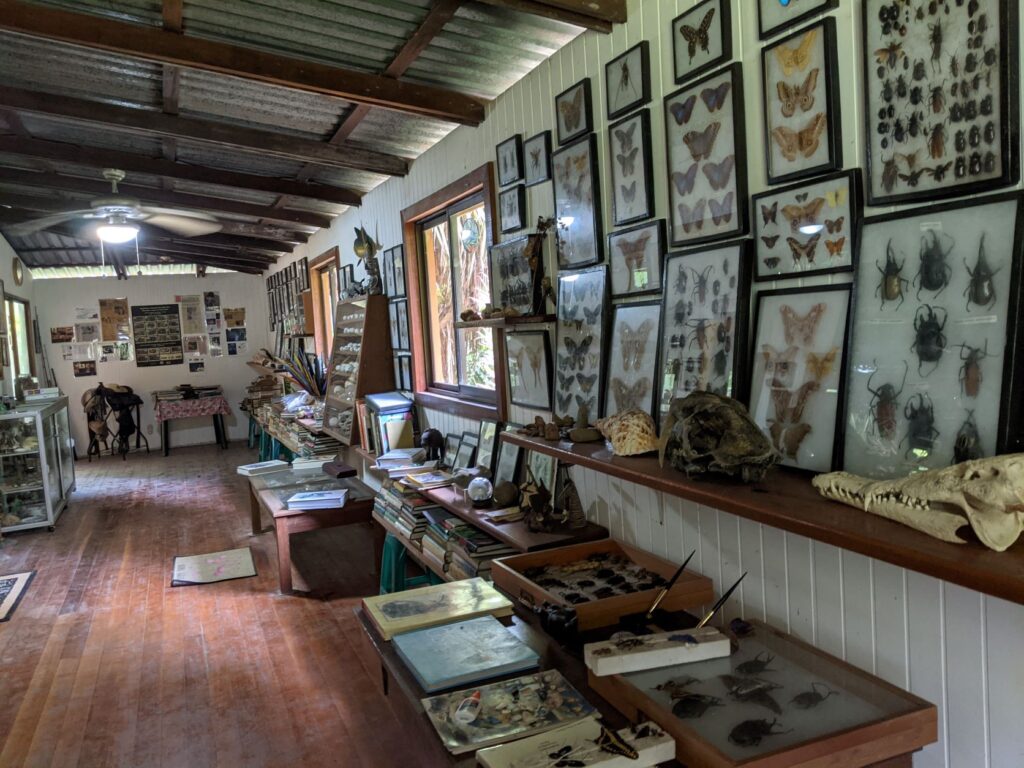
I was eager to see the museum composed of Patrick’s zoological specimens collected through the years from around the world. Patrick said he had a life bird list of more than 3,000 species. I believed him. Patrick had no difficulty recalling the names and locations of each of them. So it was for the rest of his extensive zoological collection – some of which was labeled, many specimens were not. No worries. Patrick could tell you exactly what it was, where and when he collected it, and if it was endangered or otherwise a highly sought after item. A very impressive museum, by any measure.
Included in the vast collection were preserved reptile specimens, like the fer-de-lance that bit his neighbor’s wife, who died in transit to the clinic. The Fer-de-Lance or Terciopelo (Bothrops asper), is the most common and most feared venomous snake in Costa Rica. Annual casualties due to its bite are around 200. If antivenin isn’t administered within an hour (the ‘golden hour’) chances of survival are slim to none. The only scarier snake in the region is the much rarer Bushmaster (Lachesis muta), The Latin name of that snake translates roughly to “Silent Death.” Ironically, Bushmaster would be a ‘Life Reptile’ for me, since I have never seen one in the wild.
One morning in their jungle house, Patrick’s wife awoke and put her foot out searching for her slippers on the floor next to the bed. She saw something dark next to them. It was a coiled Terciopelo that had come in out of the rain for a nap. Hello there. That was just one of many near casualties with venomous snakes and a variety of other critters that wandered into their house, including birds. Some of the close encounters were of the friendly kind. The next anecdote bordered on incredible and required proper documentation.
One day, Patrick was sure he saw a rare Black-hooded Antshrike in the yard. He went inside to check his copy of Stiles and Skutch for identification. As he sat at the table with the book opened to the page showing illustrations of antbirds, including the one in question, as if on queue, a Black-hooded Antshrike flew in and landed on the book. Dutifully, Patrick found a camera and documented the sort of thing one might expect to see in a Disney cartoon. He showed me the photo from his collection of almost equally incredible discoveries in Ave Azul de la Osa. Yep. It was indeed a Black-hooded Antshrike. Unbelievable but true. Although, it wasn’t quite clear to me from the photo if the bird was actually standing on the correct illustration in the book. Just another day in the life of a Zoologist. Patrick was the real deal. No doubt about it.
At the end of the day, I coudn’t stop thinking about Patrick and how extraordinary his life has been. Now, as a pensioner without his wife, transportation, a savings account (all of it spent on import permits, construction and daily maintenance of a dozen or more hungry birds) without visitors to support the nature center, an expired Costa Rica Visa, a partially constructed home, possibly washing away during the next rainy season, and few prospects other than the discovery of something new with each passing day in the rainforest. That childlike feeling of seeing something no one else has seen, or at least known to have witnessed, keeps Patrick going, day after day, despite a long history of calamities and disappointments. Quite a remarkable character, this resilient old Irishman. God luv ya, Patrick Shawn Dunn.
And so life goes on in Costa Rica. I wonder how many hundreds if not thousands of expat Westerners are living fascinating, secluded lives, largely undiscovered and unappreciated by the millions of tourists and travelers around the world. I may end up quite like those pioneering foreigners in some far off land. Who knows? This is a big, fascinating world, full of possibilities if we are paying attention.
…………………….
Danta Corcovado, Peninsula de Osa Annotated Bird List (15-20 April, 2021) Callyn Yorke
Explanation of Symbols
Abundance: Numbers following each species represent the maximum number of individuals found during a survey.
Frequency: C = Commonly found (or expected to be found) during all or most surveys; FC = Fairly commonly found on about half of the surveys; UC = Uncommonly found in less than half of the surveys; R = Rarely found; i.e. only once during the surveys. (Note: Some areas were surveyed only once, e.g. Southwest Osa Peninsula).
Locations: DCL = Danta Corcovado Lodge and surrounding land; LP = La Palma village. PLC = Playa Canaza; PLB = Playa Blanca; PJ = Puerto Jimenez; SWO = Southwest Osa Peninsula, main perimeter road, pasture, forest, shoreline, Ave Azul de la Osa & vicinity of Carate.
Systematics and Nomenclature follows Avibase and Clements (2021)
- Feral Rock Pigeon Columba livia 10 in town, PJ
- Red-billed Pigeon Patagioenas flavirostris 2 in tall trees at the edge of the forest, DCL, FC
- Inca Dove Columbina inca 3 on side of road, LP, SWO, FC
- Ruddy Ground Dove Columbina talpacoti 2 on side of road and in clearings, LP, SWO, FC
- White-tipped Dove Leptotila verreauxi 2 in forest clearings and on trails, DCL, FC
- Gray-chested Dove Leptotila cassinii 2 on trail near observation platform, DCL, FC
- Smooth-billed Ani Crotophaga ani 5 gregarious in roadside pasture and weedy vacant lots, PC, LP, C
- Short-tailed Nighthawk Lurocalis semitorquatus 3 individuals on roadway after dark, SWO- PJ, FC
- Common Paraque Nyctidromus albicollis 2 active at dusk in clearings, DCL, FC
- Long-billed Hermit Phaethornis longirostris 3 visiting Heliconia flowers in garden, DCL, C
- Stripe-throated Hermit Phaethornis striigularis 2 visiting Heliconia flowers and forest edge, DCL, FC
- Rufous-tailed Hummingbird Amazilla tzacatl 2 in garden and forest edge, DCL, FC
- Gray-cowled Wood-Rail Aramides cajaneus 1 walking along forest stream and in weedy roadside ditches, DCL, LP, FC
- Southern Lapwing Vanellus chilensis 4 loosely gregarious in pastures, SWO, FC
- Wilson’s Plover Charadrius wilsonia 1 (bsc. plmg.) on inner shore sandflat near mangrove, PJ, R
- Hudsonian Whimbrel Numenius hudsonicus 1 (bsc plmg.) on outer shore sandflat, PJ, R
- Ruddy Turnstone Arenaria interpres 12 (alt. plmg.) loosely gregarious, foraging actively on inner shore of estuary and mangrove, PJ, PB, C
- Sanderling Calidris alpina 1 (bsc. plmg.) on outer sandflat, PJ, R
- Spotted Sandpiper Actitis macularius 3 (alt. plmg.) on outer and inner shorelines, estuaries streamsides, PB, PC, PJ, C
- Willet Tringa semipalmata 2 (bsc. plmg.) on outer shore with gulls, PJ, FC
- Laughing Gull Leucophaeus atricilla 20 (ad, imm) gregarious on outer shore, flying over estuaries, PB, PC, PJ, C
- Franklin’s gull Leucophaeus pipixcan 15 (alt. plmg) tightly gregarious on outer shore, PJ, UC
- Royal Tern Thalasseus maximus 10 (alt., basc plmg.) gregarious on outer shore and flying over nearshore waters, PB, PC, PJ, C
- Sandwich Tern Thalasseus sandvicens 3 gregarious, often with ROTE on outer shores, PB, PJ, FC
- Magnificent Frigatebird Fregata magnificens 4 individuals soaring over nearshore waters, PB, PC, PJ, C
- Brown Pelican Pelecanus occidentalis 4 gregarious, circling low 300m offshore, PJ, FC
- Bare-throated Tiger-Heron Tigrisoma mexicanum 1 foraging at edge of forest stream, DCL, FC
- Great Egret Ardea alba 2 on inner shores, estuaries and mangrove, PB, PJ, C
- Snowy Egret Egretta thula 2 on inner shore and shallows in estuaries and mangrove, PJ, FC
- Little Blue Heron Egretta caerulea 1 on shore of estuary, PJ, UC
- Cattle Egret Bubulcus ibis 8 gregarious in pastures and wetlands, LP, PJ, SWO, C
- Green Heron Butorides virescens 2 inner shores of estuaries and streamsides, PB, PC, PJ, C
- White Ibis Eudocimus albus 4 loosely gregarious on mangrove mudflat in estuary, PJ, FC
- Black Vulture Coragyps atratus 6 gregarious, ubiquitous, C
- Turkey Vulture Cathartes aura 2 circling above pastures, second-growth and open areas, ubiquitous, FC
- Common Black Hawk Buteogallus anthracinus 1 (ad) in canopy of second-growth forest near beach, PB, R
- Roadside Hawk Rupornis magnirostris 1 in isolated trees, pastures and edge of second-growth forest, LP, SWO, FC
- Gartered Trogon Trogon caligatus 1 in subcanopy of a forest streamside, DCL, UC
- Yellow-throated Toucan Ramphastos ambiguus 2 vocal, pairs at edge of forest in tall trees, DCL, C
- Crested Caracara Caracara plancus 3 open areas, pasture, roadsides, second-growth, ubiquitous, C
- Yellow-headed Caracara Milvago chimachima 10 gregarious in flocks of 3 – 5 birds, sometimes on and around cattle, apparently taking small arthropods from their skin, PJ, SWO, C
- Orange-chinned Parakeet Brotogeris jugularis 6 vocal, gregarious, active in canopy of forest edge, ubiquitous, C
- White-crowned Parrot Pionus senilis 2 gregarious in forest canopy, DCL, UC
- Mealy Parrot Amazona farinosa 4 gregarious, in flight over forest, DCL, UC
- Scarlet Macaw Ara macao 6 gregarious in canopy of fruiting trees, DCL, PLB, PJ, C
- Black-hooded Antshrike Thamnophilus bridgesi 2 (m,f) active in a mixed species flockd (msf), forest understory next to first trail intersection, each morning at 0630 -0640 hrs., DCL, C
- Dot-winged Antwren Microrhopias quixensis 1 active in forest understory opening, DCL, R
- Chestnut-backed Antbird Poliocrania exsul 2 in msf with BHAS at the same time and place each morning, DCL, C
- Tawny-winged Woodcreeper Dendrocincla anabatina 1 on limbs at middle level in forest, DCL, R
- Wedge-billed Woodcreeper Glyphorynchus spirurus 1 on small diameter limbs at middle to lower level in forest, DCL, FC
- Plain Xenops Xenops minutus 1 mostly lower to middle levels in forest edge and garden, DCL, FC
- Slate-headed Tody-Flycatcher Poecilotriccus sylvia 1 at lower middle level in forest, DCL, R
- Common Tody-Flycatcher Todirostrum cinereum 2 flowering shrubs and small trees, forest edge and clearings, gardens, DCL, C
- Bright-rumped Attila Attila spadiceus 1 vocal, clearings, gardens and forest edge, DCL, UC
- Dusky-capped Flycatcher Myiarchus tuberculifer 2 clearings, edge of forest and pasture, DCL, LP, C
- Great Kiskadee Pitangus sulphuratus 5 vocal, open areas, forest edge, mangrove, ubiquitous, C
- Social Flycatcher Myiozetetes similis 2 gregarious, edge of forest clearing, DCL, FC
- Piratic Flycatcher Legatus leucophaeus 2 forest canopy and edge, DCL, FC
- Tropical Kingbird Tyrannus melancholicus 6 pasture, roadsides, second-growth, utility lines, ubiquitous, C
- Red-eyed Vireo Vireo olivaceus 1 joining msf at forest edge, middle to upper middle levels, garden shrubs DCL, FC
- Blue-and-white Swallow Pygochelidon cyanoleuca 2 flying over open fields, forest clearings, DCL, LP, UC
- Mangrove Swallow Tachycineta albilinea 2 flying low over estuary, PJ, FC
- Barn Swallow Hirundo rustica 1 flying low over wet pasture, PJ, SWO, FC
- Southern House Wren Troglodytes musculus 1 vocal in garden around buildings, DCL, C
- Riverside Wren Cantorchilus semibadius 1 vocal in low streamside vegetation adjacent to dining area, DCL, C
- Tropical Mockingbird Mimus gilvus 3 edge of open areas, pastures and gardens, LP, PLB, PLC, C
- Clay-colored Thrush Turdus grayi 5 on ground in clearings and gardens, ubiquitous, C
- Lesser Goldfinch Spinus psaltria 2 on fence and in tree at edge of pasture, SWO, UC
- Orange-billed Sparrow Arremon aurantiirostris 2 on ground at edge of forest and garden, DCL, FC
- Red-breasted Meadowlark Leistes militaris 6 loosely gregarious in pasture, SWO, UC
- Great-tailed Grackle Quiscalus mexicanus 10 (m,f) gregarious, open areas, pasture, shoreline, mangrove, towns and edge of forest, ubiquitous, C
- Chestnut-sided Warbler Setophaga pensylvanica 1 (m) upper middle level at edge of forest, DCL, UC
- Gray-headed Tanager Eucometis penicillata 2 a pair active in shrubby understory of second-growth forest near Ave Azul de la Osa, SWO, UC
- Scarlet-rumped Tanager Ramphocelus passerini costaricensis 2 (m,f) frequenting flowering shrubs in garden and forest edge, DCL, C
- Blue-gray Tanager Thraupis episcopus 3 active at forest edge at all levels, often joining msf, ubiquitous, C
- Palm Tanager Thraupis palmarum 4 active at forest edge and in gardens, ubiquitous, C
- Speckled Tanager Ixothraupis guttata 1 in msf with BGTA and GHTA in forest canopy, DCL, FC
- Golden-hooded Tanager Stilpnia larvata 4 (m,f) active in msf in flowering/fruiting trees of forest canopy, DCL, C
- Blue Dacnis Dacnis cayana 2 (m,f) active in forest canopy, often joining msf, DCL, FC
- Red-legged Honeycreeper Cyanerpes cyaneus 2 (m,f) active in forest canopy, often following msf but not joining them, DCL, FC
- Blue-black Grassquit Volatinia jacarina 2 on fence at edge of pasture, SWO, FC
- Ruddy-breasted Seedeater Sporophila minuta 2 on fence at edge of pasture with other seedeater spp., SWO, UC
- Variable Seedeater Sprophila corvina 4 gregarious in pastures, LP, PLB, PLC, C
- Morelet’s Seedeater Sporophila morelleti 3 on fence with other seedeaters in a pasture, SWO, FC
Playa Tamarindo, Guanacaste 20- 25 April 2021 Callyn Yorke
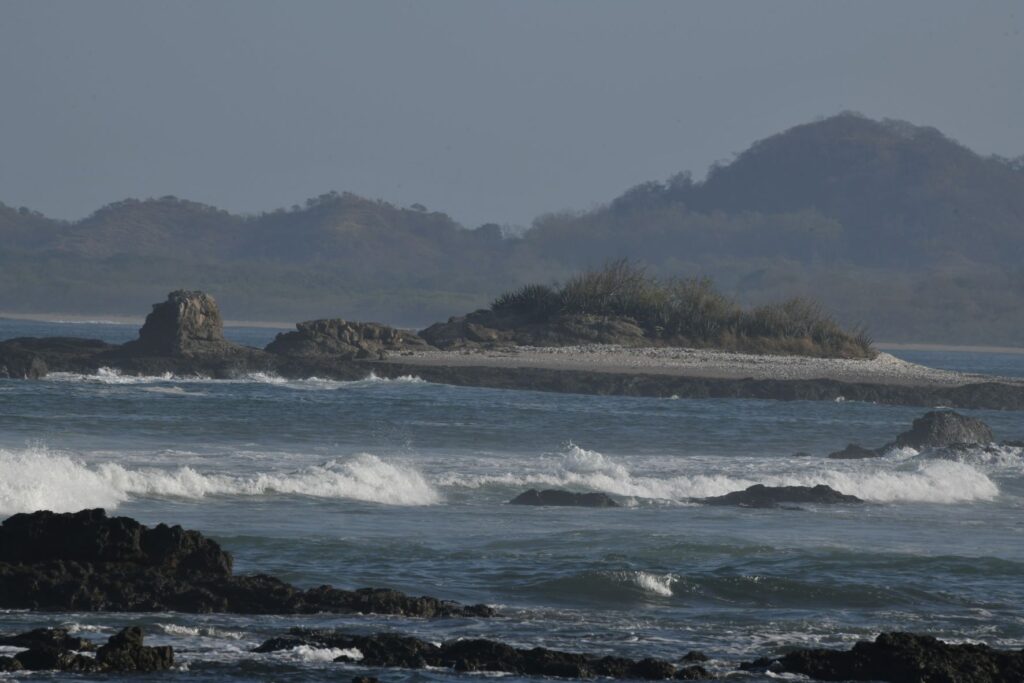
Playa Tamarindo was a convenient place to decompress before going home; an easy 50-minute drive to the Daniel Oduber Quinos International Airport in Liberia. Although the birding around town wasn’t nearly as productive as Samara, it was still Spring migration and interesting migrants could appear on any given day. Additionally, there were other forms of amusement. One of the best surf breaks in Costa Rica was just a five minute walk from the lodge in town. The surf conditions were generally fair, especially for a longboarder and , compared with my home break in Malibu, CA, uncrowded most days (0.5 – 1 m). A good selection of rental boards was available on the beach and throughout the town.
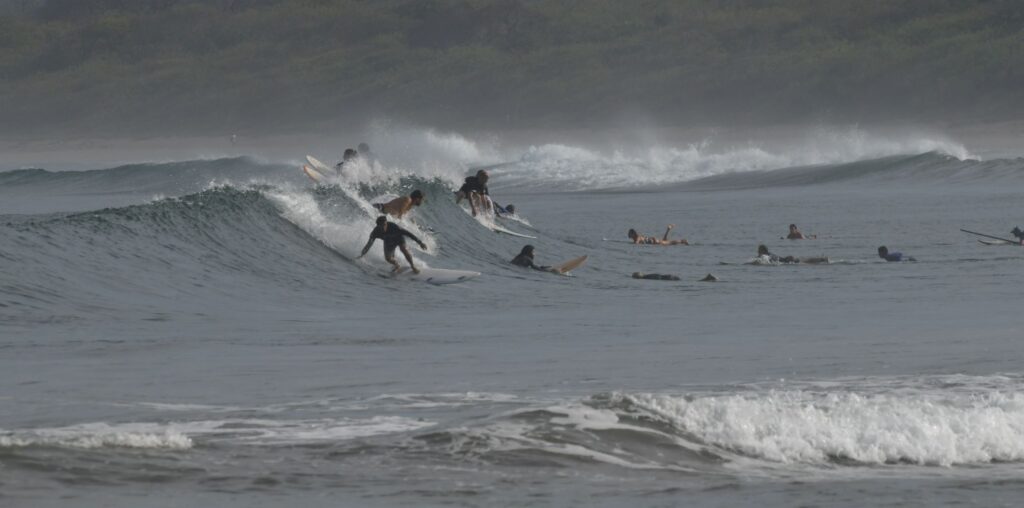
When I arrived in Tamarindo, it was quite warm (32C). Parades of college coeds in skimpy swimsuits toted their surfboards; they looked like a scaled- up version of leaf cutter ants I had photographed in Danta Corcovado. After some searching on the back streets, I located the Ten North Lodge, tucked away in a narrow alley next to a skateboard park. My second-level room was small, though clean and had a powerful air conditioner. The lodge was completely full. Good thing I had a reservation. Evidently, Spring Break was in full swing in Tamarindo, regardless of a pandemic. Except for the police, who stood at nearly every street corner, few people wore face coverings. It was as if Tamarindo had its own opinion and apparently its own facts about COVID-19. This was a party town and that’s pretty much all folks here cared about.
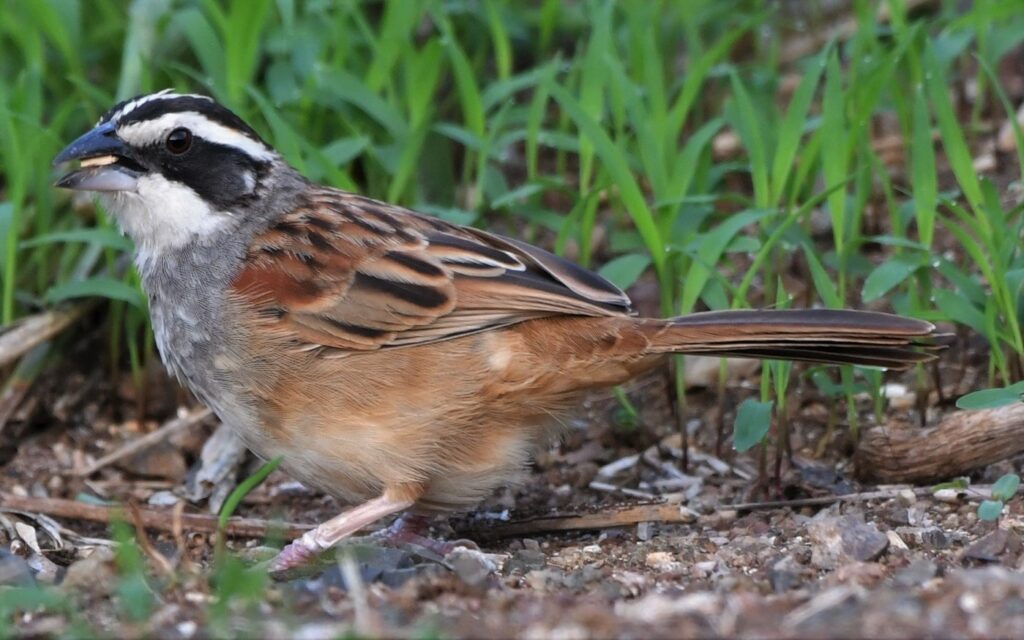
Birding around town was best early in the morning before the party animals awoke and began stumbling onto to the beach. I checked rows of flowering trees and shrubs lining the main street, then moved to the shore. Surprisingly, a few shorebirds managed to find foraging opportunities at the tideline and among the rocks at low tide. All objects, whether natural or artificial, including discarded plastic cups, bags, beercans, fast food containers and even whole coconuts, were carefully inspected for possible food value. Most of the shorebirds would be continuing on their journey northward and be absent from this area within the following two weeks. Playa Tamarindo, like Puerto Jimenez and Playa Samara, was another in a series of rest and refueling stations along the Pacific Flyway.

Further south on the beach, some cliffs supported patches of tropical dry forest, the dominant natural vegetation community in the Guanacaste province. A rash of newly built condominiums with ornamental shrubs and native trees lined the scenic cliffs. Those places sometimes produced a few birds for my local list.
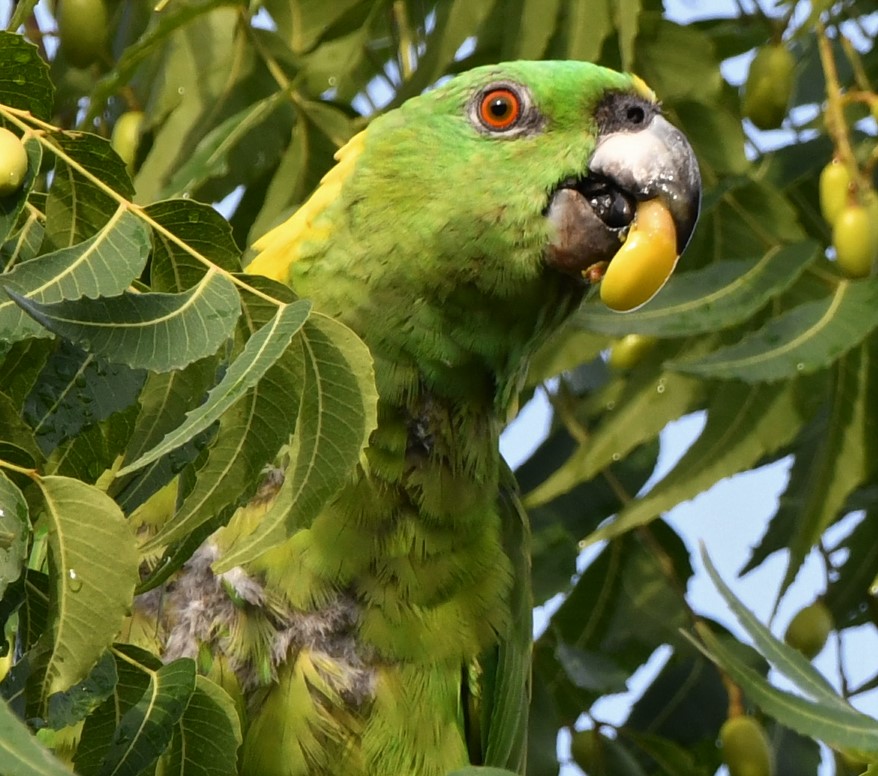
As far as I could tell, Playa Tamarindo birds represented nearly all the same taxa as those I had already encountered elsewhere, e.g. Hacienda Guachipelin, Samara and Peninsula de Osa. Four new bird species I found in Tamarindo were added to my Costa Rica trip list: Gull-billed Tern, Neotropic Cormorant, Yellow-naped Parrot (endangered as a result of the illegal pet trade), and delightfully suprising, a migrating flock of Eastern Kingbird – a species that had apparently flown under the local eBird radar.

Playa Tamarindo Annotated Bird List (20-25 April, 2021) Callyn Yorke
Explanation of Symbols
Abundance: Numbers following each species represent the maximum number of individuals found during a survey.
Frequency: C = Commonly found (or expected to be found) during all or most surveys; FC = Fairly commonly found on about half of the surveys; UC = Uncommonly found in less than half of the surveys; R = Rarely found; i.e. only once during the surveys.
Locations: TAM = Tamarindo town, gardens, vacant lots, shade trees, campgrounds; PTS = Playa Tamarindo, shoreline, tidepools and nearshore waters; TCL = Playa Tamarindo cliffs and adjacent dry forest, scrub and second-growth, ornamental flowering shrubs, lawns, gardens.
Systematics and Nomenclature follows Avibase and Clements (2021)
- Feral Rock Pigeon Columba livia 12 gregarious, TAM, C
- Inca Dove Columbina inca 8 gregarious, TAM, TCL, C
- White-winged Dove Zenaida asiatica 15 TAM, C
- Cinnamon Hummingbird Amazilia tzacatl 1 TAM, R
- Semipalmated Plover Charadrius semipalmatus 1 (alt. plmg.) , PTS, FC
- Ruddy Turnstone Arenaria interpres 5 (alt. plmg.) PTS, C
- Sanderling Calidris alba 1 (bsc. plmg.), PTS, R
- Spotted Sandpiper Actitis macularius 5 (alt. plmg. on shore and in tidepool rocks, PTS, C
- Least Sandpiper Calidris minutilla (bsc. plmg.) 8 gregarious, PTS, C
- Gull-billed Tern Gelochelidon nilotica 4 diving in nearshore waters, PTS, UC
- Royal Tern Thalasseus maximus 5 flying over nearshore waters, C
- Cabot’s Tern Thalasseus acuflavidus 1 flying over nearshore waters, R
- Magnificent Frigatebird Fregata magnificens 3 loosely gregarious flying over nearshore waters, C
- Neotropic Cormorant Nannopterum brasilianus 1 on small island offshore, PTS, R
- Brown Pelican Pelecanus occidentalis 4 on small island offshore; flying over nearshore waters, PTS, UC
- Tricolored Heron Egretta tricolor 1 flying over town, TAM, R
- White Ibis Eudocimus albus 5 gregarious, flying over shore, PTS, R
- Black Vulture Coragyps atratus 25 gregarious, foraging on garbage in town, TAM, C
- Turkey Vulure Cathartes aura 5 gregarious, flying over town and cliffs, TAM, PTS, FC
- Common Black Hawk Buteogallus anthracinus 1 perched in tree over cliff, TCL, R
- Turquoise-browed Motmot Eumomota superciliosa 1 on a low branch in a garden tree, TCL, R
- Hoffmann’s Woodpecker Melanerpes hoffmannii 3 vocal, active in large trees, TAM, TCL
- Orange-chinned Parakeet Brotogeris jugularis 8 gregarious, vocal, in large flowering trees, TAM, TCL, C
- Yellow-naped Parrot Amazona auropalliata 2 consuming yellow fruits in the canopy of a garden tree, TAM, R
- Scarlet Macaw Ara macao 2 flying over garden trees, TAM, UC
- Rose-throated Becard Pachyramphus aglaiae 1 in subcanopy of large tree, TAM, R
- Great Kiskadee Pitangus sulphuratus 6 vocal, on utility wires, in large trees, TAM, TCL, C
- Social Flycatcher Myiozetetes similis 9 vocal, gregarious, at edge of second-growth, gardens, utitlity wires, TAM, TCL, C
- Tropical Kingbird Tyrannus melancholicus 5 on utility wires, garden trees, TAM, TCL, C
- Eastern Kingbird Tyrannus tyrannus 25 gregarious, alighting in garden trees, TCL, R
- Yellow-green Vireo Vireo flavoviridis 4 in a wide variety of large trees, TAM, TCL, C
- White-throated Magpie-Jay Calocitta formosa 2 in garden trees, TCL, UC
- Southern Rough-winged Swallow Stelgidopteryx ruficollis 2 flying over open area, TCL, R
- Gray-breasted Martin Progne chalybea 4 gregarious, flying over rooftops, TAM, FC
- Mangrove Swallow Tachycineta albilinea 2 flying low over shore and adjacent backwater area, PTS, FC
- Barn Swallow Hirundo rustica 2 lying low over shore, PTS, FC
- White-lored Gnatcatcher Polioptila albiloris 1 n in subcanopy of woodland, TCL, R
- Rufous-naped Wren Campylorhynchus rufinucha 5 vocal, gregarious in gardens, TAM, C
- Banded Wren Thryophilus pleurostictus 1 staying low in second-growth, TCL, R
- Clay-colored Thrush Turdus grayi 5 gregarious on ground in shady gardens and vacant lots, TAM, C
- Stripe-headed Sparrow Peucaea ruficauda 3 on ground and in shrubs and trees in vacant lot, TAM, UC
- Streak-backed Oriole Icterus pustulatus 4 pairs in flowering garden trees, TAM, FC
- Bronzed Cowbird Molothrus aeneus 1 (f) on ground with MEBL in vacant lot, TAM, UC
- Melodius Blackbird Dives dives 10 (m,f) vocal, gregarious, in gardens and in vacant lots, TAM, C
- Great-tailed Grackle Quiscalus mexicanus 16 (m,f) vocal, gregarious, ubiquitous, C
- Yellow Warbler Setophaga petechia 4 (m,f) in a variety of large trees, TAM, TCL, C
- Blue-gray Tanager Thraupis episcopus 3 in canopy of a variety of trees, TAM, TCL, C
______________________
